The Treatment of Anorexia Nervosa in Adolescents: Parental Viewpoint
VerifiedAdded on 2021/02/20
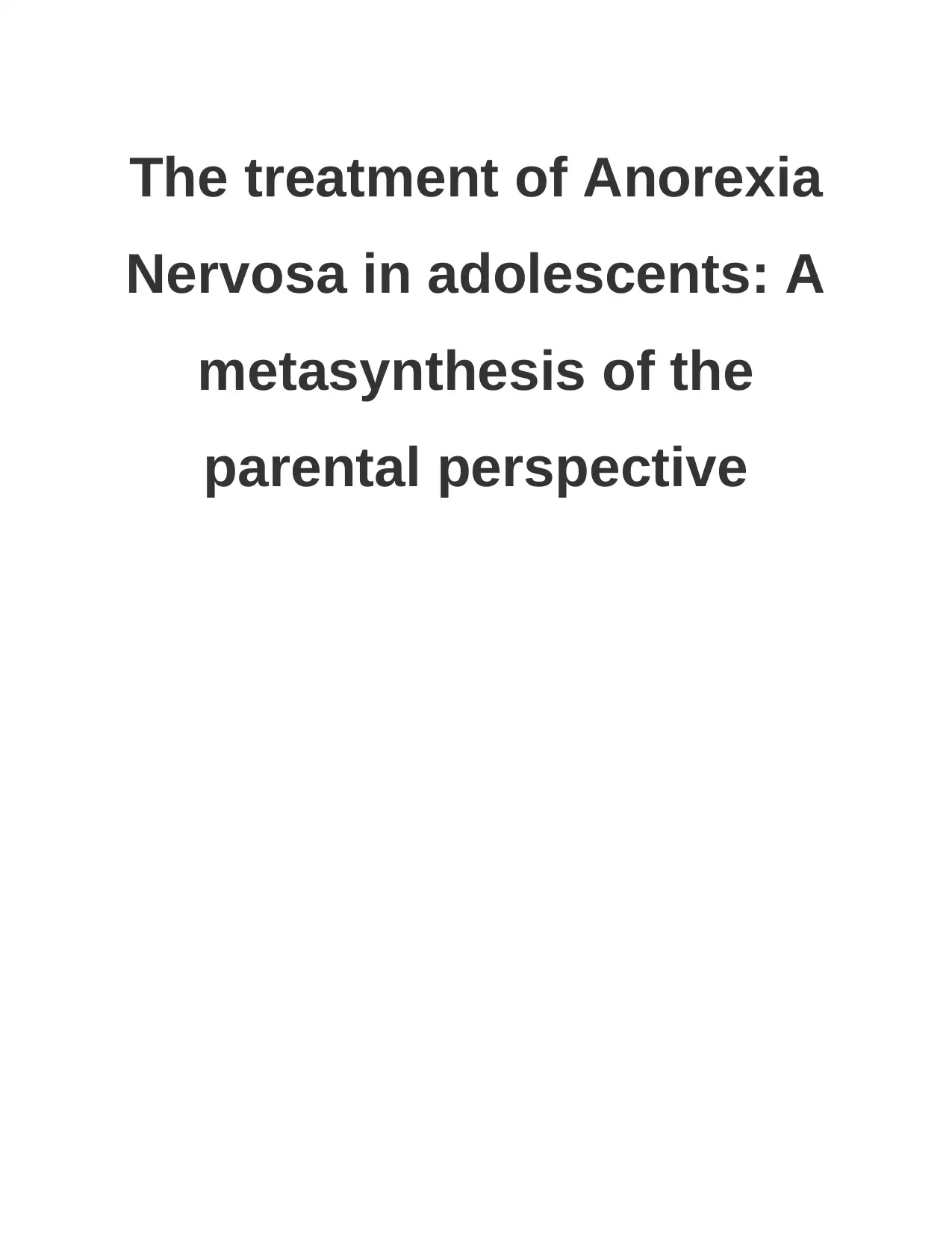
Nervosa in adolescents: A
metasynthesis of the
parental perspective
Paraphrase This Document
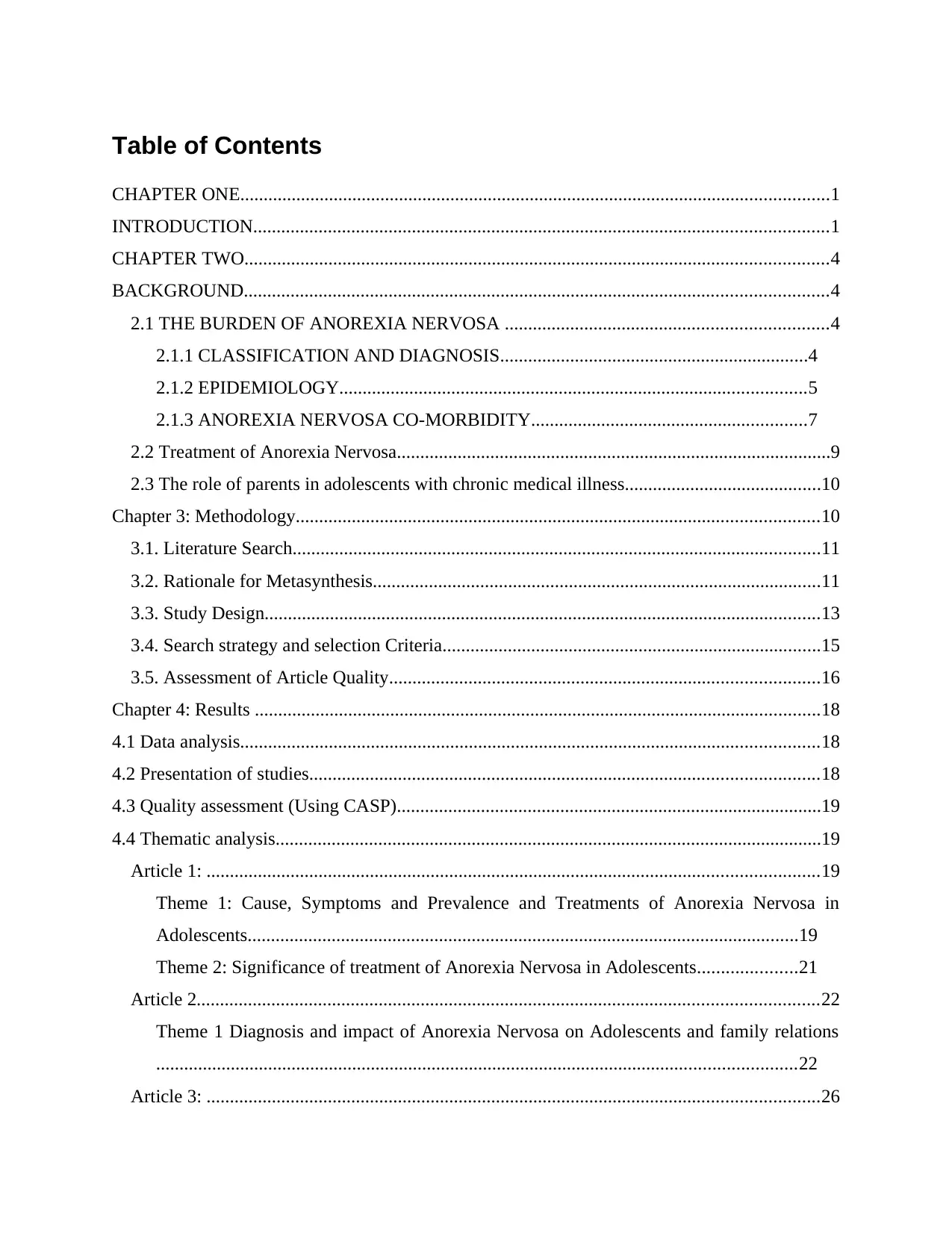
CHAPTER ONE..............................................................................................................................1
INTRODUCTION...........................................................................................................................1
CHAPTER TWO.............................................................................................................................4
BACKGROUND.............................................................................................................................4
2.1 THE BURDEN OF ANOREXIA NERVOSA .....................................................................4
2.1.1 CLASSIFICATION AND DIAGNOSIS..................................................................4
2.1.2 EPIDEMIOLOGY....................................................................................................5
2.1.3 ANOREXIA NERVOSA CO-MORBIDITY...........................................................7
2.2 Treatment of Anorexia Nervosa.............................................................................................9
2.3 The role of parents in adolescents with chronic medical illness..........................................10
Chapter 3: Methodology................................................................................................................10
3.1. Literature Search.................................................................................................................11
3.2. Rationale for Metasynthesis................................................................................................11
3.3. Study Design.......................................................................................................................13
3.4. Search strategy and selection Criteria.................................................................................15
3.5. Assessment of Article Quality............................................................................................16
Chapter 4: Results .........................................................................................................................18
4.1 Data analysis............................................................................................................................18
4.2 Presentation of studies.............................................................................................................18
4.3 Quality assessment (Using CASP)...........................................................................................19
4.4 Thematic analysis.....................................................................................................................19
Article 1: ...................................................................................................................................19
Theme 1: Cause, Symptoms and Prevalence and Treatments of Anorexia Nervosa in
Adolescents......................................................................................................................19
Theme 2: Significance of treatment of Anorexia Nervosa in Adolescents.....................21
Article 2.....................................................................................................................................22
Theme 1 Diagnosis and impact of Anorexia Nervosa on Adolescents and family relations
.........................................................................................................................................22
Article 3: ...................................................................................................................................26
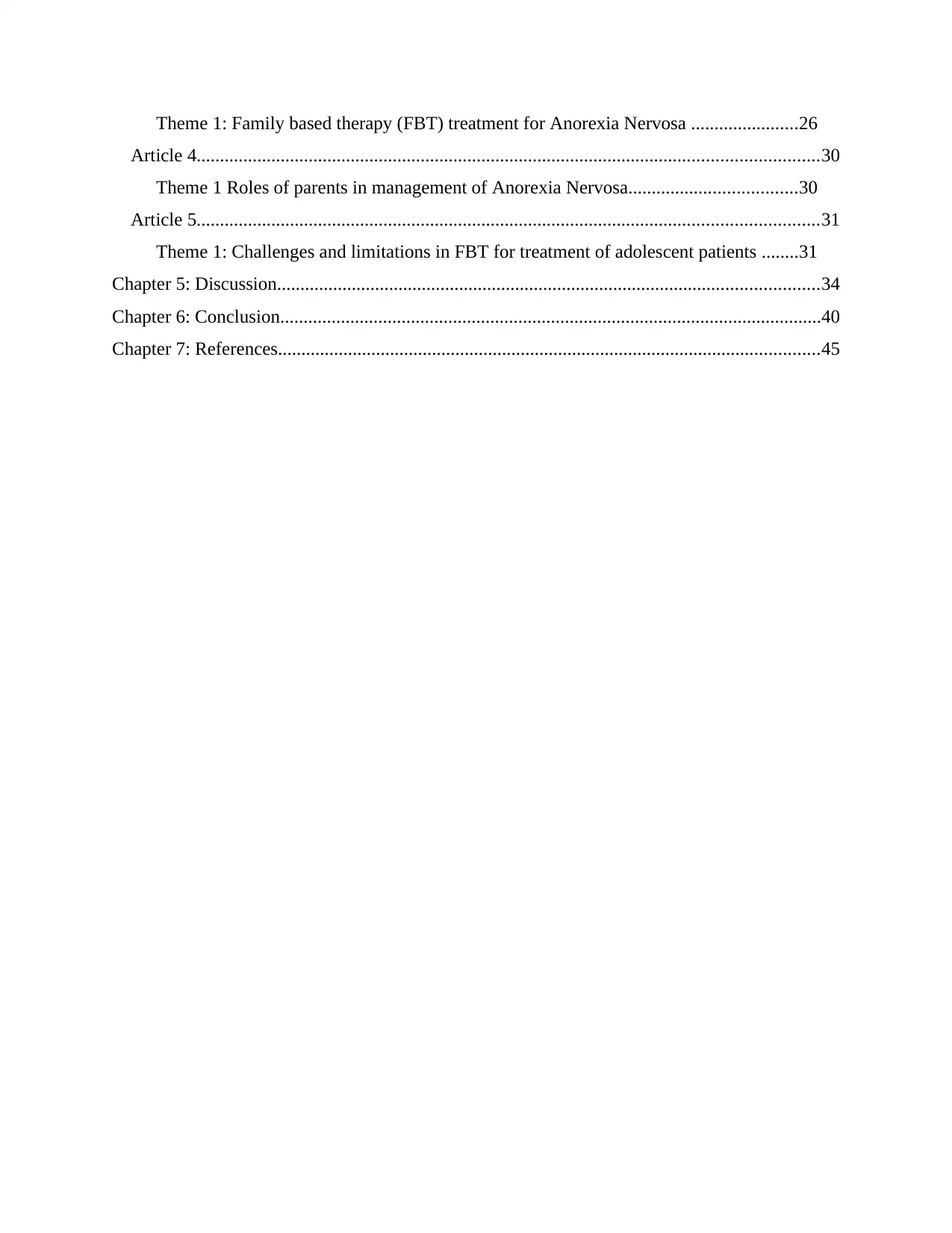
Article 4.....................................................................................................................................30
Theme 1 Roles of parents in management of Anorexia Nervosa....................................30
Article 5.....................................................................................................................................31
Theme 1: Challenges and limitations in FBT for treatment of adolescent patients ........31
Chapter 5: Discussion....................................................................................................................34
Chapter 6: Conclusion....................................................................................................................40
Chapter 7: References....................................................................................................................45
⊘ This is a preview!⊘
Do you want full access?
Subscribe today to unlock all pages.

Trusted by 1+ million students worldwide
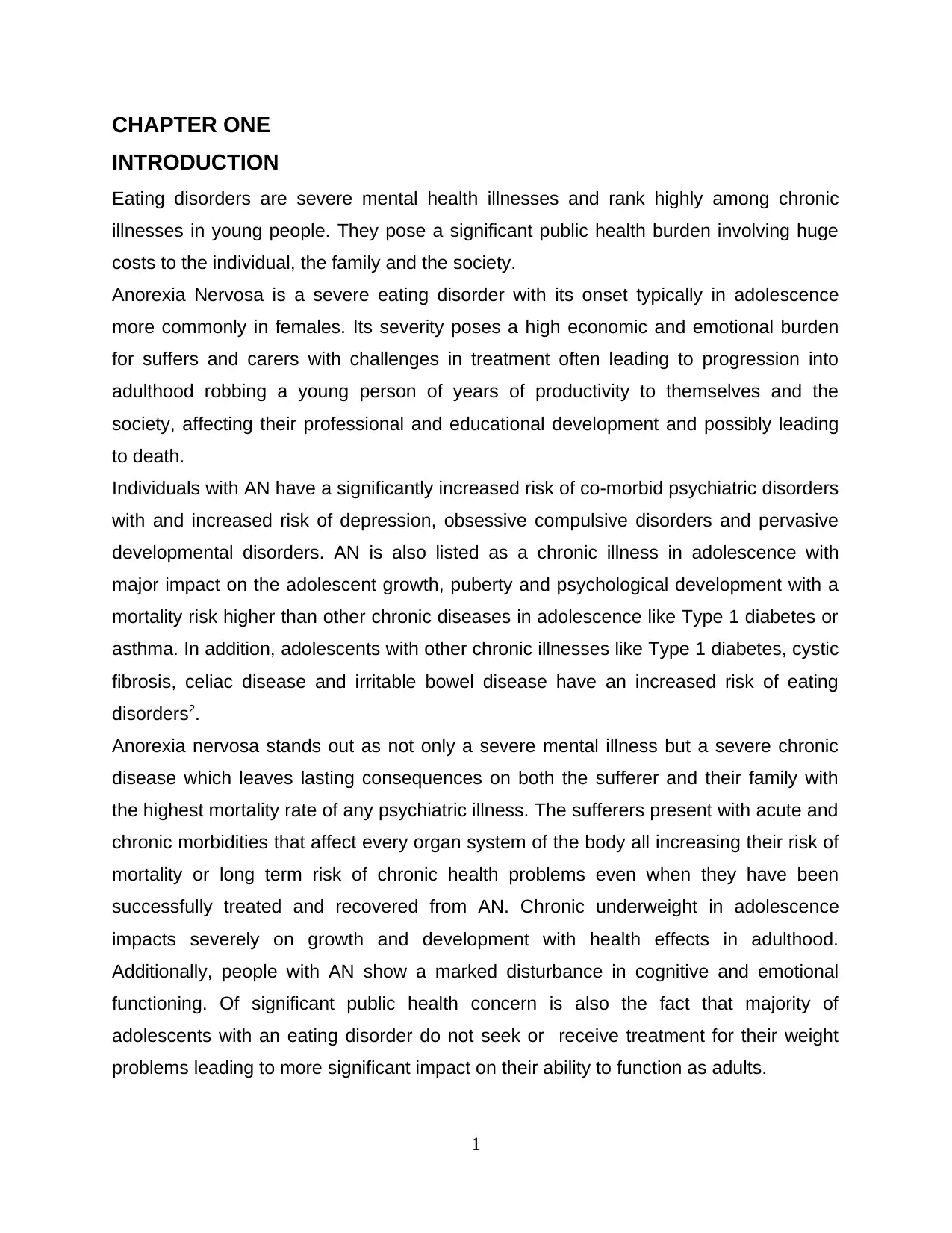
INTRODUCTION
Eating disorders are severe mental health illnesses and rank highly among chronic
illnesses in young people. They pose a significant public health burden involving huge
costs to the individual, the family and the society.
Anorexia Nervosa is a severe eating disorder with its onset typically in adolescence
more commonly in females. Its severity poses a high economic and emotional burden
for suffers and carers with challenges in treatment often leading to progression into
adulthood robbing a young person of years of productivity to themselves and the
society, affecting their professional and educational development and possibly leading
to death.
Individuals with AN have a significantly increased risk of co-morbid psychiatric disorders
with and increased risk of depression, obsessive compulsive disorders and pervasive
developmental disorders. AN is also listed as a chronic illness in adolescence with
major impact on the adolescent growth, puberty and psychological development with a
mortality risk higher than other chronic diseases in adolescence like Type 1 diabetes or
asthma. In addition, adolescents with other chronic illnesses like Type 1 diabetes, cystic
fibrosis, celiac disease and irritable bowel disease have an increased risk of eating
disorders2.
Anorexia nervosa stands out as not only a severe mental illness but a severe chronic
disease which leaves lasting consequences on both the sufferer and their family with
the highest mortality rate of any psychiatric illness. The sufferers present with acute and
chronic morbidities that affect every organ system of the body all increasing their risk of
mortality or long term risk of chronic health problems even when they have been
successfully treated and recovered from AN. Chronic underweight in adolescence
impacts severely on growth and development with health effects in adulthood.
Additionally, people with AN show a marked disturbance in cognitive and emotional
functioning. Of significant public health concern is also the fact that majority of
adolescents with an eating disorder do not seek or receive treatment for their weight
problems leading to more significant impact on their ability to function as adults.
1
Paraphrase This Document
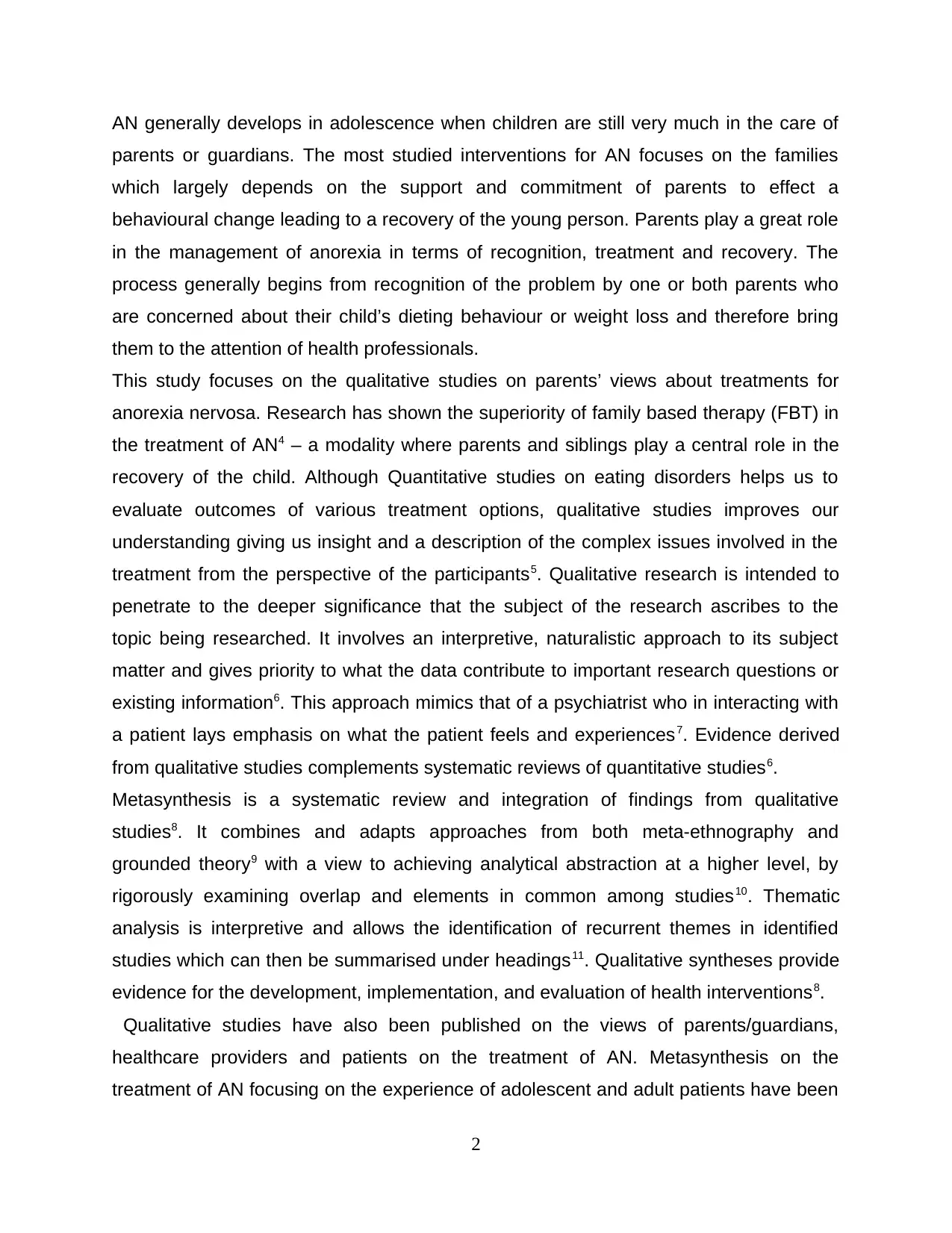
parents or guardians. The most studied interventions for AN focuses on the families
which largely depends on the support and commitment of parents to effect a
behavioural change leading to a recovery of the young person. Parents play a great role
in the management of anorexia in terms of recognition, treatment and recovery. The
process generally begins from recognition of the problem by one or both parents who
are concerned about their child’s dieting behaviour or weight loss and therefore bring
them to the attention of health professionals.
This study focuses on the qualitative studies on parents’ views about treatments for
anorexia nervosa. Research has shown the superiority of family based therapy (FBT) in
the treatment of AN4 – a modality where parents and siblings play a central role in the
recovery of the child. Although Quantitative studies on eating disorders helps us to
evaluate outcomes of various treatment options, qualitative studies improves our
understanding giving us insight and a description of the complex issues involved in the
treatment from the perspective of the participants5. Qualitative research is intended to
penetrate to the deeper significance that the subject of the research ascribes to the
topic being researched. It involves an interpretive, naturalistic approach to its subject
matter and gives priority to what the data contribute to important research questions or
existing information6. This approach mimics that of a psychiatrist who in interacting with
a patient lays emphasis on what the patient feels and experiences7. Evidence derived
from qualitative studies complements systematic reviews of quantitative studies6.
Metasynthesis is a systematic review and integration of findings from qualitative
studies8. It combines and adapts approaches from both meta-ethnography and
grounded theory9 with a view to achieving analytical abstraction at a higher level, by
rigorously examining overlap and elements in common among studies10. Thematic
analysis is interpretive and allows the identification of recurrent themes in identified
studies which can then be summarised under headings11. Qualitative syntheses provide
evidence for the development, implementation, and evaluation of health interventions8.
Qualitative studies have also been published on the views of parents/guardians,
healthcare providers and patients on the treatment of AN. Metasynthesis on the
treatment of AN focusing on the experience of adolescent and adult patients have been
2
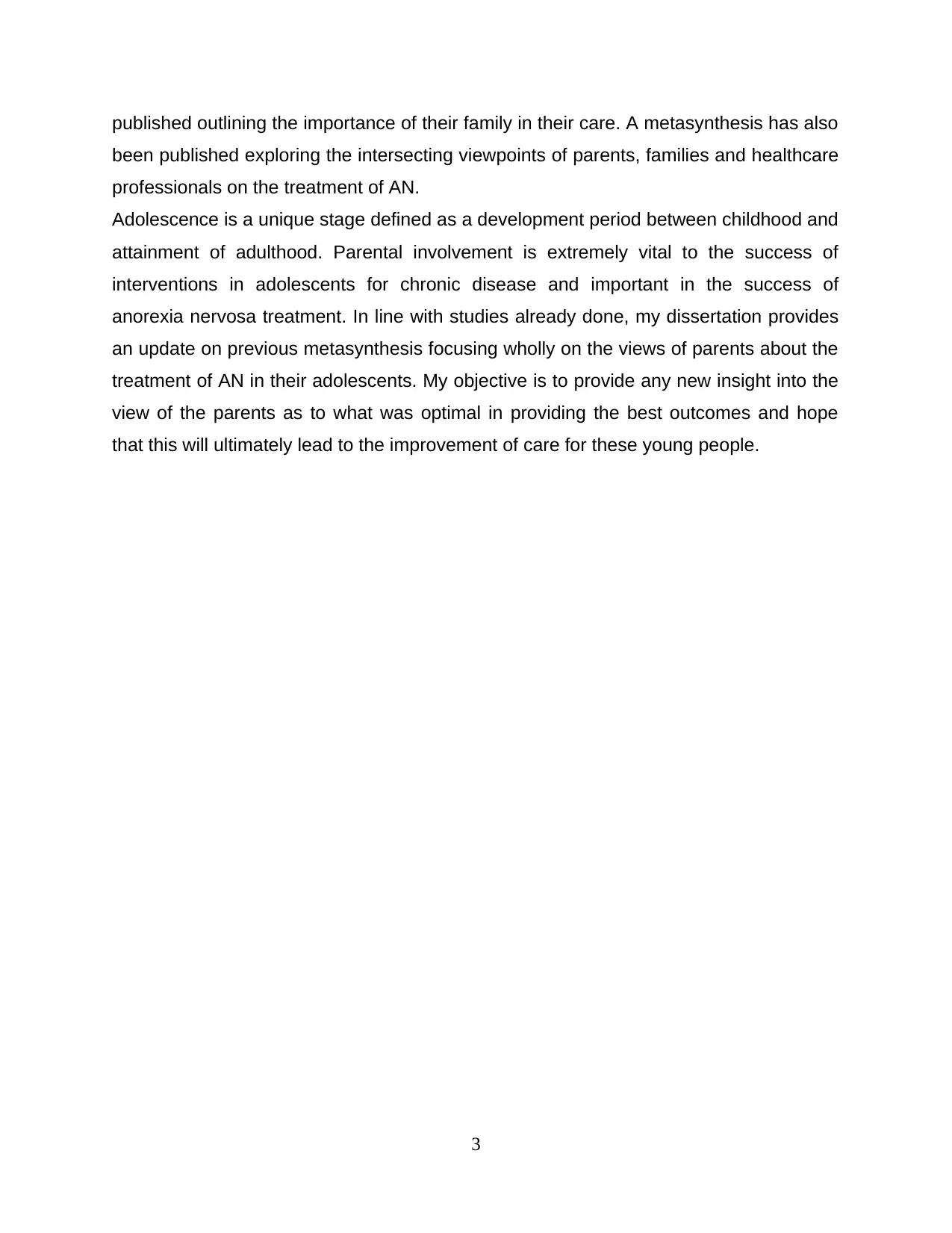
been published exploring the intersecting viewpoints of parents, families and healthcare
professionals on the treatment of AN.
Adolescence is a unique stage defined as a development period between childhood and
attainment of adulthood. Parental involvement is extremely vital to the success of
interventions in adolescents for chronic disease and important in the success of
anorexia nervosa treatment. In line with studies already done, my dissertation provides
an update on previous metasynthesis focusing wholly on the views of parents about the
treatment of AN in their adolescents. My objective is to provide any new insight into the
view of the parents as to what was optimal in providing the best outcomes and hope
that this will ultimately lead to the improvement of care for these young people.
3
⊘ This is a preview!⊘
Do you want full access?
Subscribe today to unlock all pages.

Trusted by 1+ million students worldwide
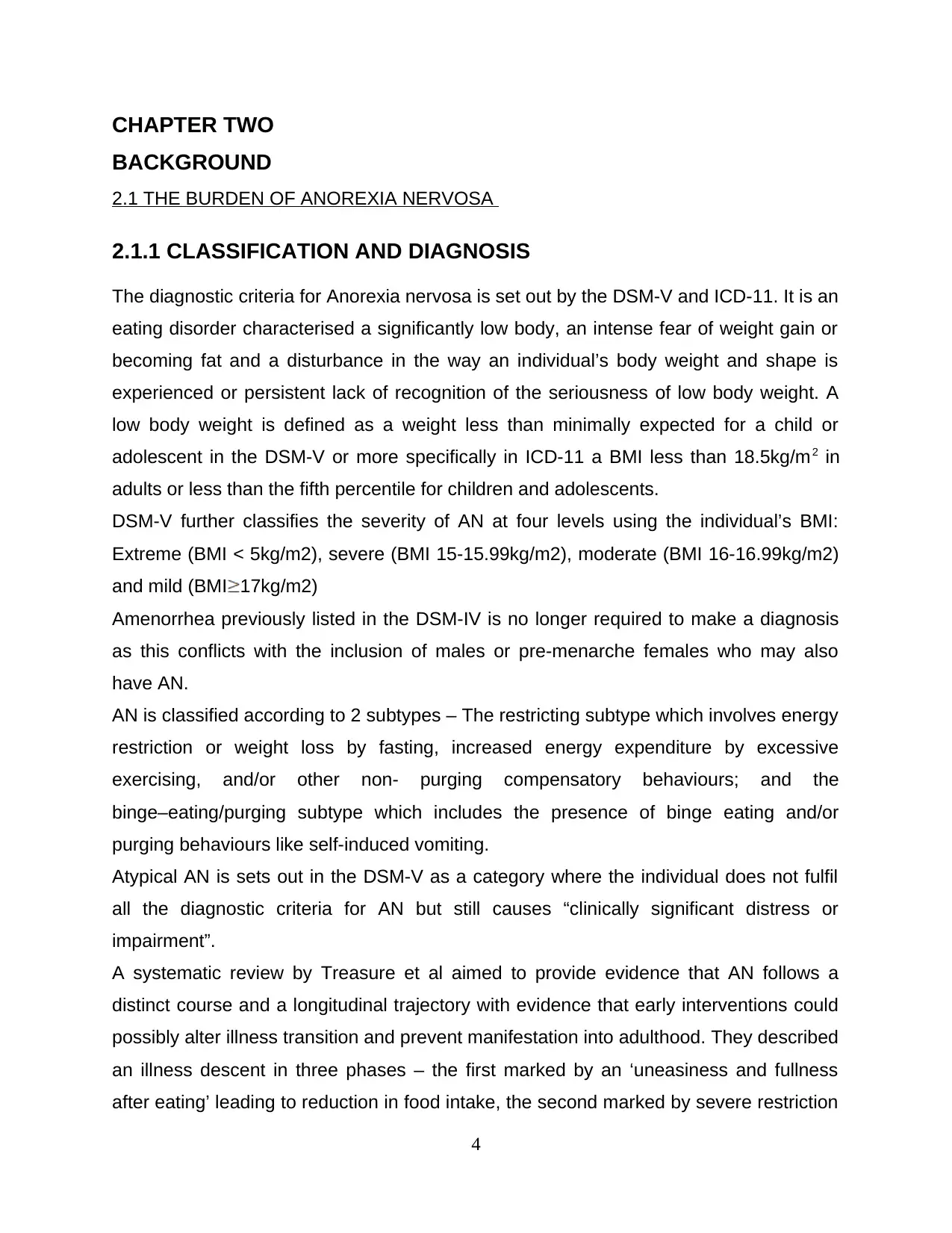
BACKGROUND
2.1 THE BURDEN OF ANOREXIA NERVOSA
2.1.1 CLASSIFICATION AND DIAGNOSIS
The diagnostic criteria for Anorexia nervosa is set out by the DSM-V and ICD-11. It is an
eating disorder characterised a significantly low body, an intense fear of weight gain or
becoming fat and a disturbance in the way an individual’s body weight and shape is
experienced or persistent lack of recognition of the seriousness of low body weight. A
low body weight is defined as a weight less than minimally expected for a child or
adolescent in the DSM-V or more specifically in ICD-11 a BMI less than 18.5kg/m2 in
adults or less than the fifth percentile for children and adolescents.
DSM-V further classifies the severity of AN at four levels using the individual’s BMI:
Extreme (BMI < 5kg/m2), severe (BMI 15-15.99kg/m2), moderate (BMI 16-16.99kg/m2)
and mild (BMI 17kg/m2)
Amenorrhea previously listed in the DSM-IV is no longer required to make a diagnosis
as this conflicts with the inclusion of males or pre-menarche females who may also
have AN.
AN is classified according to 2 subtypes – The restricting subtype which involves energy
restriction or weight loss by fasting, increased energy expenditure by excessive
exercising, and/or other non- purging compensatory behaviours; and the
binge–eating/purging subtype which includes the presence of binge eating and/or
purging behaviours like self-induced vomiting.
Atypical AN is sets out in the DSM-V as a category where the individual does not fulfil
all the diagnostic criteria for AN but still causes “clinically significant distress or
impairment”.
A systematic review by Treasure et al aimed to provide evidence that AN follows a
distinct course and a longitudinal trajectory with evidence that early interventions could
possibly alter illness transition and prevent manifestation into adulthood. They described
an illness descent in three phases – the first marked by an ‘uneasiness and fullness
after eating’ leading to reduction in food intake, the second marked by severe restriction
4
Paraphrase This Document
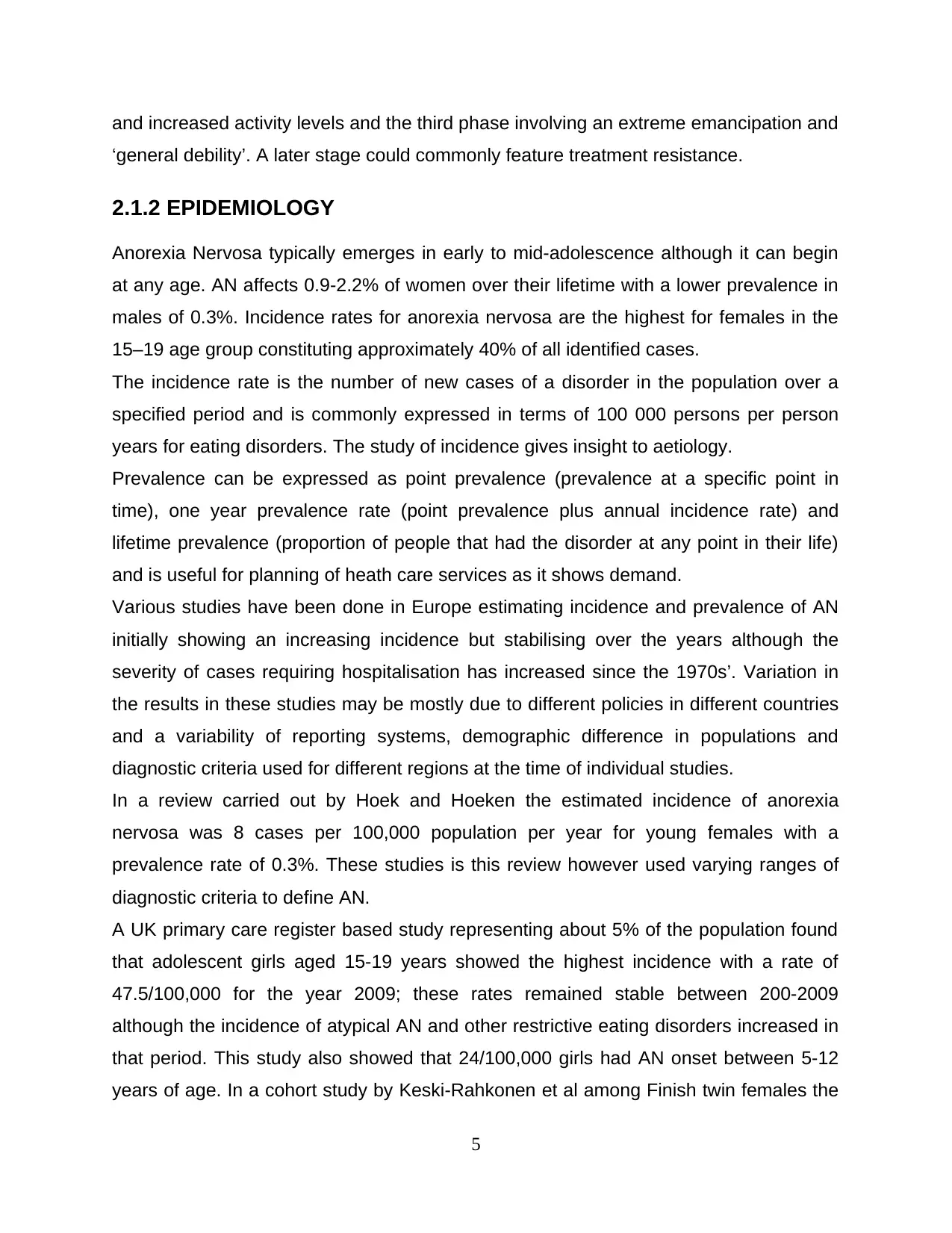
‘general debility’. A later stage could commonly feature treatment resistance.
2.1.2 EPIDEMIOLOGY
Anorexia Nervosa typically emerges in early to mid-adolescence although it can begin
at any age. AN affects 0.9-2.2% of women over their lifetime with a lower prevalence in
males of 0.3%. Incidence rates for anorexia nervosa are the highest for females in the
15–19 age group constituting approximately 40% of all identified cases.
The incidence rate is the number of new cases of a disorder in the population over a
specified period and is commonly expressed in terms of 100 000 persons per person
years for eating disorders. The study of incidence gives insight to aetiology.
Prevalence can be expressed as point prevalence (prevalence at a specific point in
time), one year prevalence rate (point prevalence plus annual incidence rate) and
lifetime prevalence (proportion of people that had the disorder at any point in their life)
and is useful for planning of heath care services as it shows demand.
Various studies have been done in Europe estimating incidence and prevalence of AN
initially showing an increasing incidence but stabilising over the years although the
severity of cases requiring hospitalisation has increased since the 1970s’. Variation in
the results in these studies may be mostly due to different policies in different countries
and a variability of reporting systems, demographic difference in populations and
diagnostic criteria used for different regions at the time of individual studies.
In a review carried out by Hoek and Hoeken the estimated incidence of anorexia
nervosa was 8 cases per 100,000 population per year for young females with a
prevalence rate of 0.3%. These studies is this review however used varying ranges of
diagnostic criteria to define AN.
A UK primary care register based study representing about 5% of the population found
that adolescent girls aged 15-19 years showed the highest incidence with a rate of
47.5/100,000 for the year 2009; these rates remained stable between 200-2009
although the incidence of atypical AN and other restrictive eating disorders increased in
that period. This study also showed that 24/100,000 girls had AN onset between 5-12
years of age. In a cohort study by Keski-Rahkonen et al among Finish twin females the
5
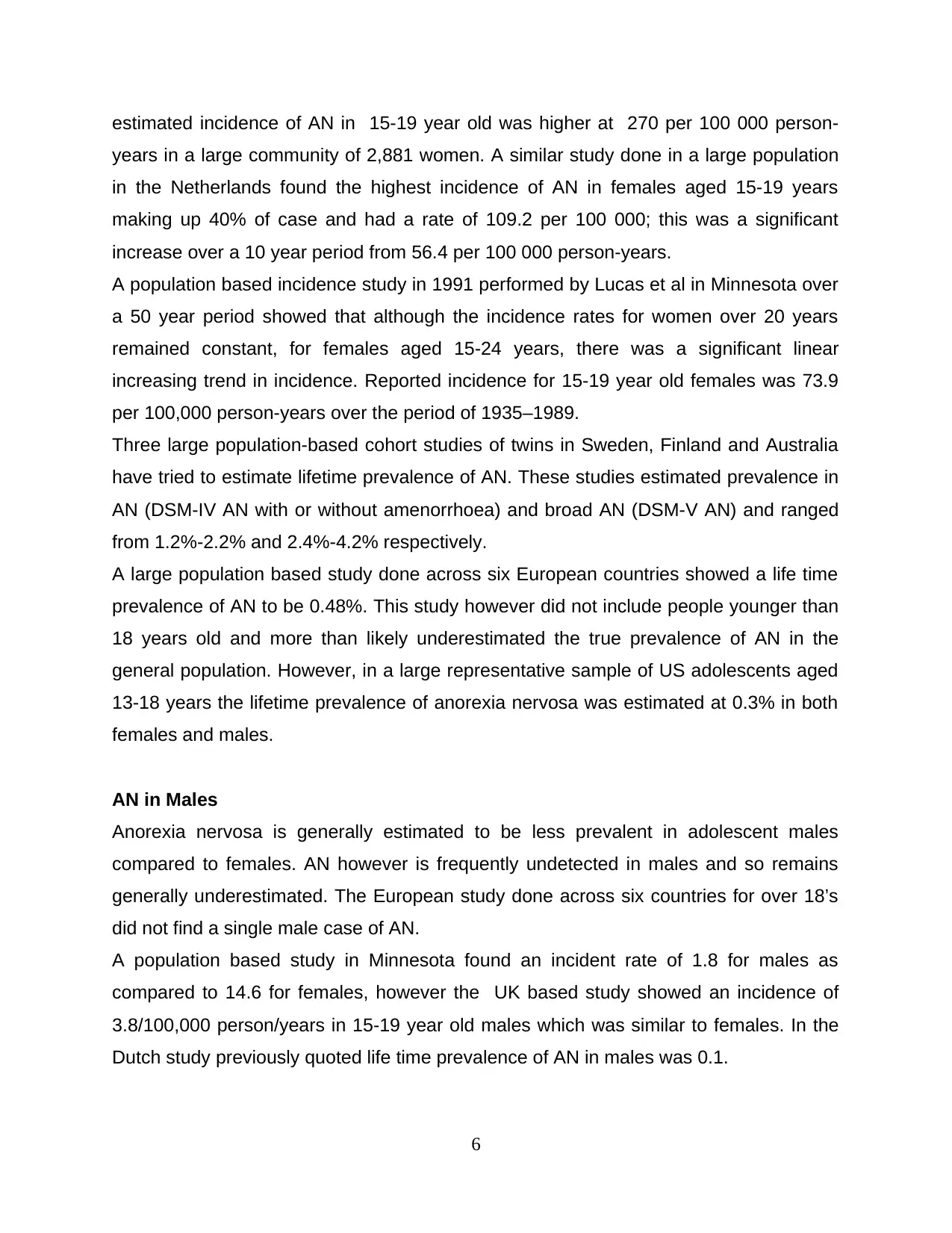
years in a large community of 2,881 women. A similar study done in a large population
in the Netherlands found the highest incidence of AN in females aged 15-19 years
making up 40% of case and had a rate of 109.2 per 100 000; this was a significant
increase over a 10 year period from 56.4 per 100 000 person-years.
A population based incidence study in 1991 performed by Lucas et al in Minnesota over
a 50 year period showed that although the incidence rates for women over 20 years
remained constant, for females aged 15-24 years, there was a significant linear
increasing trend in incidence. Reported incidence for 15-19 year old females was 73.9
per 100,000 person-years over the period of 1935–1989.
Three large population-based cohort studies of twins in Sweden, Finland and Australia
have tried to estimate lifetime prevalence of AN. These studies estimated prevalence in
AN (DSM-IV AN with or without amenorrhoea) and broad AN (DSM-V AN) and ranged
from 1.2%-2.2% and 2.4%-4.2% respectively.
A large population based study done across six European countries showed a life time
prevalence of AN to be 0.48%. This study however did not include people younger than
18 years old and more than likely underestimated the true prevalence of AN in the
general population. However, in a large representative sample of US adolescents aged
13-18 years the lifetime prevalence of anorexia nervosa was estimated at 0.3% in both
females and males.
AN in Males
Anorexia nervosa is generally estimated to be less prevalent in adolescent males
compared to females. AN however is frequently undetected in males and so remains
generally underestimated. The European study done across six countries for over 18’s
did not find a single male case of AN.
A population based study in Minnesota found an incident rate of 1.8 for males as
compared to 14.6 for females, however the UK based study showed an incidence of
3.8/100,000 person/years in 15-19 year old males which was similar to females. In the
Dutch study previously quoted life time prevalence of AN in males was 0.1.
6
⊘ This is a preview!⊘
Do you want full access?
Subscribe today to unlock all pages.

Trusted by 1+ million students worldwide
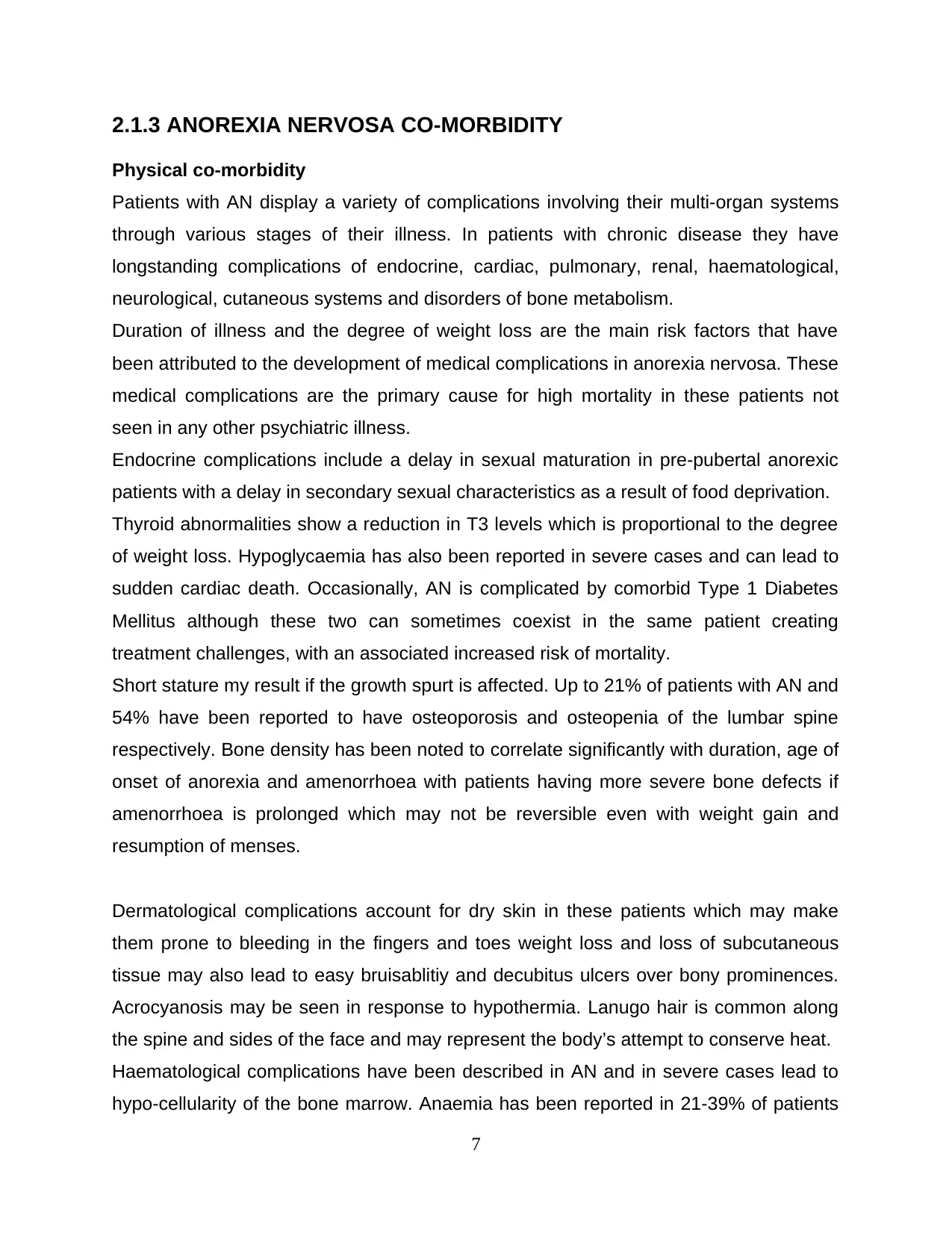
Physical co-morbidity
Patients with AN display a variety of complications involving their multi-organ systems
through various stages of their illness. In patients with chronic disease they have
longstanding complications of endocrine, cardiac, pulmonary, renal, haematological,
neurological, cutaneous systems and disorders of bone metabolism.
Duration of illness and the degree of weight loss are the main risk factors that have
been attributed to the development of medical complications in anorexia nervosa. These
medical complications are the primary cause for high mortality in these patients not
seen in any other psychiatric illness.
Endocrine complications include a delay in sexual maturation in pre‐pubertal anorexic
patients with a delay in secondary sexual characteristics as a result of food deprivation.
Thyroid abnormalities show a reduction in T3 levels which is proportional to the degree
of weight loss. Hypoglycaemia has also been reported in severe cases and can lead to
sudden cardiac death. Occasionally, AN is complicated by comorbid Type 1 Diabetes
Mellitus although these two can sometimes coexist in the same patient creating
treatment challenges, with an associated increased risk of mortality.
Short stature my result if the growth spurt is affected. Up to 21% of patients with AN and
54% have been reported to have osteoporosis and osteopenia of the lumbar spine
respectively. Bone density has been noted to correlate significantly with duration, age of
onset of anorexia and amenorrhoea with patients having more severe bone defects if
amenorrhoea is prolonged which may not be reversible even with weight gain and
resumption of menses.
Dermatological complications account for dry skin in these patients which may make
them prone to bleeding in the fingers and toes weight loss and loss of subcutaneous
tissue may also lead to easy bruisablitiy and decubitus ulcers over bony prominences.
Acrocyanosis may be seen in response to hypothermia. Lanugo hair is common along
the spine and sides of the face and may represent the body’s attempt to conserve heat.
Haematological complications have been described in AN and in severe cases lead to
hypo-cellularity of the bone marrow. Anaemia has been reported in 21-39% of patients
7
Paraphrase This Document
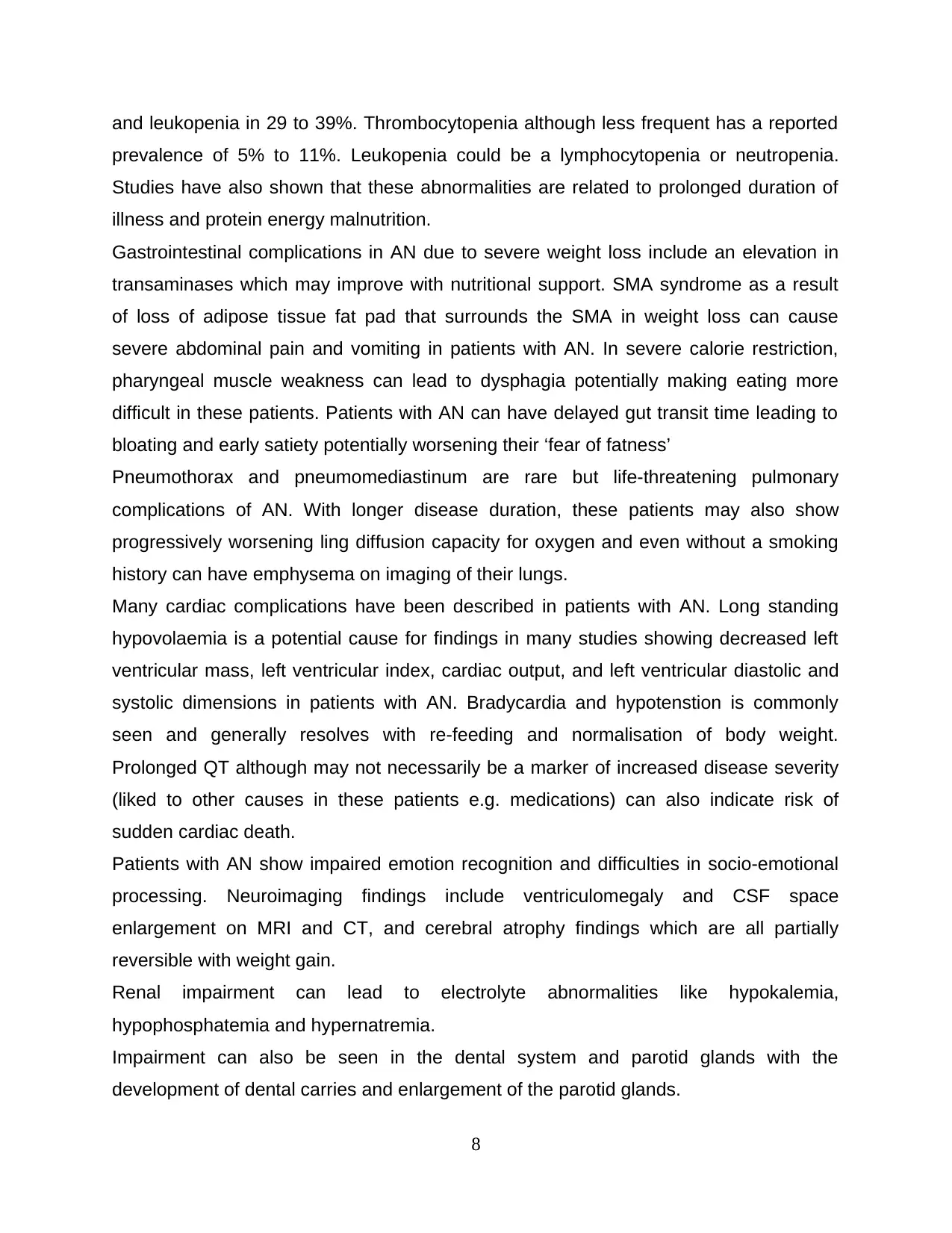
prevalence of 5% to 11%. Leukopenia could be a lymphocytopenia or neutropenia.
Studies have also shown that these abnormalities are related to prolonged duration of
illness and protein energy malnutrition.
Gastrointestinal complications in AN due to severe weight loss include an elevation in
transaminases which may improve with nutritional support. SMA syndrome as a result
of loss of adipose tissue fat pad that surrounds the SMA in weight loss can cause
severe abdominal pain and vomiting in patients with AN. In severe calorie restriction,
pharyngeal muscle weakness can lead to dysphagia potentially making eating more
difficult in these patients. Patients with AN can have delayed gut transit time leading to
bloating and early satiety potentially worsening their ‘fear of fatness’
Pneumothorax and pneumomediastinum are rare but life-threatening pulmonary
complications of AN. With longer disease duration, these patients may also show
progressively worsening ling diffusion capacity for oxygen and even without a smoking
history can have emphysema on imaging of their lungs.
Many cardiac complications have been described in patients with AN. Long standing
hypovolaemia is a potential cause for findings in many studies showing decreased left
ventricular mass, left ventricular index, cardiac output, and left ventricular diastolic and
systolic dimensions in patients with AN. Bradycardia and hypotenstion is commonly
seen and generally resolves with re-feeding and normalisation of body weight.
Prolonged QT although may not necessarily be a marker of increased disease severity
(liked to other causes in these patients e.g. medications) can also indicate risk of
sudden cardiac death.
Patients with AN show impaired emotion recognition and difficulties in socio-emotional
processing. Neuroimaging findings include ventriculomegaly and CSF space
enlargement on MRI and CT, and cerebral atrophy findings which are all partially
reversible with weight gain.
Renal impairment can lead to electrolyte abnormalities like hypokalemia,
hypophosphatemia and hypernatremia.
Impairment can also be seen in the dental system and parotid glands with the
development of dental carries and enlargement of the parotid glands.
8
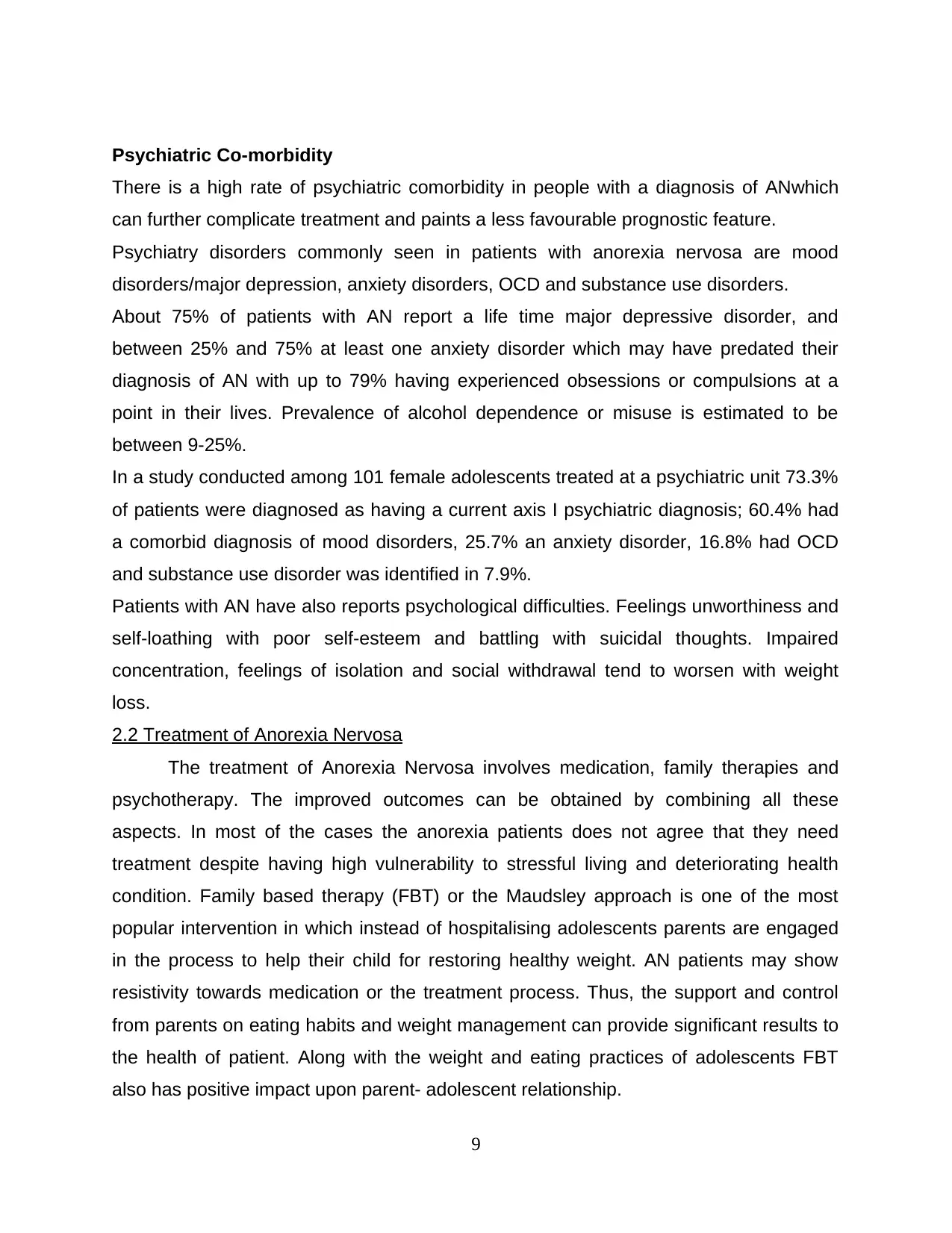
There is a high rate of psychiatric comorbidity in people with a diagnosis of ANwhich
can further complicate treatment and paints a less favourable prognostic feature.
Psychiatry disorders commonly seen in patients with anorexia nervosa are mood
disorders/major depression, anxiety disorders, OCD and substance use disorders.
About 75% of patients with AN report a life time major depressive disorder, and
between 25% and 75% at least one anxiety disorder which may have predated their
diagnosis of AN with up to 79% having experienced obsessions or compulsions at a
point in their lives. Prevalence of alcohol dependence or misuse is estimated to be
between 9-25%.
In a study conducted among 101 female adolescents treated at a psychiatric unit 73.3%
of patients were diagnosed as having a current axis I psychiatric diagnosis; 60.4% had
a comorbid diagnosis of mood disorders, 25.7% an anxiety disorder, 16.8% had OCD
and substance use disorder was identified in 7.9%.
Patients with AN have also reports psychological difficulties. Feelings unworthiness and
self-loathing with poor self-esteem and battling with suicidal thoughts. Impaired
concentration, feelings of isolation and social withdrawal tend to worsen with weight
loss.
2.2 Treatment of Anorexia Nervosa
The treatment of Anorexia Nervosa involves medication, family therapies and
psychotherapy. The improved outcomes can be obtained by combining all these
aspects. In most of the cases the anorexia patients does not agree that they need
treatment despite having high vulnerability to stressful living and deteriorating health
condition. Family based therapy (FBT) or the Maudsley approach is one of the most
popular intervention in which instead of hospitalising adolescents parents are engaged
in the process to help their child for restoring healthy weight. AN patients may show
resistivity towards medication or the treatment process. Thus, the support and control
from parents on eating habits and weight management can provide significant results to
the health of patient. Along with the weight and eating practices of adolescents FBT
also has positive impact upon parent- adolescent relationship.
9
⊘ This is a preview!⊘
Do you want full access?
Subscribe today to unlock all pages.

Trusted by 1+ million students worldwide
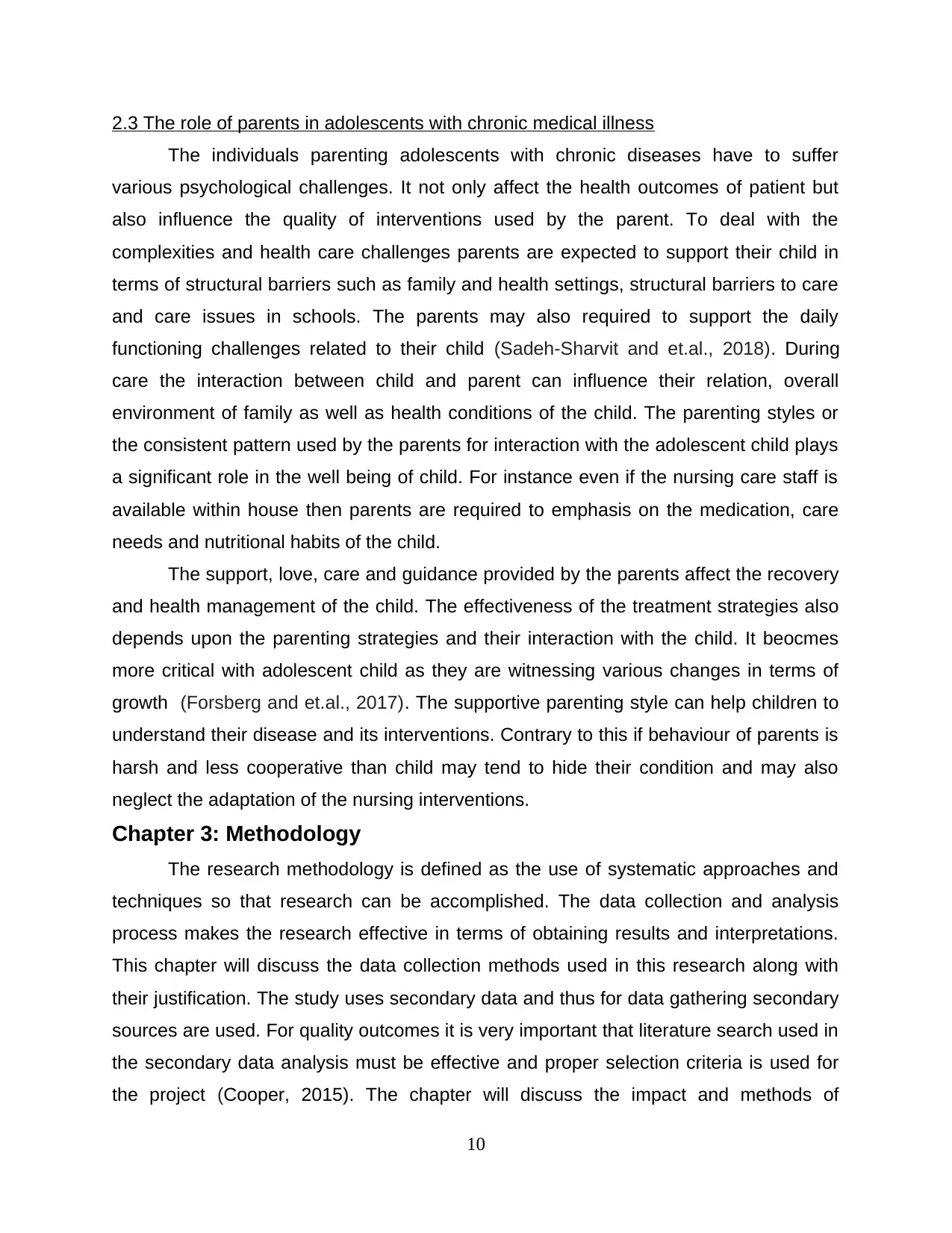
The individuals parenting adolescents with chronic diseases have to suffer
various psychological challenges. It not only affect the health outcomes of patient but
also influence the quality of interventions used by the parent. To deal with the
complexities and health care challenges parents are expected to support their child in
terms of structural barriers such as family and health settings, structural barriers to care
and care issues in schools. The parents may also required to support the daily
functioning challenges related to their child (Sadeh‐Sharvit and et.al., 2018). During
care the interaction between child and parent can influence their relation, overall
environment of family as well as health conditions of the child. The parenting styles or
the consistent pattern used by the parents for interaction with the adolescent child plays
a significant role in the well being of child. For instance even if the nursing care staff is
available within house then parents are required to emphasis on the medication, care
needs and nutritional habits of the child.
The support, love, care and guidance provided by the parents affect the recovery
and health management of the child. The effectiveness of the treatment strategies also
depends upon the parenting strategies and their interaction with the child. It beocmes
more critical with adolescent child as they are witnessing various changes in terms of
growth (Forsberg and et.al., 2017). The supportive parenting style can help children to
understand their disease and its interventions. Contrary to this if behaviour of parents is
harsh and less cooperative than child may tend to hide their condition and may also
neglect the adaptation of the nursing interventions.
Chapter 3: Methodology
The research methodology is defined as the use of systematic approaches and
techniques so that research can be accomplished. The data collection and analysis
process makes the research effective in terms of obtaining results and interpretations.
This chapter will discuss the data collection methods used in this research along with
their justification. The study uses secondary data and thus for data gathering secondary
sources are used. For quality outcomes it is very important that literature search used in
the secondary data analysis must be effective and proper selection criteria is used for
the project (Cooper, 2015). The chapter will discuss the impact and methods of
10
Paraphrase This Document
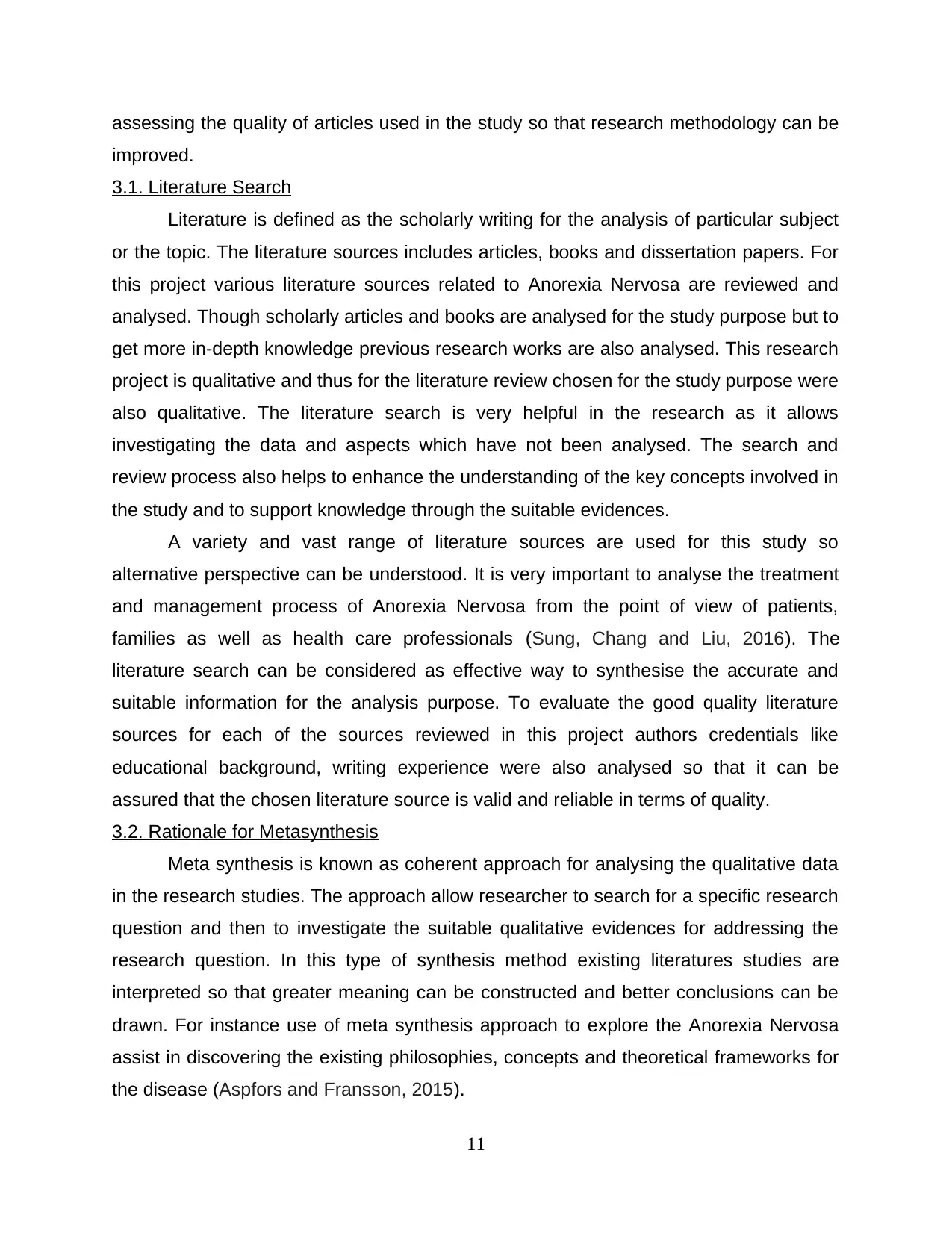
improved.
3.1. Literature Search
Literature is defined as the scholarly writing for the analysis of particular subject
or the topic. The literature sources includes articles, books and dissertation papers. For
this project various literature sources related to Anorexia Nervosa are reviewed and
analysed. Though scholarly articles and books are analysed for the study purpose but to
get more in-depth knowledge previous research works are also analysed. This research
project is qualitative and thus for the literature review chosen for the study purpose were
also qualitative. The literature search is very helpful in the research as it allows
investigating the data and aspects which have not been analysed. The search and
review process also helps to enhance the understanding of the key concepts involved in
the study and to support knowledge through the suitable evidences.
A variety and vast range of literature sources are used for this study so
alternative perspective can be understood. It is very important to analyse the treatment
and management process of Anorexia Nervosa from the point of view of patients,
families as well as health care professionals (Sung, Chang and Liu, 2016). The
literature search can be considered as effective way to synthesise the accurate and
suitable information for the analysis purpose. To evaluate the good quality literature
sources for each of the sources reviewed in this project authors credentials like
educational background, writing experience were also analysed so that it can be
assured that the chosen literature source is valid and reliable in terms of quality.
3.2. Rationale for Metasynthesis
Meta synthesis is known as coherent approach for analysing the qualitative data
in the research studies. The approach allow researcher to search for a specific research
question and then to investigate the suitable qualitative evidences for addressing the
research question. In this type of synthesis method existing literatures studies are
interpreted so that greater meaning can be constructed and better conclusions can be
drawn. For instance use of meta synthesis approach to explore the Anorexia Nervosa
assist in discovering the existing philosophies, concepts and theoretical frameworks for
the disease (Aspfors and Fransson, 2015).
11
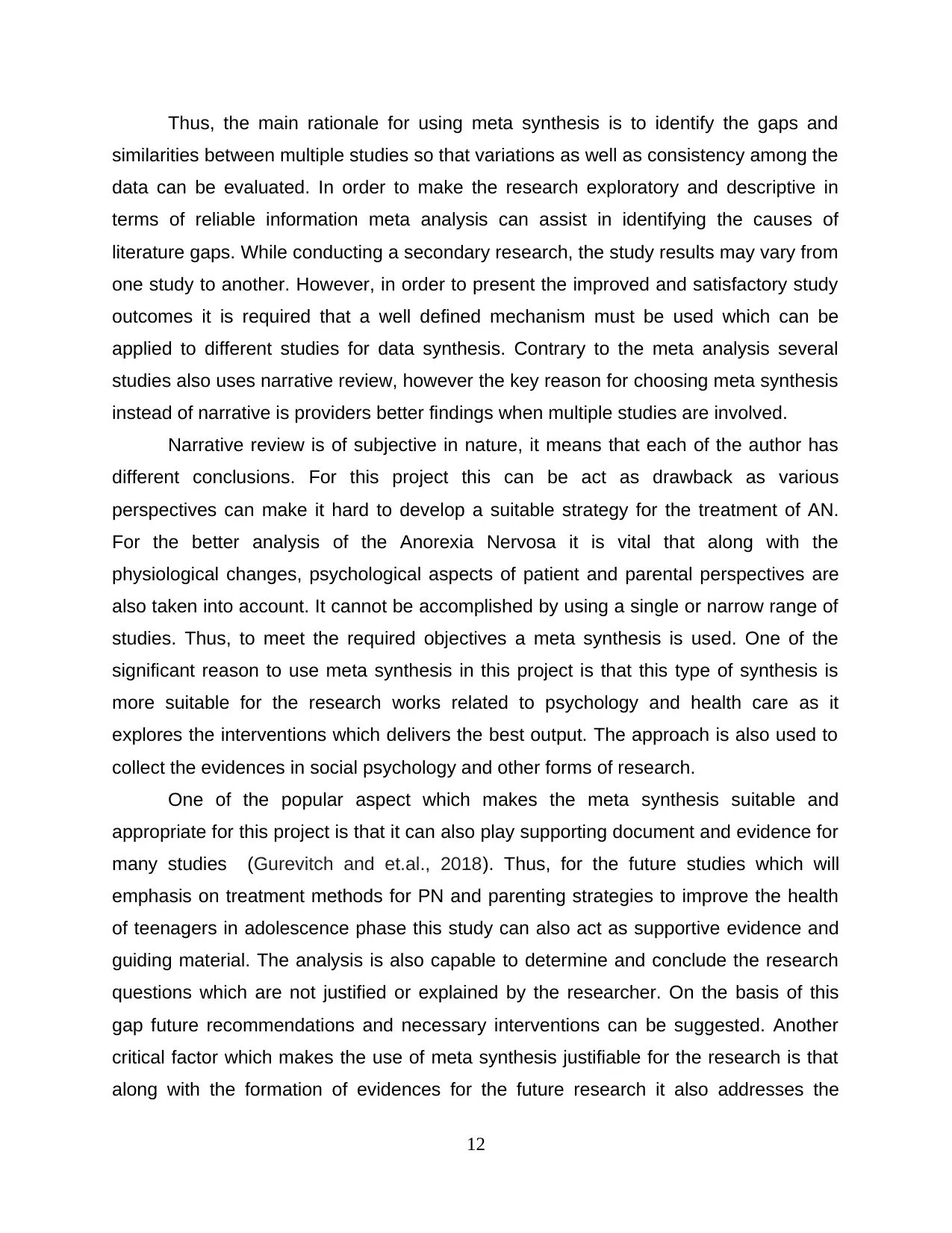
similarities between multiple studies so that variations as well as consistency among the
data can be evaluated. In order to make the research exploratory and descriptive in
terms of reliable information meta analysis can assist in identifying the causes of
literature gaps. While conducting a secondary research, the study results may vary from
one study to another. However, in order to present the improved and satisfactory study
outcomes it is required that a well defined mechanism must be used which can be
applied to different studies for data synthesis. Contrary to the meta analysis several
studies also uses narrative review, however the key reason for choosing meta synthesis
instead of narrative is providers better findings when multiple studies are involved.
Narrative review is of subjective in nature, it means that each of the author has
different conclusions. For this project this can be act as drawback as various
perspectives can make it hard to develop a suitable strategy for the treatment of AN.
For the better analysis of the Anorexia Nervosa it is vital that along with the
physiological changes, psychological aspects of patient and parental perspectives are
also taken into account. It cannot be accomplished by using a single or narrow range of
studies. Thus, to meet the required objectives a meta synthesis is used. One of the
significant reason to use meta synthesis in this project is that this type of synthesis is
more suitable for the research works related to psychology and health care as it
explores the interventions which delivers the best output. The approach is also used to
collect the evidences in social psychology and other forms of research.
One of the popular aspect which makes the meta synthesis suitable and
appropriate for this project is that it can also play supporting document and evidence for
many studies (Gurevitch and et.al., 2018). Thus, for the future studies which will
emphasis on treatment methods for PN and parenting strategies to improve the health
of teenagers in adolescence phase this study can also act as supportive evidence and
guiding material. The analysis is also capable to determine and conclude the research
questions which are not justified or explained by the researcher. On the basis of this
gap future recommendations and necessary interventions can be suggested. Another
critical factor which makes the use of meta synthesis justifiable for the research is that
along with the formation of evidences for the future research it also addresses the
12
⊘ This is a preview!⊘
Do you want full access?
Subscribe today to unlock all pages.

Trusted by 1+ million students worldwide
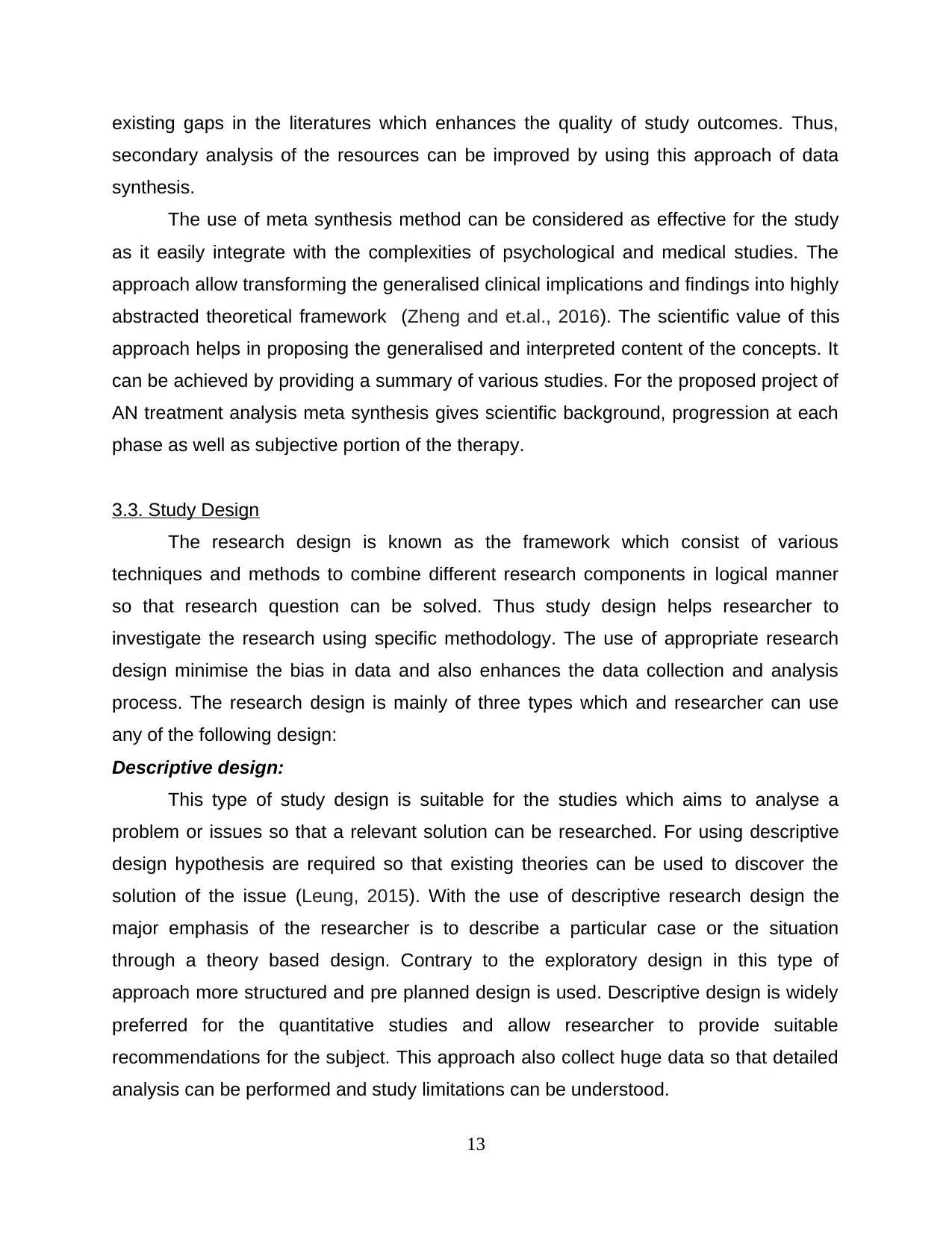
secondary analysis of the resources can be improved by using this approach of data
synthesis.
The use of meta synthesis method can be considered as effective for the study
as it easily integrate with the complexities of psychological and medical studies. The
approach allow transforming the generalised clinical implications and findings into highly
abstracted theoretical framework (Zheng and et.al., 2016). The scientific value of this
approach helps in proposing the generalised and interpreted content of the concepts. It
can be achieved by providing a summary of various studies. For the proposed project of
AN treatment analysis meta synthesis gives scientific background, progression at each
phase as well as subjective portion of the therapy.
3.3. Study Design
The research design is known as the framework which consist of various
techniques and methods to combine different research components in logical manner
so that research question can be solved. Thus study design helps researcher to
investigate the research using specific methodology. The use of appropriate research
design minimise the bias in data and also enhances the data collection and analysis
process. The research design is mainly of three types which and researcher can use
any of the following design:
Descriptive design:
This type of study design is suitable for the studies which aims to analyse a
problem or issues so that a relevant solution can be researched. For using descriptive
design hypothesis are required so that existing theories can be used to discover the
solution of the issue (Leung, 2015). With the use of descriptive research design the
major emphasis of the researcher is to describe a particular case or the situation
through a theory based design. Contrary to the exploratory design in this type of
approach more structured and pre planned design is used. Descriptive design is widely
preferred for the quantitative studies and allow researcher to provide suitable
recommendations for the subject. This approach also collect huge data so that detailed
analysis can be performed and study limitations can be understood.
13
Paraphrase This Document
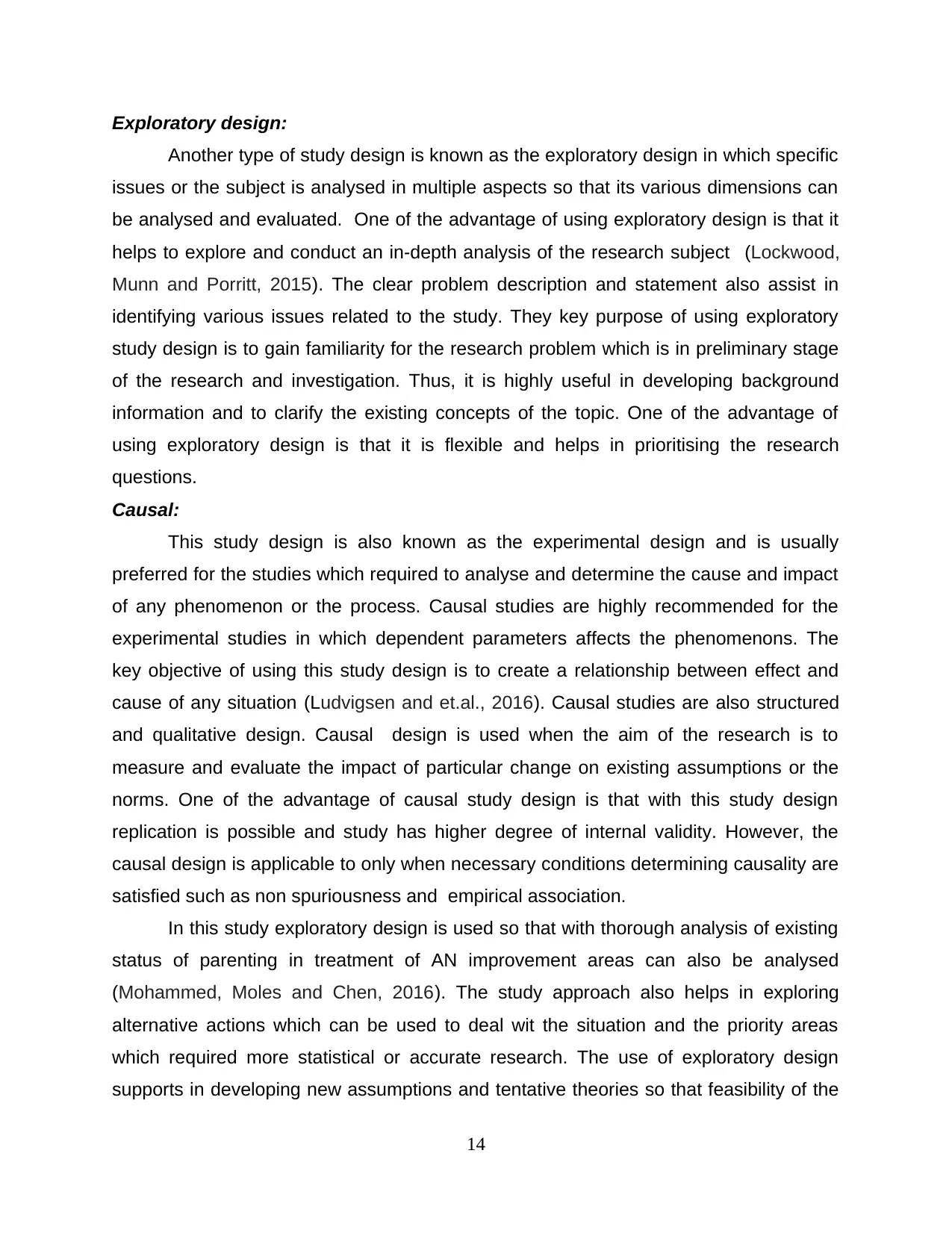
Another type of study design is known as the exploratory design in which specific
issues or the subject is analysed in multiple aspects so that its various dimensions can
be analysed and evaluated. One of the advantage of using exploratory design is that it
helps to explore and conduct an in-depth analysis of the research subject (Lockwood,
Munn and Porritt, 2015). The clear problem description and statement also assist in
identifying various issues related to the study. They key purpose of using exploratory
study design is to gain familiarity for the research problem which is in preliminary stage
of the research and investigation. Thus, it is highly useful in developing background
information and to clarify the existing concepts of the topic. One of the advantage of
using exploratory design is that it is flexible and helps in prioritising the research
questions.
Causal:
This study design is also known as the experimental design and is usually
preferred for the studies which required to analyse and determine the cause and impact
of any phenomenon or the process. Causal studies are highly recommended for the
experimental studies in which dependent parameters affects the phenomenons. The
key objective of using this study design is to create a relationship between effect and
cause of any situation (Ludvigsen and et.al., 2016). Causal studies are also structured
and qualitative design. Causal design is used when the aim of the research is to
measure and evaluate the impact of particular change on existing assumptions or the
norms. One of the advantage of causal study design is that with this study design
replication is possible and study has higher degree of internal validity. However, the
causal design is applicable to only when necessary conditions determining causality are
satisfied such as non spuriousness and empirical association.
In this study exploratory design is used so that with thorough analysis of existing
status of parenting in treatment of AN improvement areas can also be analysed
(Mohammed, Moles and Chen, 2016). The study approach also helps in exploring
alternative actions which can be used to deal wit the situation and the priority areas
which required more statistical or accurate research. The use of exploratory design
supports in developing new assumptions and tentative theories so that feasibility of the
14
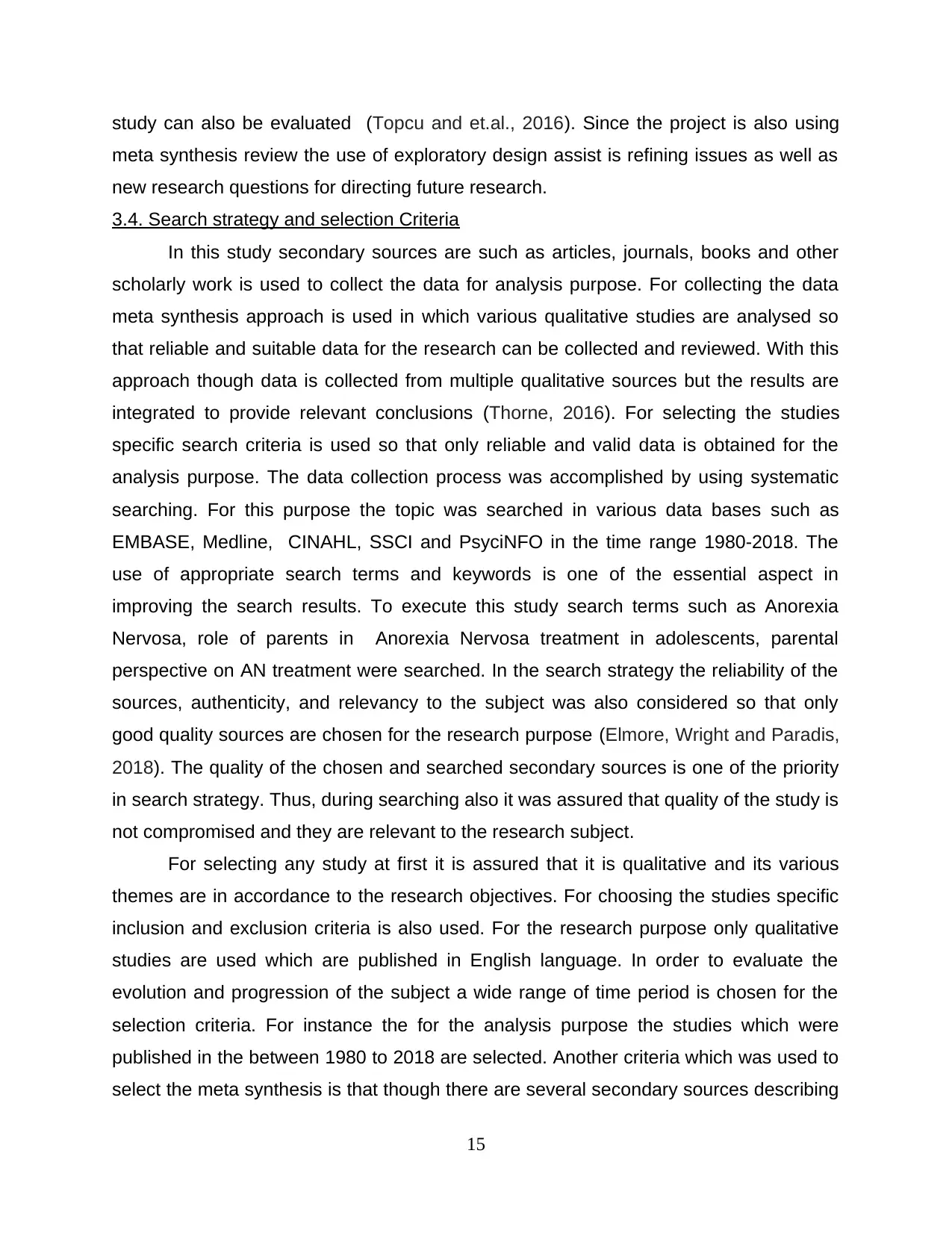
meta synthesis review the use of exploratory design assist is refining issues as well as
new research questions for directing future research.
3.4. Search strategy and selection Criteria
In this study secondary sources are such as articles, journals, books and other
scholarly work is used to collect the data for analysis purpose. For collecting the data
meta synthesis approach is used in which various qualitative studies are analysed so
that reliable and suitable data for the research can be collected and reviewed. With this
approach though data is collected from multiple qualitative sources but the results are
integrated to provide relevant conclusions (Thorne, 2016). For selecting the studies
specific search criteria is used so that only reliable and valid data is obtained for the
analysis purpose. The data collection process was accomplished by using systematic
searching. For this purpose the topic was searched in various data bases such as
EMBASE, Medline, CINAHL, SSCI and PsyciNFO in the time range 1980-2018. The
use of appropriate search terms and keywords is one of the essential aspect in
improving the search results. To execute this study search terms such as Anorexia
Nervosa, role of parents in Anorexia Nervosa treatment in adolescents, parental
perspective on AN treatment were searched. In the search strategy the reliability of the
sources, authenticity, and relevancy to the subject was also considered so that only
good quality sources are chosen for the research purpose (Elmore, Wright and Paradis,
2018). The quality of the chosen and searched secondary sources is one of the priority
in search strategy. Thus, during searching also it was assured that quality of the study is
not compromised and they are relevant to the research subject.
For selecting any study at first it is assured that it is qualitative and its various
themes are in accordance to the research objectives. For choosing the studies specific
inclusion and exclusion criteria is also used. For the research purpose only qualitative
studies are used which are published in English language. In order to evaluate the
evolution and progression of the subject a wide range of time period is chosen for the
selection criteria. For instance the for the analysis purpose the studies which were
published in the between 1980 to 2018 are selected. Another criteria which was used to
select the meta synthesis is that though there are several secondary sources describing
15
⊘ This is a preview!⊘
Do you want full access?
Subscribe today to unlock all pages.

Trusted by 1+ million students worldwide

which emphasis was given to treatment interventions for adolescents form the
perspective and involvement of parents. In addition to these criteria specific exclusion
criteria are also used so that highly specific qualitative studies are selected for the
research. Since the use of mixed methodology makes study very complex and less
exploratory towards the research object the secondary sources based upon mixed
methodology are avoided in this project (Phillippi and Lauderdale, 2018). The key focus
of the project is on treatment of Anorexia Nervosa thus the qualitative studies which are
based upon different eating disorders or obesity are not included in this research. The
perspective and the role of parents is one of the critical and essential aspect of this
project and thus the studies in which role of parents in treatment of adolescents is not
considered were excluded from the selection.
3.5. Assessment of Article Quality
The data collection is one of the most important aspect of the research as it
develops the foundation for analysing the data. The results and evidences gathered
from data collection and analysis process plays major role in execution and
accomplishment of the research. The assessment of the selected article not only
enhances the quality and accuracy of the research but it also assists in achieving
research goals (Lee and et.al., 2015). The quality of the searched and reviewed article
is measured and evaluated in various aspects such as in terms of quality, validity,
authenticity, efficiency and accuracy. For this purpose at first it was analysed that if
article is peer reviewed or not.
The secondary sources which are reviewed and evaluated by experiences
researchers are considered to be more effective in terms of quality. Another criteria
which is use for the quality assessment of the study is the description of the key terms
and components of the research. For instance the secondary sources in which brief
description of the key research variables, concepts and analytic techniques is given in
the form of abstract are considered to be more effective (Finfgeld-Connett, 2018). Thus,
the final selection of any study for the data collection purpose was also based upon this
quality measurement. The research validity is one of the vital attribute which is
measured as the means of quality.
16
Paraphrase This Document
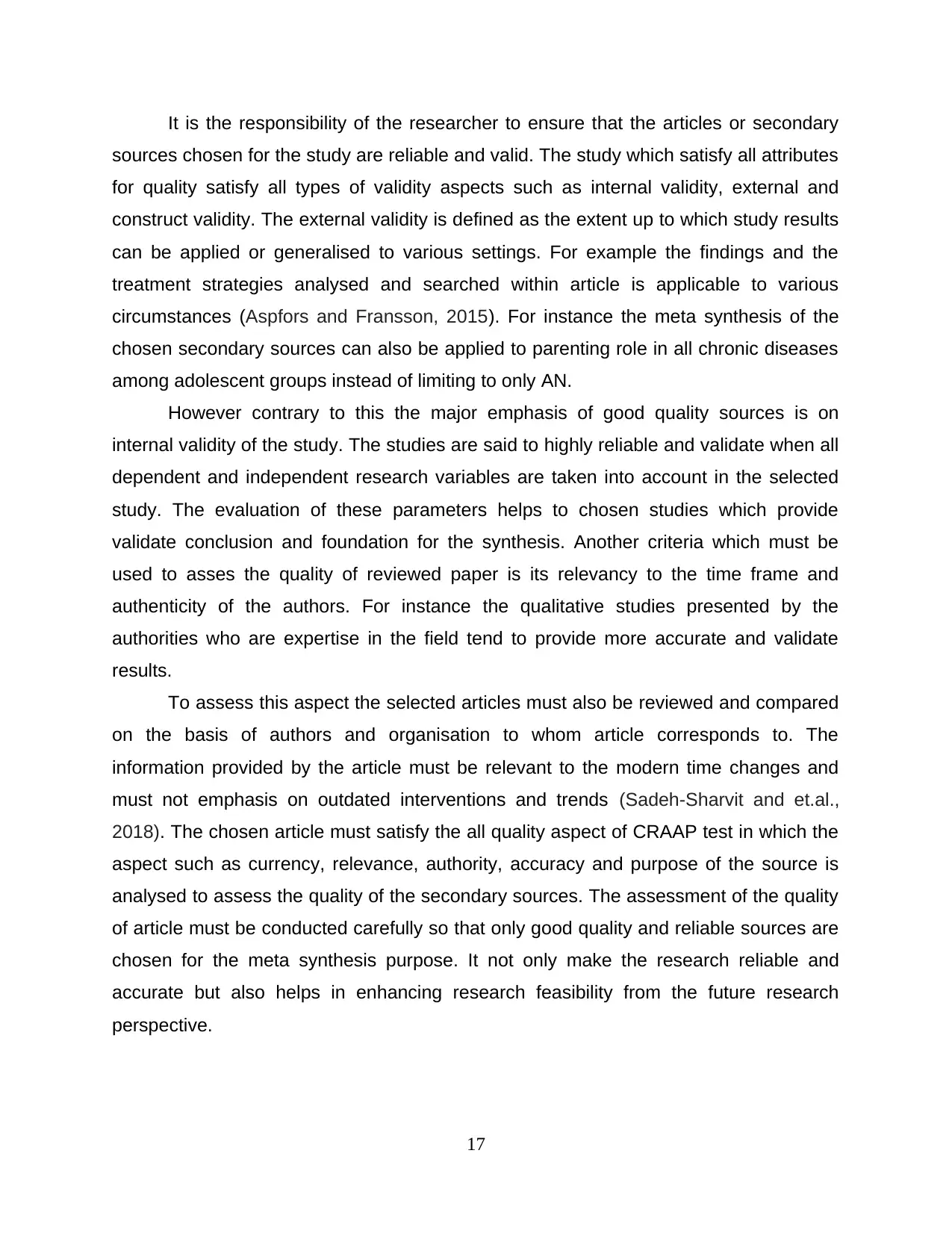
sources chosen for the study are reliable and valid. The study which satisfy all attributes
for quality satisfy all types of validity aspects such as internal validity, external and
construct validity. The external validity is defined as the extent up to which study results
can be applied or generalised to various settings. For example the findings and the
treatment strategies analysed and searched within article is applicable to various
circumstances (Aspfors and Fransson, 2015). For instance the meta synthesis of the
chosen secondary sources can also be applied to parenting role in all chronic diseases
among adolescent groups instead of limiting to only AN.
However contrary to this the major emphasis of good quality sources is on
internal validity of the study. The studies are said to highly reliable and validate when all
dependent and independent research variables are taken into account in the selected
study. The evaluation of these parameters helps to chosen studies which provide
validate conclusion and foundation for the synthesis. Another criteria which must be
used to asses the quality of reviewed paper is its relevancy to the time frame and
authenticity of the authors. For instance the qualitative studies presented by the
authorities who are expertise in the field tend to provide more accurate and validate
results.
To assess this aspect the selected articles must also be reviewed and compared
on the basis of authors and organisation to whom article corresponds to. The
information provided by the article must be relevant to the modern time changes and
must not emphasis on outdated interventions and trends (Sadeh‐Sharvit and et.al.,
2018). The chosen article must satisfy the all quality aspect of CRAAP test in which the
aspect such as currency, relevance, authority, accuracy and purpose of the source is
analysed to assess the quality of the secondary sources. The assessment of the quality
of article must be conducted carefully so that only good quality and reliable sources are
chosen for the meta synthesis purpose. It not only make the research reliable and
accurate but also helps in enhancing research feasibility from the future research
perspective.
17
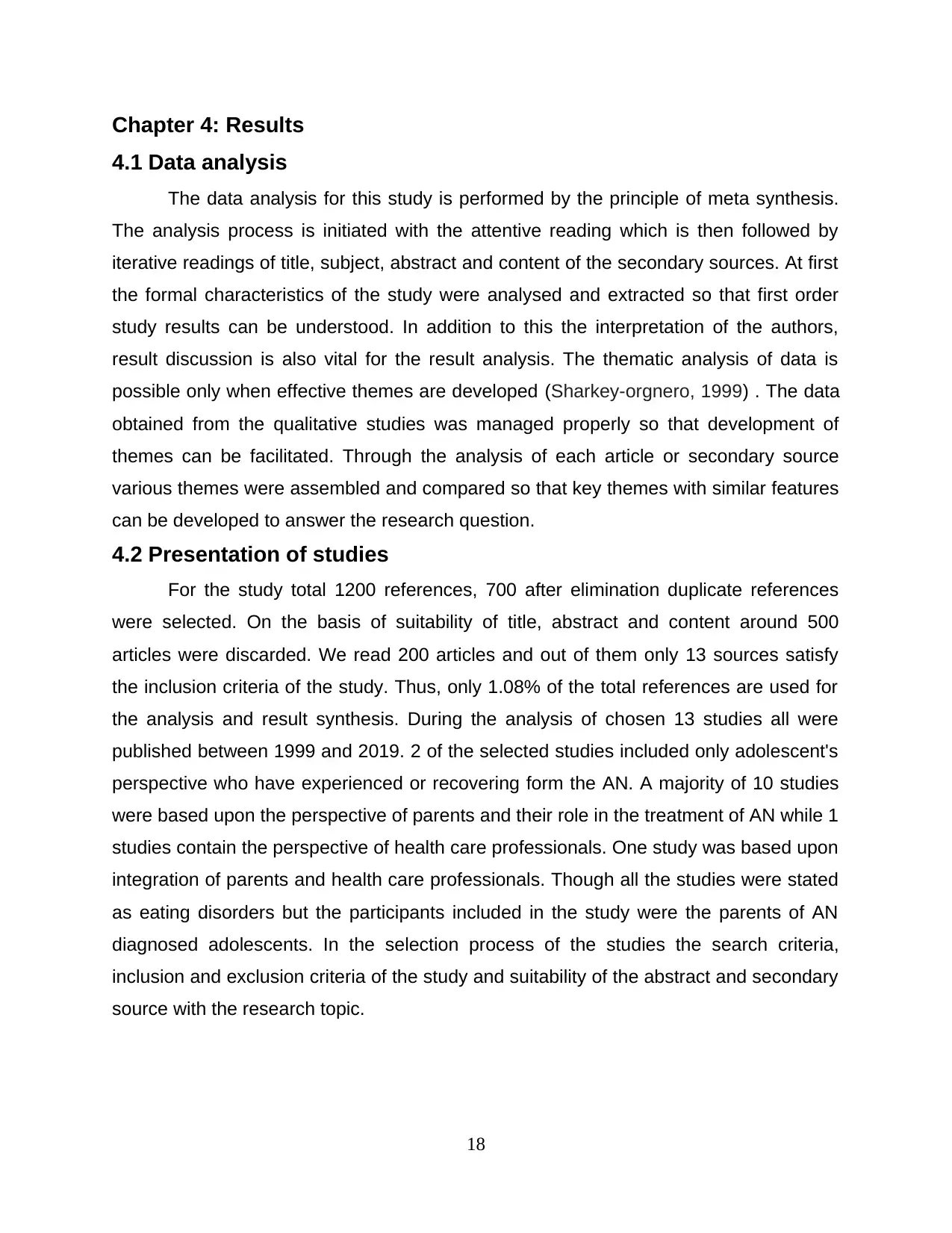
4.1 Data analysis
The data analysis for this study is performed by the principle of meta synthesis.
The analysis process is initiated with the attentive reading which is then followed by
iterative readings of title, subject, abstract and content of the secondary sources. At first
the formal characteristics of the study were analysed and extracted so that first order
study results can be understood. In addition to this the interpretation of the authors,
result discussion is also vital for the result analysis. The thematic analysis of data is
possible only when effective themes are developed (Sharkey-orgnero, 1999) . The data
obtained from the qualitative studies was managed properly so that development of
themes can be facilitated. Through the analysis of each article or secondary source
various themes were assembled and compared so that key themes with similar features
can be developed to answer the research question.
4.2 Presentation of studies
For the study total 1200 references, 700 after elimination duplicate references
were selected. On the basis of suitability of title, abstract and content around 500
articles were discarded. We read 200 articles and out of them only 13 sources satisfy
the inclusion criteria of the study. Thus, only 1.08% of the total references are used for
the analysis and result synthesis. During the analysis of chosen 13 studies all were
published between 1999 and 2019. 2 of the selected studies included only adolescent's
perspective who have experienced or recovering form the AN. A majority of 10 studies
were based upon the perspective of parents and their role in the treatment of AN while 1
studies contain the perspective of health care professionals. One study was based upon
integration of parents and health care professionals. Though all the studies were stated
as eating disorders but the participants included in the study were the parents of AN
diagnosed adolescents. In the selection process of the studies the search criteria,
inclusion and exclusion criteria of the study and suitability of the abstract and secondary
source with the research topic.
18
⊘ This is a preview!⊘
Do you want full access?
Subscribe today to unlock all pages.

Trusted by 1+ million students worldwide
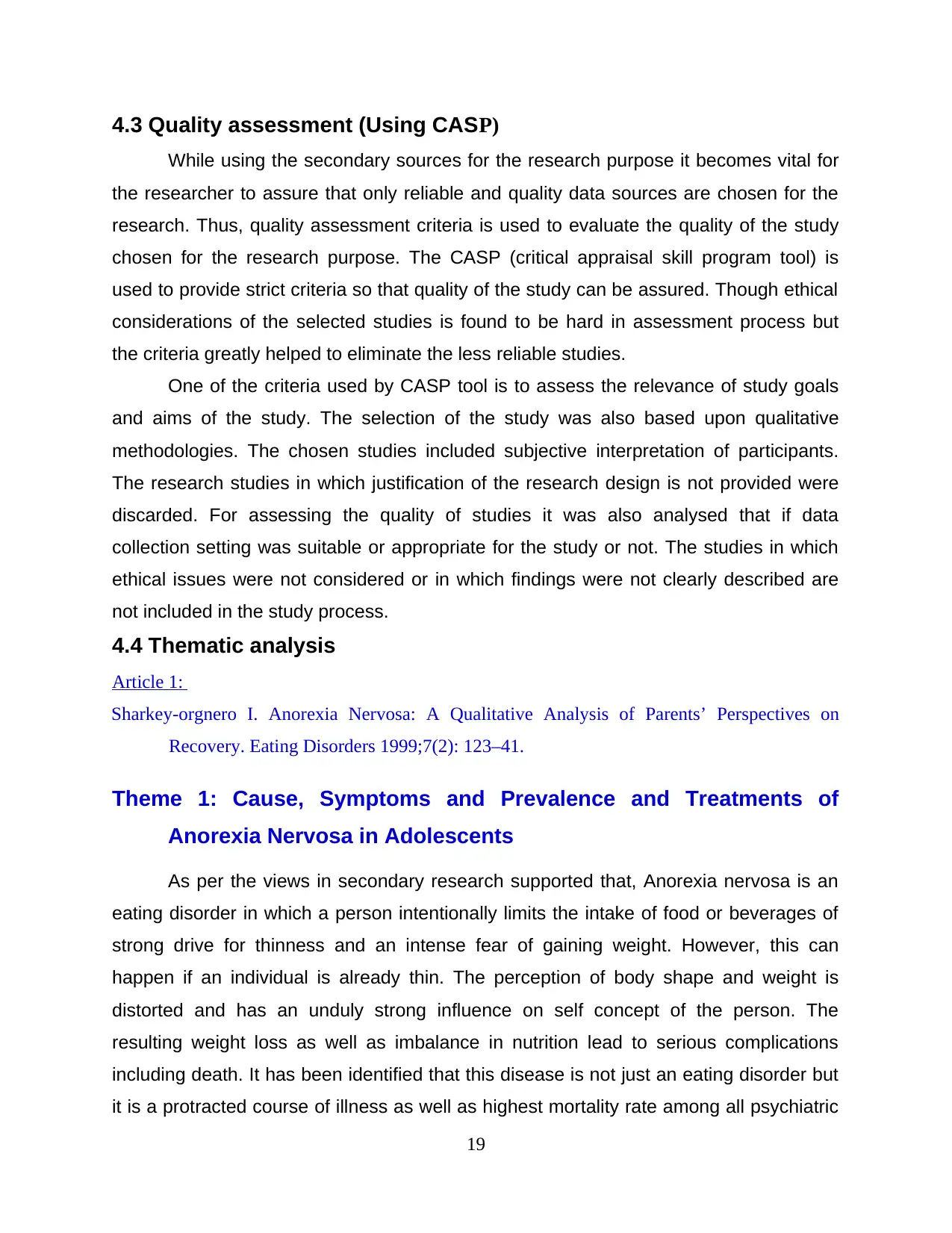
While using the secondary sources for the research purpose it becomes vital for
the researcher to assure that only reliable and quality data sources are chosen for the
research. Thus, quality assessment criteria is used to evaluate the quality of the study
chosen for the research purpose. The CASP (critical appraisal skill program tool) is
used to provide strict criteria so that quality of the study can be assured. Though ethical
considerations of the selected studies is found to be hard in assessment process but
the criteria greatly helped to eliminate the less reliable studies.
One of the criteria used by CASP tool is to assess the relevance of study goals
and aims of the study. The selection of the study was also based upon qualitative
methodologies. The chosen studies included subjective interpretation of participants.
The research studies in which justification of the research design is not provided were
discarded. For assessing the quality of studies it was also analysed that if data
collection setting was suitable or appropriate for the study or not. The studies in which
ethical issues were not considered or in which findings were not clearly described are
not included in the study process.
4.4 Thematic analysis
Article 1:
Sharkey-orgnero I. Anorexia Nervosa: A Qualitative Analysis of Parents’ Perspectives on
Recovery. Eating Disorders 1999;7(2): 123–41.
Theme 1: Cause, Symptoms and Prevalence and Treatments of
Anorexia Nervosa in Adolescents
As per the views in secondary research supported that, Anorexia nervosa is an
eating disorder in which a person intentionally limits the intake of food or beverages of
strong drive for thinness and an intense fear of gaining weight. However, this can
happen if an individual is already thin. The perception of body shape and weight is
distorted and has an unduly strong influence on self concept of the person. The
resulting weight loss as well as imbalance in nutrition lead to serious complications
including death. It has been identified that this disease is not just an eating disorder but
it is a protracted course of illness as well as highest mortality rate among all psychiatric
19
Paraphrase This Document
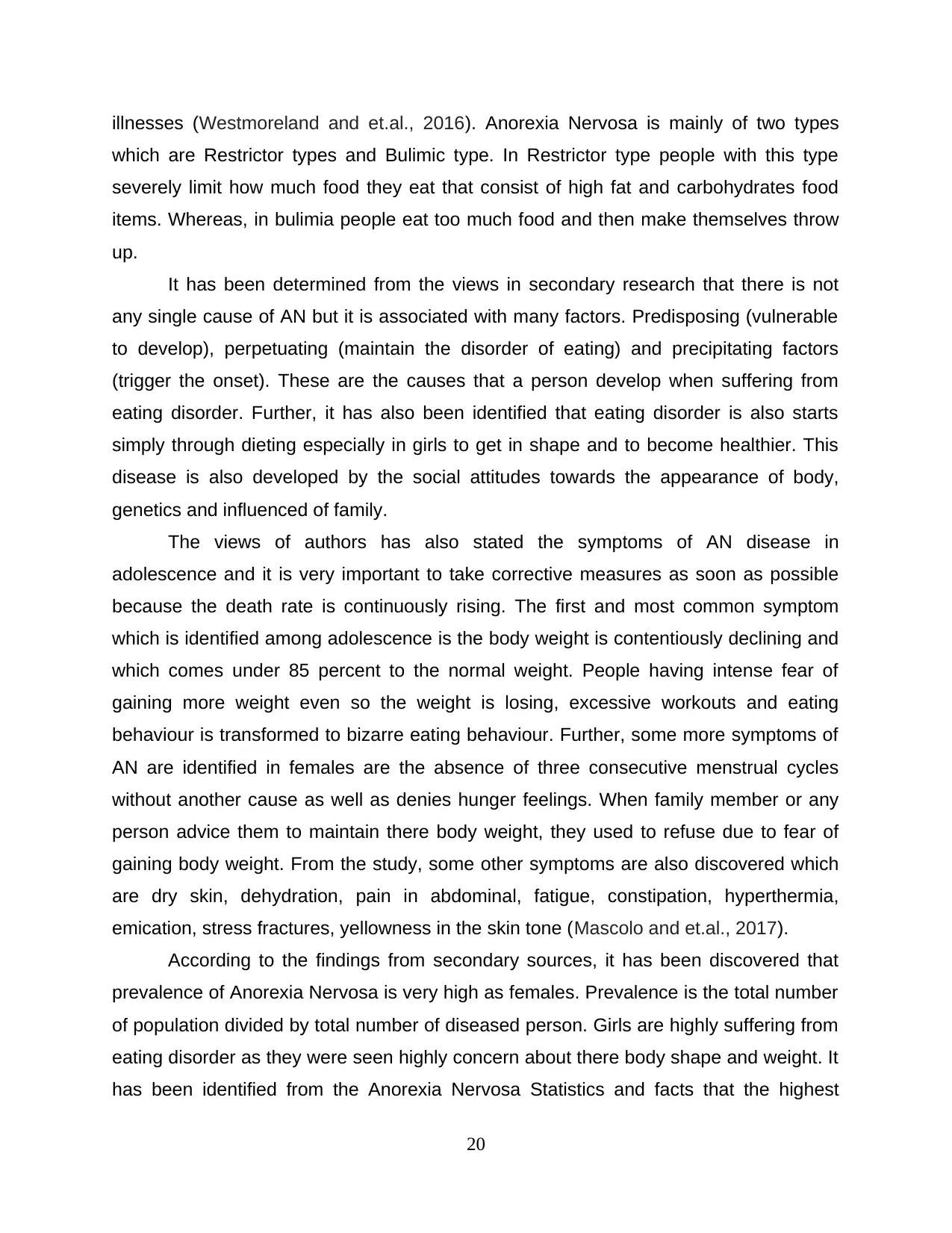
which are Restrictor types and Bulimic type. In Restrictor type people with this type
severely limit how much food they eat that consist of high fat and carbohydrates food
items. Whereas, in bulimia people eat too much food and then make themselves throw
up.
It has been determined from the views in secondary research that there is not
any single cause of AN but it is associated with many factors. Predisposing (vulnerable
to develop), perpetuating (maintain the disorder of eating) and precipitating factors
(trigger the onset). These are the causes that a person develop when suffering from
eating disorder. Further, it has also been identified that eating disorder is also starts
simply through dieting especially in girls to get in shape and to become healthier. This
disease is also developed by the social attitudes towards the appearance of body,
genetics and influenced of family.
The views of authors has also stated the symptoms of AN disease in
adolescence and it is very important to take corrective measures as soon as possible
because the death rate is continuously rising. The first and most common symptom
which is identified among adolescence is the body weight is contentiously declining and
which comes under 85 percent to the normal weight. People having intense fear of
gaining more weight even so the weight is losing, excessive workouts and eating
behaviour is transformed to bizarre eating behaviour. Further, some more symptoms of
AN are identified in females are the absence of three consecutive menstrual cycles
without another cause as well as denies hunger feelings. When family member or any
person advice them to maintain there body weight, they used to refuse due to fear of
gaining body weight. From the study, some other symptoms are also discovered which
are dry skin, dehydration, pain in abdominal, fatigue, constipation, hyperthermia,
emication, stress fractures, yellowness in the skin tone (Mascolo and et.al., 2017).
According to the findings from secondary sources, it has been discovered that
prevalence of Anorexia Nervosa is very high as females. Prevalence is the total number
of population divided by total number of diseased person. Girls are highly suffering from
eating disorder as they were seen highly concern about there body shape and weight. It
has been identified from the Anorexia Nervosa Statistics and facts that the highest
20
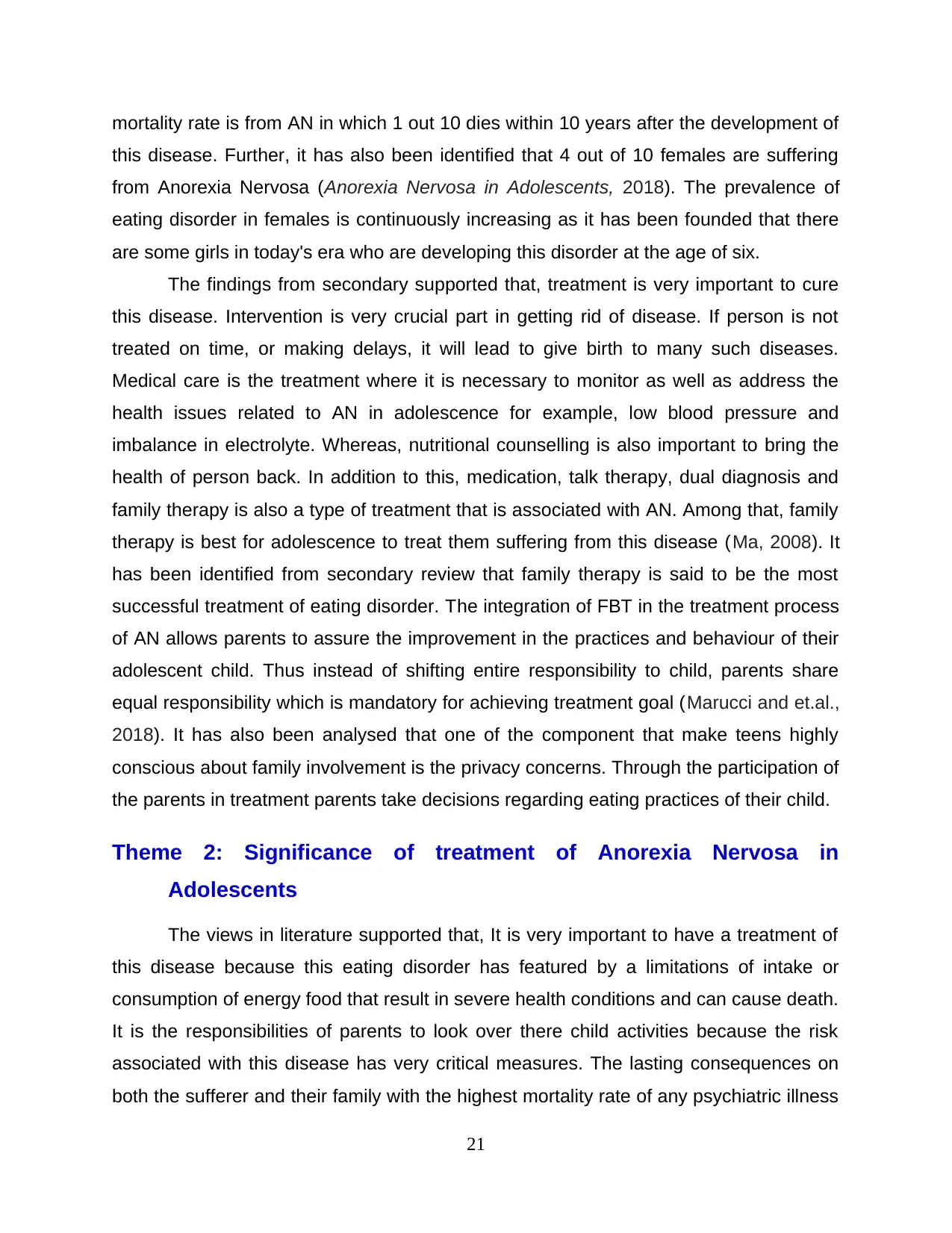
this disease. Further, it has also been identified that 4 out of 10 females are suffering
from Anorexia Nervosa (Anorexia Nervosa in Adolescents, 2018). The prevalence of
eating disorder in females is continuously increasing as it has been founded that there
are some girls in today's era who are developing this disorder at the age of six.
The findings from secondary supported that, treatment is very important to cure
this disease. Intervention is very crucial part in getting rid of disease. If person is not
treated on time, or making delays, it will lead to give birth to many such diseases.
Medical care is the treatment where it is necessary to monitor as well as address the
health issues related to AN in adolescence for example, low blood pressure and
imbalance in electrolyte. Whereas, nutritional counselling is also important to bring the
health of person back. In addition to this, medication, talk therapy, dual diagnosis and
family therapy is also a type of treatment that is associated with AN. Among that, family
therapy is best for adolescence to treat them suffering from this disease (Ma, 2008). It
has been identified from secondary review that family therapy is said to be the most
successful treatment of eating disorder. The integration of FBT in the treatment process
of AN allows parents to assure the improvement in the practices and behaviour of their
adolescent child. Thus instead of shifting entire responsibility to child, parents share
equal responsibility which is mandatory for achieving treatment goal (Marucci and et.al.,
2018). It has also been analysed that one of the component that make teens highly
conscious about family involvement is the privacy concerns. Through the participation of
the parents in treatment parents take decisions regarding eating practices of their child.
Theme 2: Significance of treatment of Anorexia Nervosa in
Adolescents
The views in literature supported that, It is very important to have a treatment of
this disease because this eating disorder has featured by a limitations of intake or
consumption of energy food that result in severe health conditions and can cause death.
It is the responsibilities of parents to look over there child activities because the risk
associated with this disease has very critical measures. The lasting consequences on
both the sufferer and their family with the highest mortality rate of any psychiatric illness
21
⊘ This is a preview!⊘
Do you want full access?
Subscribe today to unlock all pages.

Trusted by 1+ million students worldwide
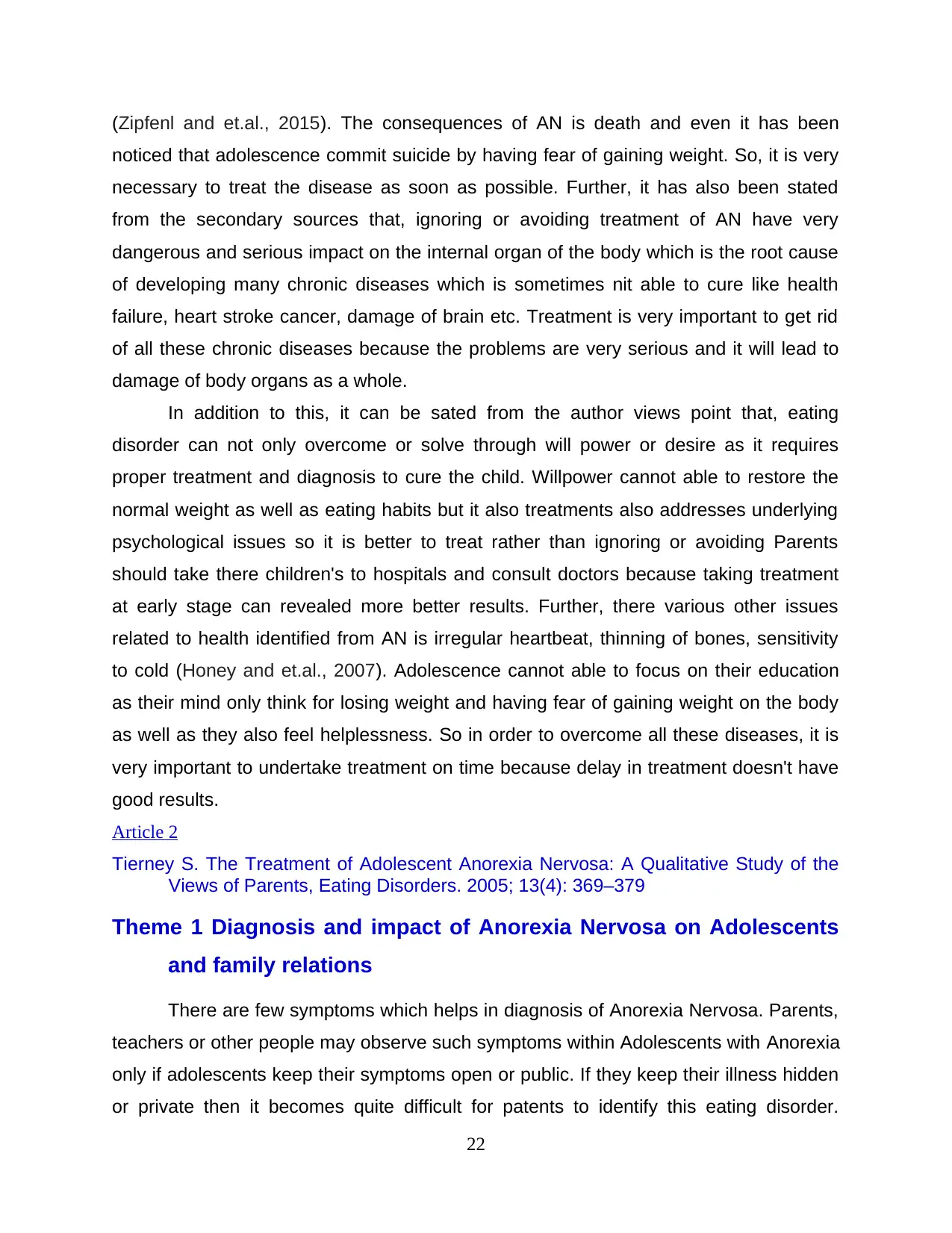
noticed that adolescence commit suicide by having fear of gaining weight. So, it is very
necessary to treat the disease as soon as possible. Further, it has also been stated
from the secondary sources that, ignoring or avoiding treatment of AN have very
dangerous and serious impact on the internal organ of the body which is the root cause
of developing many chronic diseases which is sometimes nit able to cure like health
failure, heart stroke cancer, damage of brain etc. Treatment is very important to get rid
of all these chronic diseases because the problems are very serious and it will lead to
damage of body organs as a whole.
In addition to this, it can be sated from the author views point that, eating
disorder can not only overcome or solve through will power or desire as it requires
proper treatment and diagnosis to cure the child. Willpower cannot able to restore the
normal weight as well as eating habits but it also treatments also addresses underlying
psychological issues so it is better to treat rather than ignoring or avoiding Parents
should take there children's to hospitals and consult doctors because taking treatment
at early stage can revealed more better results. Further, there various other issues
related to health identified from AN is irregular heartbeat, thinning of bones, sensitivity
to cold (Honey and et.al., 2007). Adolescence cannot able to focus on their education
as their mind only think for losing weight and having fear of gaining weight on the body
as well as they also feel helplessness. So in order to overcome all these diseases, it is
very important to undertake treatment on time because delay in treatment doesn't have
good results.
Article 2
Tierney S. The Treatment of Adolescent Anorexia Nervosa: A Qualitative Study of the
Views of Parents, Eating Disorders. 2005; 13(4): 369–379
Theme 1 Diagnosis and impact of Anorexia Nervosa on Adolescents
and family relations
There are few symptoms which helps in diagnosis of Anorexia Nervosa. Parents,
teachers or other people may observe such symptoms within Adolescents with Anorexia
only if adolescents keep their symptoms open or public. If they keep their illness hidden
or private then it becomes quite difficult for patents to identify this eating disorder.
22
Paraphrase This Document
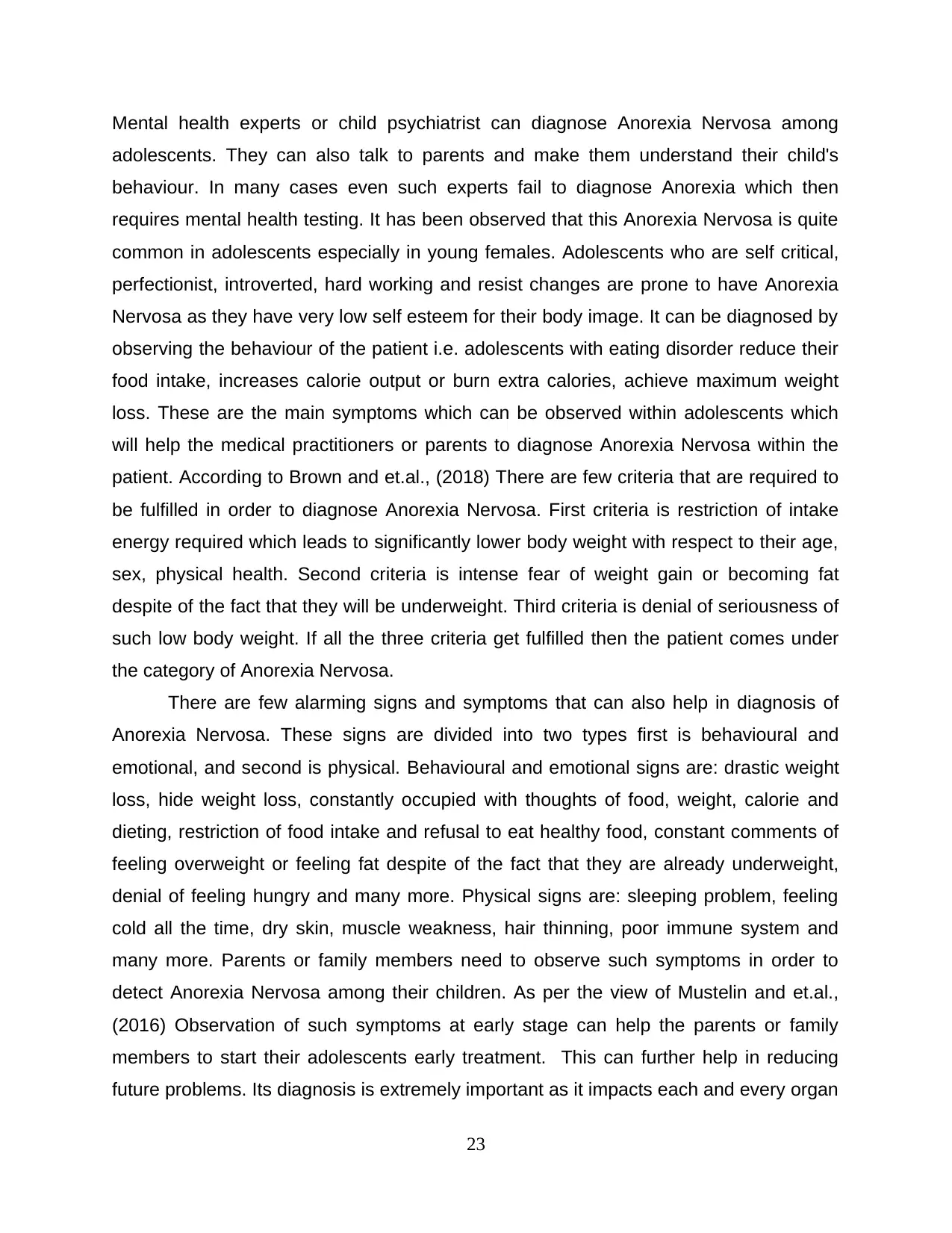
adolescents. They can also talk to parents and make them understand their child's
behaviour. In many cases even such experts fail to diagnose Anorexia which then
requires mental health testing. It has been observed that this Anorexia Nervosa is quite
common in adolescents especially in young females. Adolescents who are self critical,
perfectionist, introverted, hard working and resist changes are prone to have Anorexia
Nervosa as they have very low self esteem for their body image. It can be diagnosed by
observing the behaviour of the patient i.e. adolescents with eating disorder reduce their
food intake, increases calorie output or burn extra calories, achieve maximum weight
loss. These are the main symptoms which can be observed within adolescents which
will help the medical practitioners or parents to diagnose Anorexia Nervosa within the
patient. According to Brown and et.al., (2018) There are few criteria that are required to
be fulfilled in order to diagnose Anorexia Nervosa. First criteria is restriction of intake
energy required which leads to significantly lower body weight with respect to their age,
sex, physical health. Second criteria is intense fear of weight gain or becoming fat
despite of the fact that they will be underweight. Third criteria is denial of seriousness of
such low body weight. If all the three criteria get fulfilled then the patient comes under
the category of Anorexia Nervosa.
There are few alarming signs and symptoms that can also help in diagnosis of
Anorexia Nervosa. These signs are divided into two types first is behavioural and
emotional, and second is physical. Behavioural and emotional signs are: drastic weight
loss, hide weight loss, constantly occupied with thoughts of food, weight, calorie and
dieting, restriction of food intake and refusal to eat healthy food, constant comments of
feeling overweight or feeling fat despite of the fact that they are already underweight,
denial of feeling hungry and many more. Physical signs are: sleeping problem, feeling
cold all the time, dry skin, muscle weakness, hair thinning, poor immune system and
many more. Parents or family members need to observe such symptoms in order to
detect Anorexia Nervosa among their children. As per the view of Mustelin and et.al.,
(2016) Observation of such symptoms at early stage can help the parents or family
members to start their adolescents early treatment. This can further help in reducing
future problems. Its diagnosis is extremely important as it impacts each and every organ
23
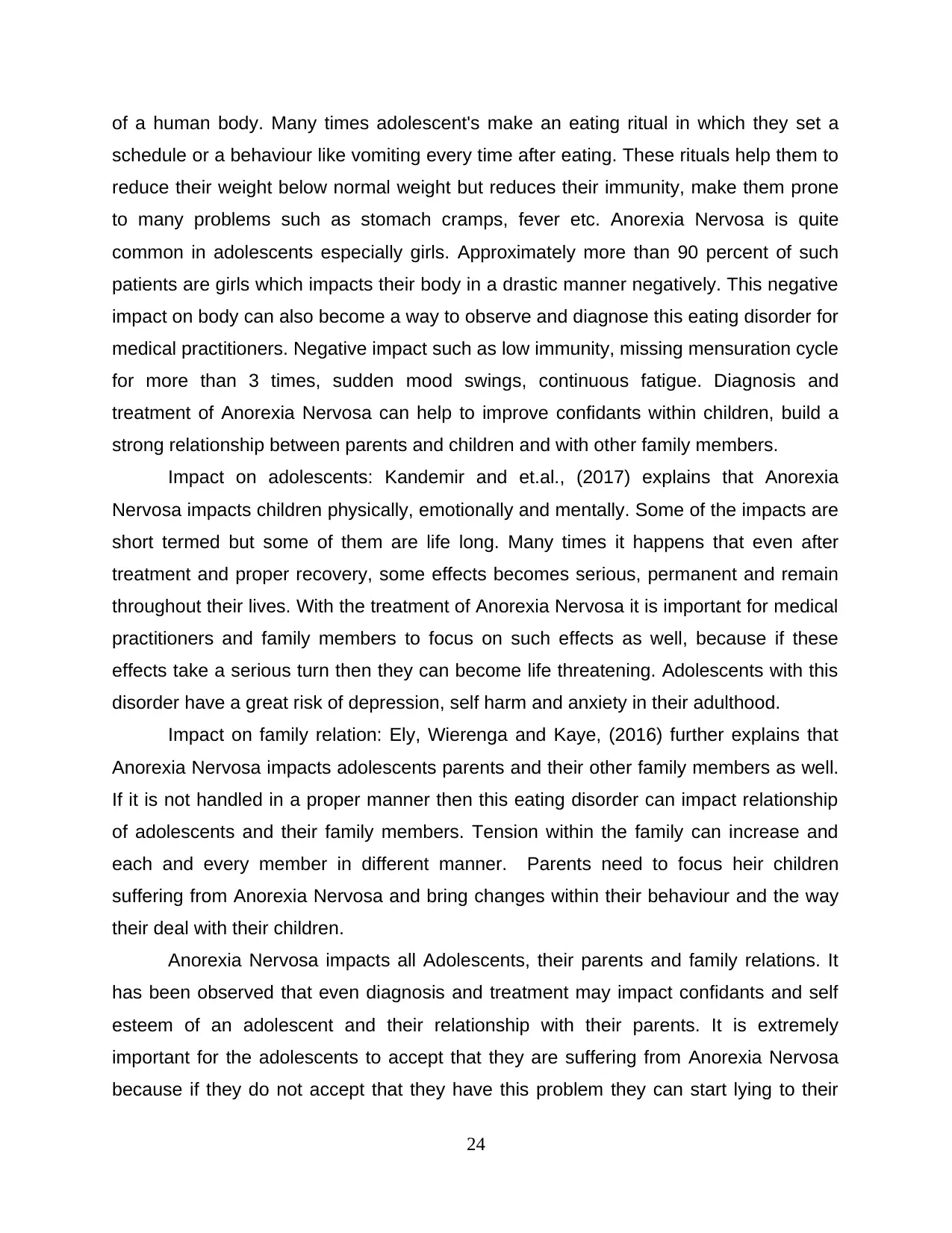
schedule or a behaviour like vomiting every time after eating. These rituals help them to
reduce their weight below normal weight but reduces their immunity, make them prone
to many problems such as stomach cramps, fever etc. Anorexia Nervosa is quite
common in adolescents especially girls. Approximately more than 90 percent of such
patients are girls which impacts their body in a drastic manner negatively. This negative
impact on body can also become a way to observe and diagnose this eating disorder for
medical practitioners. Negative impact such as low immunity, missing mensuration cycle
for more than 3 times, sudden mood swings, continuous fatigue. Diagnosis and
treatment of Anorexia Nervosa can help to improve confidants within children, build a
strong relationship between parents and children and with other family members.
Impact on adolescents: Kandemir and et.al., (2017) explains that Anorexia
Nervosa impacts children physically, emotionally and mentally. Some of the impacts are
short termed but some of them are life long. Many times it happens that even after
treatment and proper recovery, some effects becomes serious, permanent and remain
throughout their lives. With the treatment of Anorexia Nervosa it is important for medical
practitioners and family members to focus on such effects as well, because if these
effects take a serious turn then they can become life threatening. Adolescents with this
disorder have a great risk of depression, self harm and anxiety in their adulthood.
Impact on family relation: Ely, Wierenga and Kaye, (2016) further explains that
Anorexia Nervosa impacts adolescents parents and their other family members as well.
If it is not handled in a proper manner then this eating disorder can impact relationship
of adolescents and their family members. Tension within the family can increase and
each and every member in different manner. Parents need to focus heir children
suffering from Anorexia Nervosa and bring changes within their behaviour and the way
their deal with their children.
Anorexia Nervosa impacts all Adolescents, their parents and family relations. It
has been observed that even diagnosis and treatment may impact confidants and self
esteem of an adolescent and their relationship with their parents. It is extremely
important for the adolescents to accept that they are suffering from Anorexia Nervosa
because if they do not accept that they have this problem they can start lying to their
24
⊘ This is a preview!⊘
Do you want full access?
Subscribe today to unlock all pages.

Trusted by 1+ million students worldwide
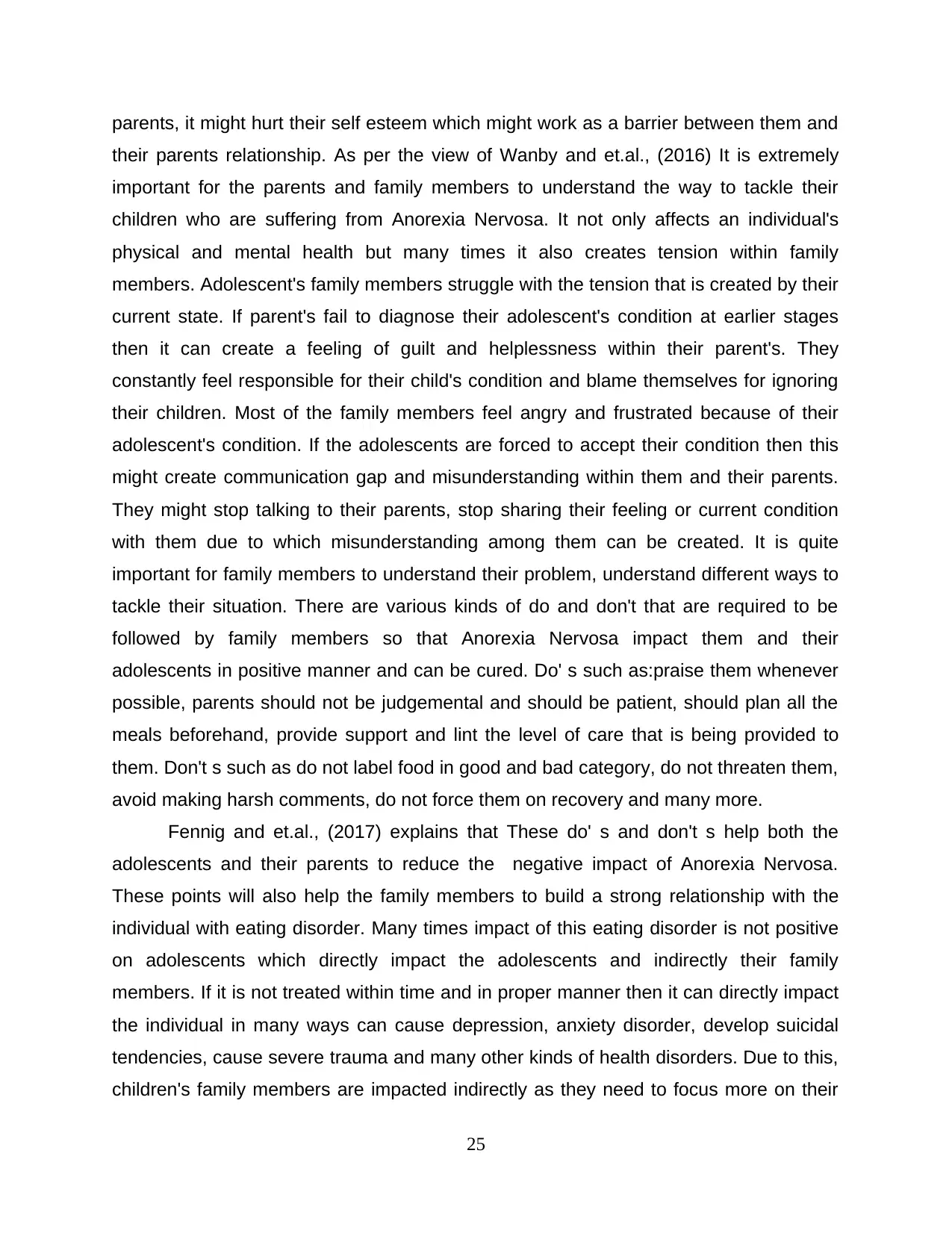
their parents relationship. As per the view of Wanby and et.al., (2016) It is extremely
important for the parents and family members to understand the way to tackle their
children who are suffering from Anorexia Nervosa. It not only affects an individual's
physical and mental health but many times it also creates tension within family
members. Adolescent's family members struggle with the tension that is created by their
current state. If parent's fail to diagnose their adolescent's condition at earlier stages
then it can create a feeling of guilt and helplessness within their parent's. They
constantly feel responsible for their child's condition and blame themselves for ignoring
their children. Most of the family members feel angry and frustrated because of their
adolescent's condition. If the adolescents are forced to accept their condition then this
might create communication gap and misunderstanding within them and their parents.
They might stop talking to their parents, stop sharing their feeling or current condition
with them due to which misunderstanding among them can be created. It is quite
important for family members to understand their problem, understand different ways to
tackle their situation. There are various kinds of do and don't that are required to be
followed by family members so that Anorexia Nervosa impact them and their
adolescents in positive manner and can be cured. Do' s such as:praise them whenever
possible, parents should not be judgemental and should be patient, should plan all the
meals beforehand, provide support and lint the level of care that is being provided to
them. Don't s such as do not label food in good and bad category, do not threaten them,
avoid making harsh comments, do not force them on recovery and many more.
Fennig and et.al., (2017) explains that These do' s and don't s help both the
adolescents and their parents to reduce the negative impact of Anorexia Nervosa.
These points will also help the family members to build a strong relationship with the
individual with eating disorder. Many times impact of this eating disorder is not positive
on adolescents which directly impact the adolescents and indirectly their family
members. If it is not treated within time and in proper manner then it can directly impact
the individual in many ways can cause depression, anxiety disorder, develop suicidal
tendencies, cause severe trauma and many other kinds of health disorders. Due to this,
children's family members are impacted indirectly as they need to focus more on their
25
Paraphrase This Document

tensed and helpless when they do not have any kind of solution to cure such issues
related to Anorexia Nervosa. This impact also increases roles and responsibilities of
parents as they need to focus more on their children's behaviour, eating habit, therapies
and treatment that is being provided to them. According to a case study Westwood and
Tchanturia, (2017) impact of Anorexia Nervosa on family members is equivalent to the
impact of adolescent's suffering from this eating disorder. It's impact can either
strengthen the bond between children and parents or can weaken it. Many times it also
impacts the overall behaviour or attitude of family members both in positive manner or
in negative manner. In positive manner it can develop feeling of sportiveness, caring
attitude, helping nature towards the individual with eating disorder which helps the
adolescents to overcome with this Anorexia Nervosa. In negative manner it can make
adolescents family members quite distant from them, avoid communicating with them,
develop frustration within the family members. Parents might feel responsible for their
current condition due to which they might ignore other family members like adolescents
siblings and other members. So it can be said that Anorexia Nervosa impact both
adolescents and their family members and relation both positively and negatively.
Article 3:
Engman-Bredvik S, Carballeira Suarez N, Levi R, Nilsson K. Multi-Family Therapy in
Anorexia Nervosa—A Qualitative Study of Parental Experiences. Eating
Disorders 2016;24(2): 186-197
Theme 1: Family based therapy (FBT) treatment for Anorexia Nervosa
FBT is one of the effective treatment choice for the young adults and
adolescents. In this treatment approach parents are considered as the major force to
facilitate recovery of AN patients. FBT includes different phases which aims at
encouraging adolescent child to change their perspective towards weight gain. In the
first phase of FBT parents and therapists works in collaboration so that alternative ways
to re-feed the child can be determined (Tan, Hope and Stewart, 2003). It will assist in
integrating parent control in the weight restoration. With the gradual improvement in the
second phase parents try to lower their control so that adolescent's can understand their
own responsibility of eating practices.
26
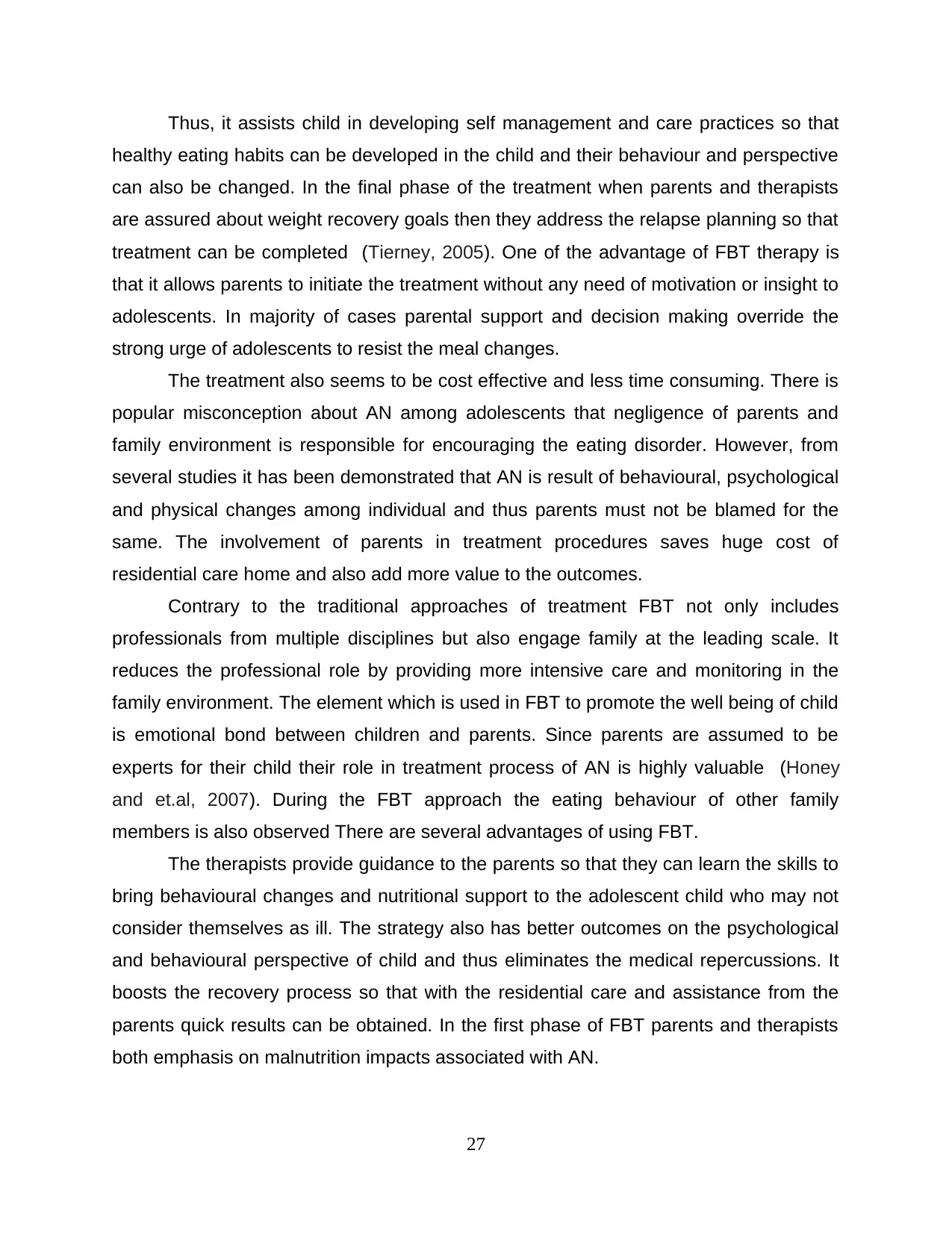
healthy eating habits can be developed in the child and their behaviour and perspective
can also be changed. In the final phase of the treatment when parents and therapists
are assured about weight recovery goals then they address the relapse planning so that
treatment can be completed (Tierney, 2005). One of the advantage of FBT therapy is
that it allows parents to initiate the treatment without any need of motivation or insight to
adolescents. In majority of cases parental support and decision making override the
strong urge of adolescents to resist the meal changes.
The treatment also seems to be cost effective and less time consuming. There is
popular misconception about AN among adolescents that negligence of parents and
family environment is responsible for encouraging the eating disorder. However, from
several studies it has been demonstrated that AN is result of behavioural, psychological
and physical changes among individual and thus parents must not be blamed for the
same. The involvement of parents in treatment procedures saves huge cost of
residential care home and also add more value to the outcomes.
Contrary to the traditional approaches of treatment FBT not only includes
professionals from multiple disciplines but also engage family at the leading scale. It
reduces the professional role by providing more intensive care and monitoring in the
family environment. The element which is used in FBT to promote the well being of child
is emotional bond between children and parents. Since parents are assumed to be
experts for their child their role in treatment process of AN is highly valuable (Honey
and et.al, 2007). During the FBT approach the eating behaviour of other family
members is also observed There are several advantages of using FBT.
The therapists provide guidance to the parents so that they can learn the skills to
bring behavioural changes and nutritional support to the adolescent child who may not
consider themselves as ill. The strategy also has better outcomes on the psychological
and behavioural perspective of child and thus eliminates the medical repercussions. It
boosts the recovery process so that with the residential care and assistance from the
parents quick results can be obtained. In the first phase of FBT parents and therapists
both emphasis on malnutrition impacts associated with AN.
27
⊘ This is a preview!⊘
Do you want full access?
Subscribe today to unlock all pages.

Trusted by 1+ million students worldwide
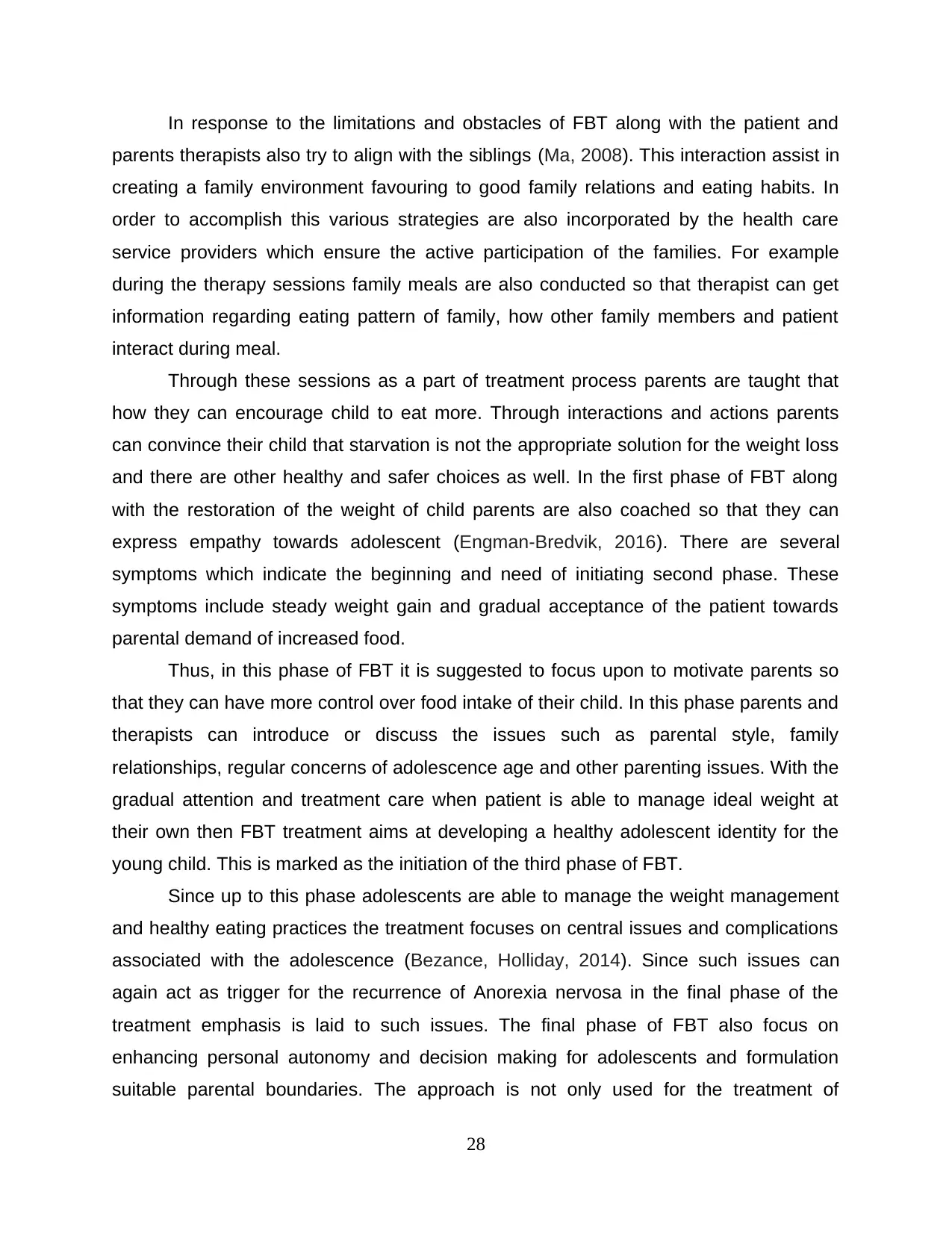
parents therapists also try to align with the siblings (Ma, 2008). This interaction assist in
creating a family environment favouring to good family relations and eating habits. In
order to accomplish this various strategies are also incorporated by the health care
service providers which ensure the active participation of the families. For example
during the therapy sessions family meals are also conducted so that therapist can get
information regarding eating pattern of family, how other family members and patient
interact during meal.
Through these sessions as a part of treatment process parents are taught that
how they can encourage child to eat more. Through interactions and actions parents
can convince their child that starvation is not the appropriate solution for the weight loss
and there are other healthy and safer choices as well. In the first phase of FBT along
with the restoration of the weight of child parents are also coached so that they can
express empathy towards adolescent (Engman-Bredvik, 2016). There are several
symptoms which indicate the beginning and need of initiating second phase. These
symptoms include steady weight gain and gradual acceptance of the patient towards
parental demand of increased food.
Thus, in this phase of FBT it is suggested to focus upon to motivate parents so
that they can have more control over food intake of their child. In this phase parents and
therapists can introduce or discuss the issues such as parental style, family
relationships, regular concerns of adolescence age and other parenting issues. With the
gradual attention and treatment care when patient is able to manage ideal weight at
their own then FBT treatment aims at developing a healthy adolescent identity for the
young child. This is marked as the initiation of the third phase of FBT.
Since up to this phase adolescents are able to manage the weight management
and healthy eating practices the treatment focuses on central issues and complications
associated with the adolescence (Bezance, Holliday, 2014). Since such issues can
again act as trigger for the recurrence of Anorexia nervosa in the final phase of the
treatment emphasis is laid to such issues. The final phase of FBT also focus on
enhancing personal autonomy and decision making for adolescents and formulation
suitable parental boundaries. The approach is not only used for the treatment of
28
Paraphrase This Document
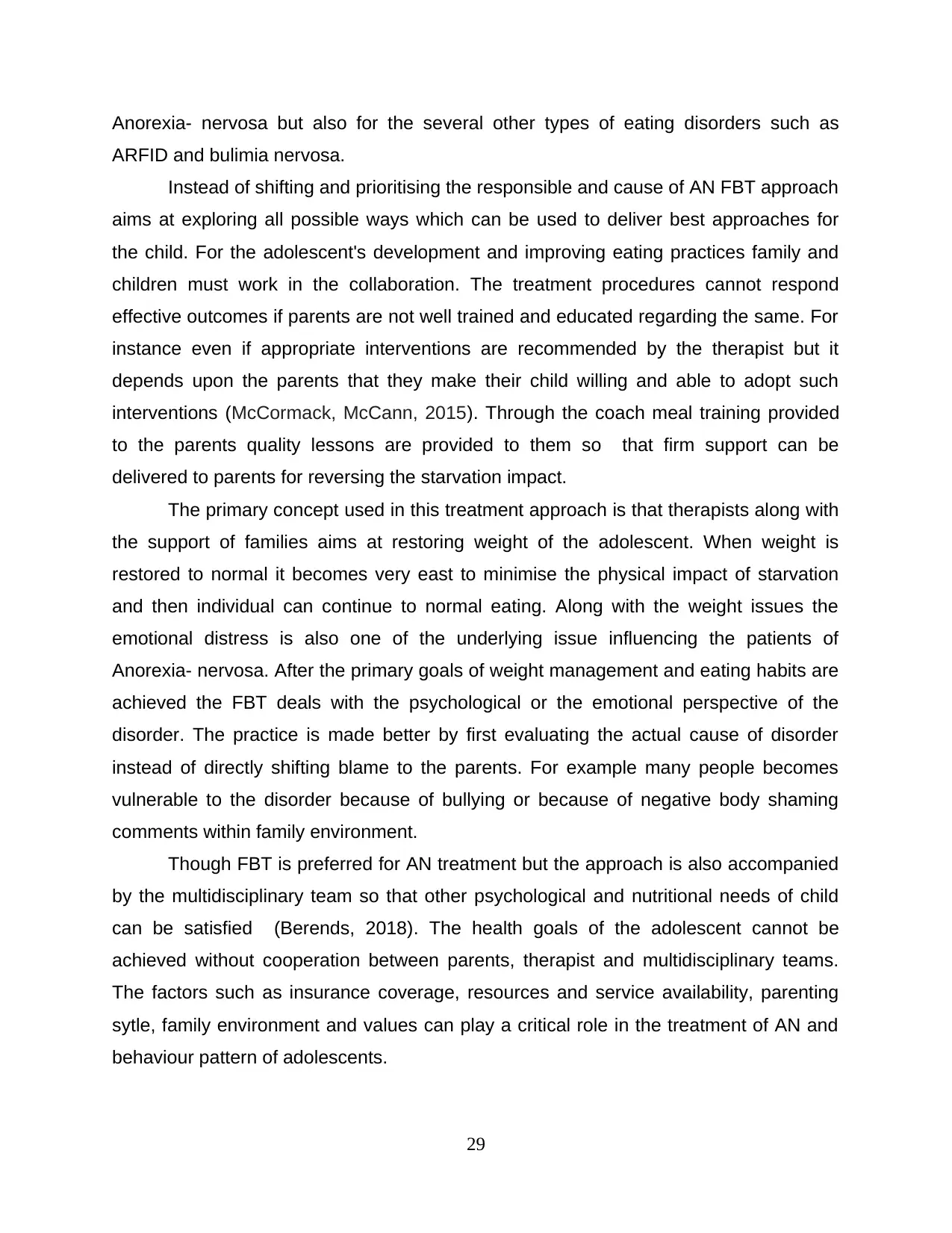
ARFID and bulimia nervosa.
Instead of shifting and prioritising the responsible and cause of AN FBT approach
aims at exploring all possible ways which can be used to deliver best approaches for
the child. For the adolescent's development and improving eating practices family and
children must work in the collaboration. The treatment procedures cannot respond
effective outcomes if parents are not well trained and educated regarding the same. For
instance even if appropriate interventions are recommended by the therapist but it
depends upon the parents that they make their child willing and able to adopt such
interventions (McCormack, McCann, 2015). Through the coach meal training provided
to the parents quality lessons are provided to them so that firm support can be
delivered to parents for reversing the starvation impact.
The primary concept used in this treatment approach is that therapists along with
the support of families aims at restoring weight of the adolescent. When weight is
restored to normal it becomes very east to minimise the physical impact of starvation
and then individual can continue to normal eating. Along with the weight issues the
emotional distress is also one of the underlying issue influencing the patients of
Anorexia- nervosa. After the primary goals of weight management and eating habits are
achieved the FBT deals with the psychological or the emotional perspective of the
disorder. The practice is made better by first evaluating the actual cause of disorder
instead of directly shifting blame to the parents. For example many people becomes
vulnerable to the disorder because of bullying or because of negative body shaming
comments within family environment.
Though FBT is preferred for AN treatment but the approach is also accompanied
by the multidisciplinary team so that other psychological and nutritional needs of child
can be satisfied (Berends, 2018). The health goals of the adolescent cannot be
achieved without cooperation between parents, therapist and multidisciplinary teams.
The factors such as insurance coverage, resources and service availability, parenting
sytle, family environment and values can play a critical role in the treatment of AN and
behaviour pattern of adolescents.
29
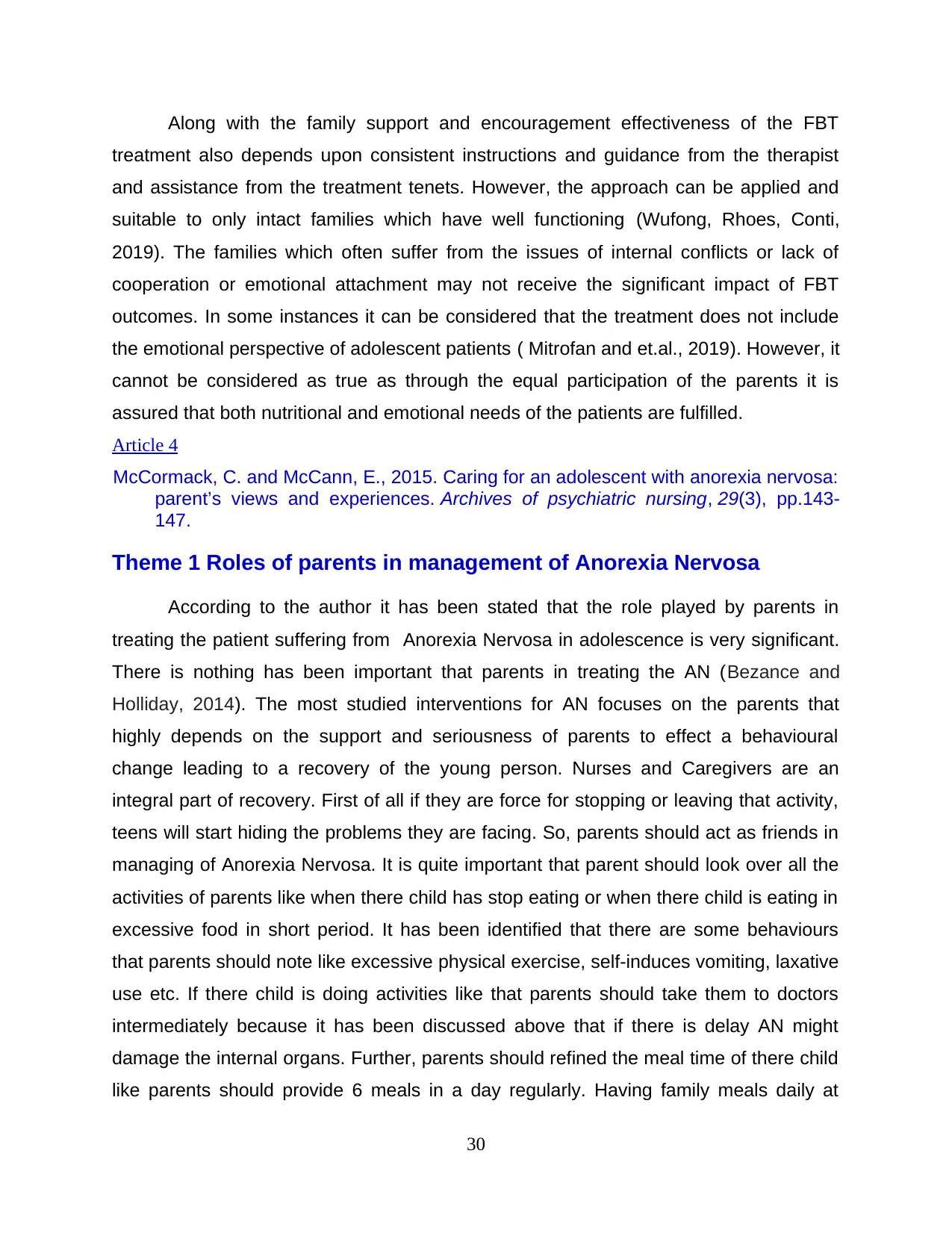
treatment also depends upon consistent instructions and guidance from the therapist
and assistance from the treatment tenets. However, the approach can be applied and
suitable to only intact families which have well functioning (Wufong, Rhoes, Conti,
2019). The families which often suffer from the issues of internal conflicts or lack of
cooperation or emotional attachment may not receive the significant impact of FBT
outcomes. In some instances it can be considered that the treatment does not include
the emotional perspective of adolescent patients ( Mitrofan and et.al., 2019). However, it
cannot be considered as true as through the equal participation of the parents it is
assured that both nutritional and emotional needs of the patients are fulfilled.
Article 4
McCormack, C. and McCann, E., 2015. Caring for an adolescent with anorexia nervosa:
parent’s views and experiences. Archives of psychiatric nursing, 29(3), pp.143-
147.
Theme 1 Roles of parents in management of Anorexia Nervosa
According to the author it has been stated that the role played by parents in
treating the patient suffering from Anorexia Nervosa in adolescence is very significant.
There is nothing has been important that parents in treating the AN (Bezance and
Holliday, 2014). The most studied interventions for AN focuses on the parents that
highly depends on the support and seriousness of parents to effect a behavioural
change leading to a recovery of the young person. Nurses and Caregivers are an
integral part of recovery. First of all if they are force for stopping or leaving that activity,
teens will start hiding the problems they are facing. So, parents should act as friends in
managing of Anorexia Nervosa. It is quite important that parent should look over all the
activities of parents like when there child has stop eating or when there child is eating in
excessive food in short period. It has been identified that there are some behaviours
that parents should note like excessive physical exercise, self-induces vomiting, laxative
use etc. If there child is doing activities like that parents should take them to doctors
intermediately because it has been discussed above that if there is delay AN might
damage the internal organs. Further, parents should refined the meal time of there child
like parents should provide 6 meals in a day regularly. Having family meals daily at
30
⊘ This is a preview!⊘
Do you want full access?
Subscribe today to unlock all pages.

Trusted by 1+ million students worldwide
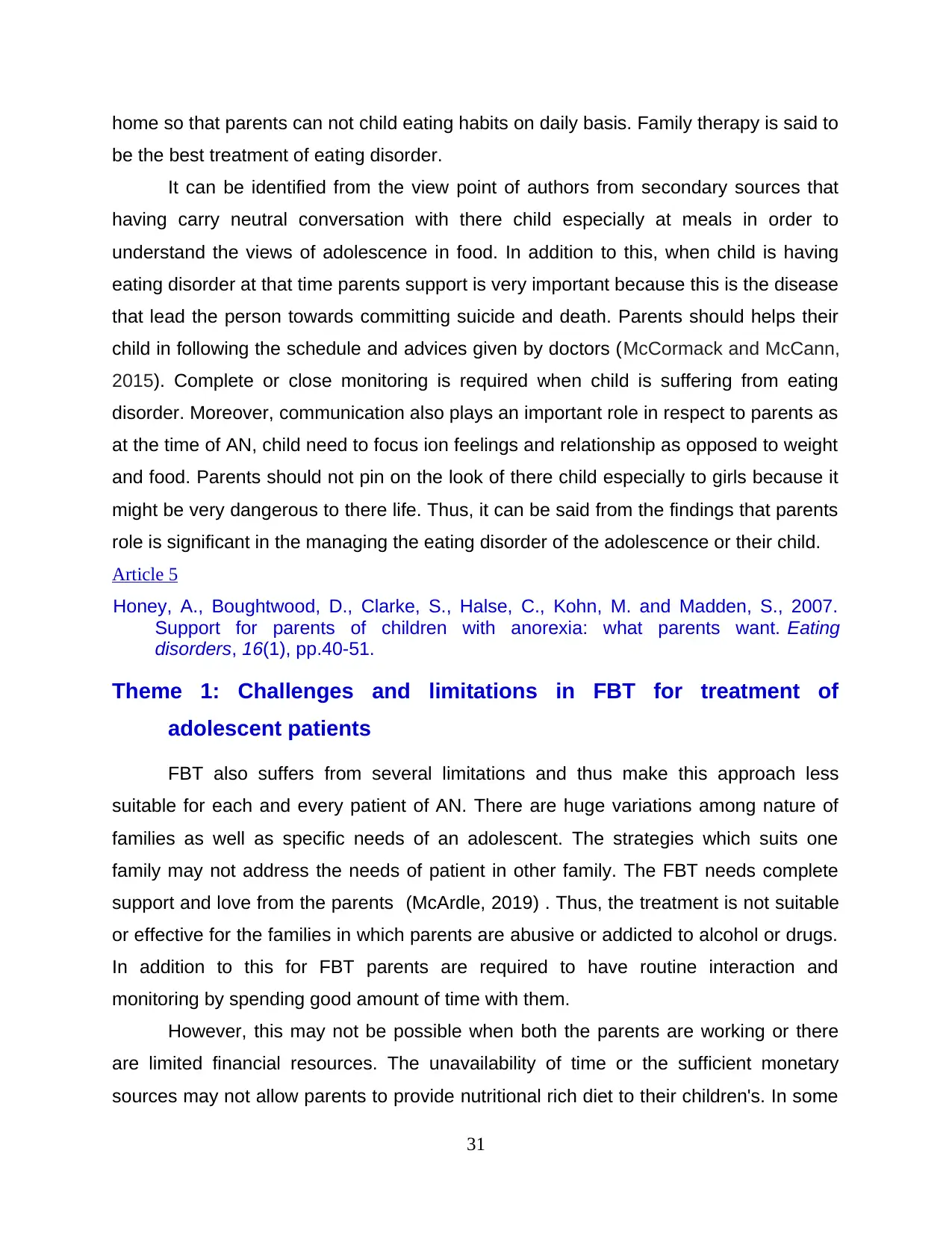
be the best treatment of eating disorder.
It can be identified from the view point of authors from secondary sources that
having carry neutral conversation with there child especially at meals in order to
understand the views of adolescence in food. In addition to this, when child is having
eating disorder at that time parents support is very important because this is the disease
that lead the person towards committing suicide and death. Parents should helps their
child in following the schedule and advices given by doctors (McCormack and McCann,
2015). Complete or close monitoring is required when child is suffering from eating
disorder. Moreover, communication also plays an important role in respect to parents as
at the time of AN, child need to focus ion feelings and relationship as opposed to weight
and food. Parents should not pin on the look of there child especially to girls because it
might be very dangerous to there life. Thus, it can be said from the findings that parents
role is significant in the managing the eating disorder of the adolescence or their child.
Article 5
Honey, A., Boughtwood, D., Clarke, S., Halse, C., Kohn, M. and Madden, S., 2007.
Support for parents of children with anorexia: what parents want. Eating
disorders, 16(1), pp.40-51.
Theme 1: Challenges and limitations in FBT for treatment of
adolescent patients
FBT also suffers from several limitations and thus make this approach less
suitable for each and every patient of AN. There are huge variations among nature of
families as well as specific needs of an adolescent. The strategies which suits one
family may not address the needs of patient in other family. The FBT needs complete
support and love from the parents (McArdle, 2019) . Thus, the treatment is not suitable
or effective for the families in which parents are abusive or addicted to alcohol or drugs.
In addition to this for FBT parents are required to have routine interaction and
monitoring by spending good amount of time with them.
However, this may not be possible when both the parents are working or there
are limited financial resources. The unavailability of time or the sufficient monetary
sources may not allow parents to provide nutritional rich diet to their children's. In some
31
Paraphrase This Document

suicide attempts. For such patients FBT may prove to be slower and unsafe. The parent
child relationship is also one of the challenging aspect influencing its effectiveness. For
instance there are many adolescents who does share good bond with the parents
(Medway, 2019). The children may be too independent or the old enough to accept and
encourage the parental support.
In such situations interventions and care from the parents may seem disturbing
to the child and they may show more rebelling attitude. Implementing FBT based
interventions for such families can be quite complex. The different perceptions and
personal differences among children and parents can also lead to several conflicts in
adaptation of treatment strategy. When adolescents do not have trust or understanding
with their parents then they must not show agreement to the interventions and principles
of FBT. In such situations it becomes very essential to first resolve the emotional
differences so that families can easily incorporate in the decision making of child. In
many circumstances the resource availability is also considered as the key obstacle in
treatment process.
The parents may not have sufficient resources to provide adequate nutritional
food and therapeutic care services. The lack of awareness and limited knowledge of the
parents can also serve as the influential barrier. For instance in the engaged working life
parents may not have time to interact with their child (Byrne and et.al., 2015). During
adolescents period when child is undergoing through several body changes there is
need for parents to support their children. However due to communication gap with the
child parents fails to recognise the symptoms as well a treatment needs of Anorexia
Nervosa. In such families it may not be possible to refer FBT as there is lack of family
commitment which is essential for the quality outcomes.
The lack of knowledge can also restrict the possibility to incorporate FBT into
practice. When parents themselves are not aware of the FBT principles then they
cannot develop a healthy family environment for their adolescent child. Another barrier
which challenges the implementation of FBT is the lack of training and supervision.
Since nature of every family is different health professionals are required to be highly
32
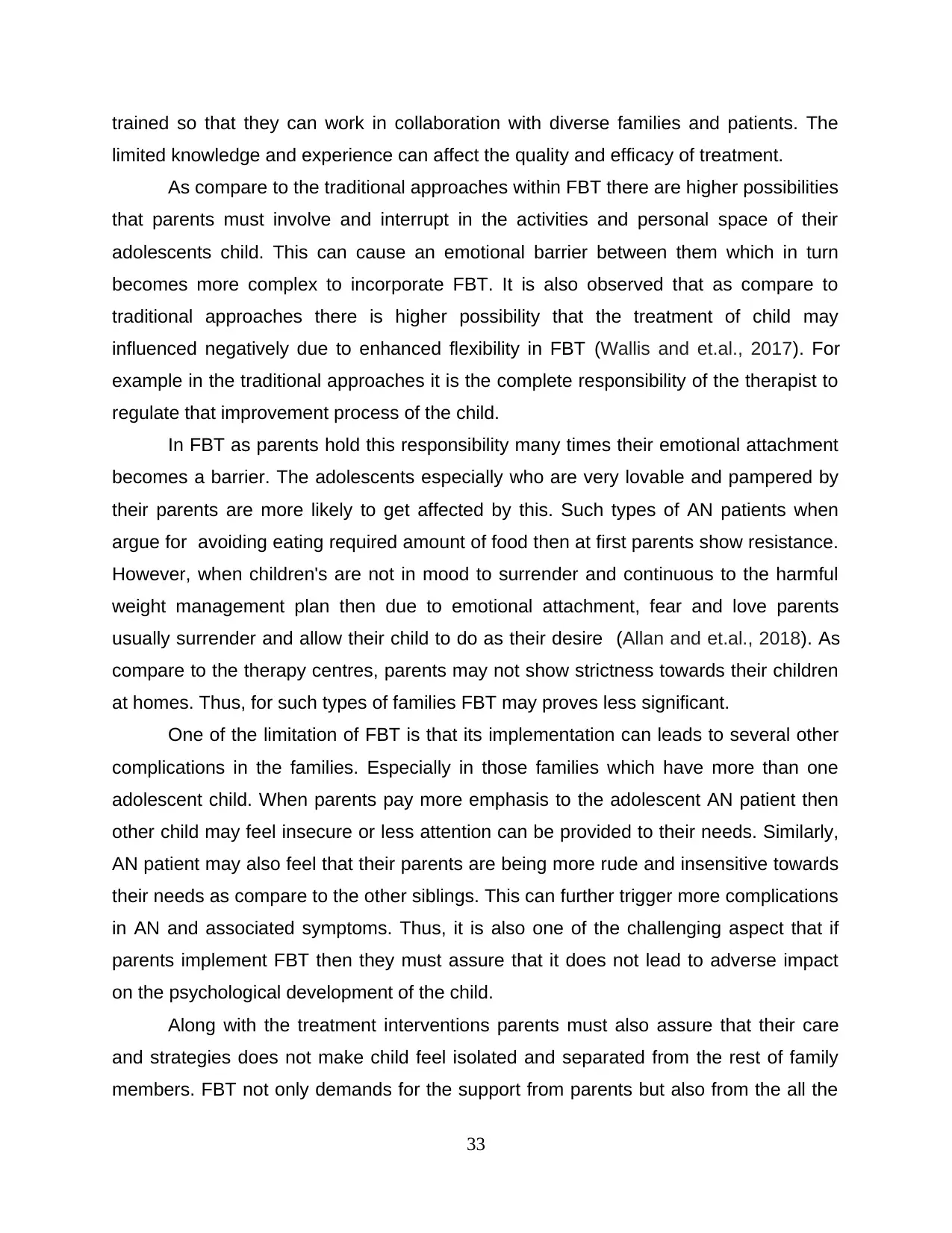
limited knowledge and experience can affect the quality and efficacy of treatment.
As compare to the traditional approaches within FBT there are higher possibilities
that parents must involve and interrupt in the activities and personal space of their
adolescents child. This can cause an emotional barrier between them which in turn
becomes more complex to incorporate FBT. It is also observed that as compare to
traditional approaches there is higher possibility that the treatment of child may
influenced negatively due to enhanced flexibility in FBT (Wallis and et.al., 2017). For
example in the traditional approaches it is the complete responsibility of the therapist to
regulate that improvement process of the child.
In FBT as parents hold this responsibility many times their emotional attachment
becomes a barrier. The adolescents especially who are very lovable and pampered by
their parents are more likely to get affected by this. Such types of AN patients when
argue for avoiding eating required amount of food then at first parents show resistance.
However, when children's are not in mood to surrender and continuous to the harmful
weight management plan then due to emotional attachment, fear and love parents
usually surrender and allow their child to do as their desire (Allan and et.al., 2018). As
compare to the therapy centres, parents may not show strictness towards their children
at homes. Thus, for such types of families FBT may proves less significant.
One of the limitation of FBT is that its implementation can leads to several other
complications in the families. Especially in those families which have more than one
adolescent child. When parents pay more emphasis to the adolescent AN patient then
other child may feel insecure or less attention can be provided to their needs. Similarly,
AN patient may also feel that their parents are being more rude and insensitive towards
their needs as compare to the other siblings. This can further trigger more complications
in AN and associated symptoms. Thus, it is also one of the challenging aspect that if
parents implement FBT then they must assure that it does not lead to adverse impact
on the psychological development of the child.
Along with the treatment interventions parents must also assure that their care
and strategies does not make child feel isolated and separated from the rest of family
members. FBT not only demands for the support from parents but also from the all the
33
⊘ This is a preview!⊘
Do you want full access?
Subscribe today to unlock all pages.

Trusted by 1+ million students worldwide
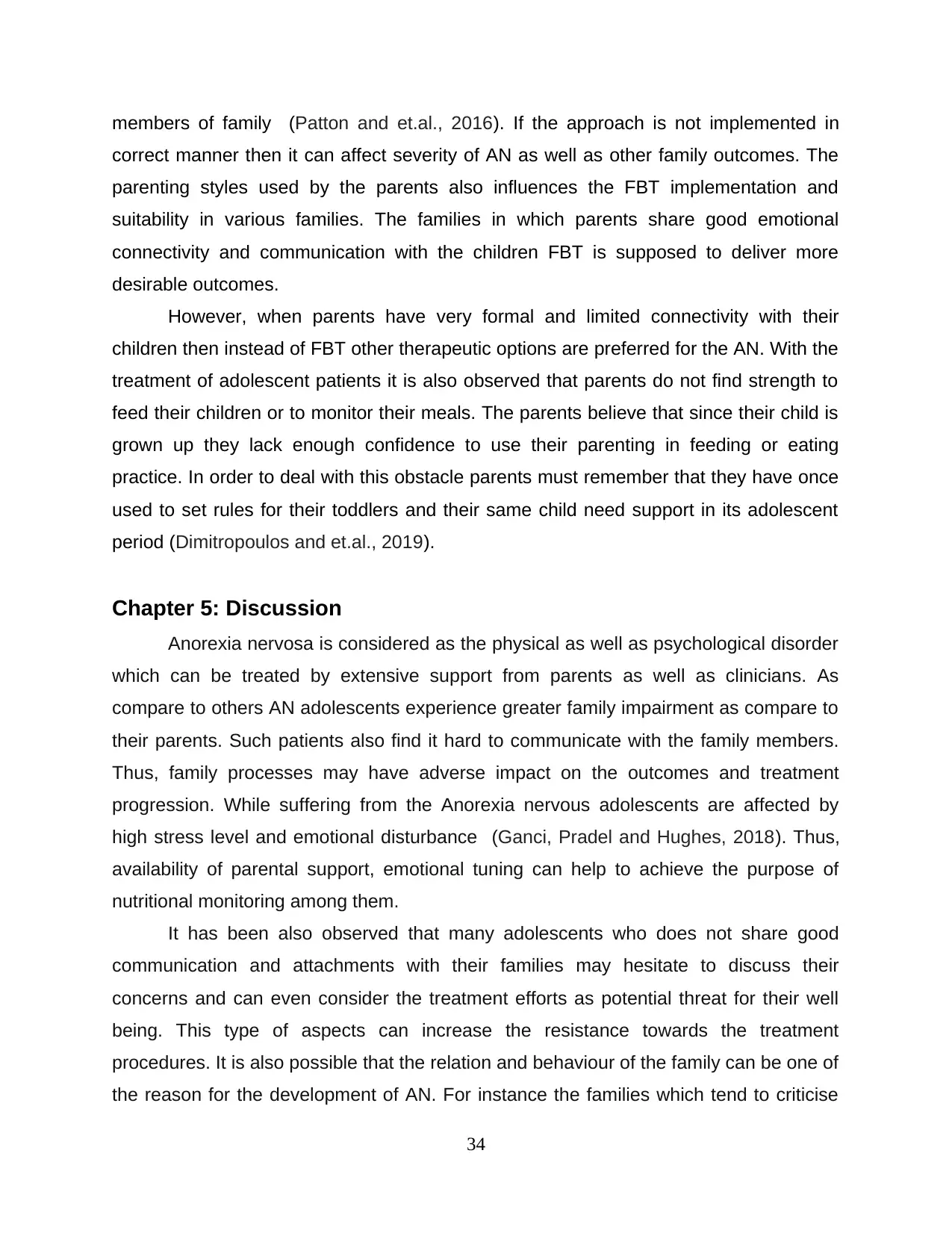
correct manner then it can affect severity of AN as well as other family outcomes. The
parenting styles used by the parents also influences the FBT implementation and
suitability in various families. The families in which parents share good emotional
connectivity and communication with the children FBT is supposed to deliver more
desirable outcomes.
However, when parents have very formal and limited connectivity with their
children then instead of FBT other therapeutic options are preferred for the AN. With the
treatment of adolescent patients it is also observed that parents do not find strength to
feed their children or to monitor their meals. The parents believe that since their child is
grown up they lack enough confidence to use their parenting in feeding or eating
practice. In order to deal with this obstacle parents must remember that they have once
used to set rules for their toddlers and their same child need support in its adolescent
period (Dimitropoulos and et.al., 2019).
Chapter 5: Discussion
Anorexia nervosa is considered as the physical as well as psychological disorder
which can be treated by extensive support from parents as well as clinicians. As
compare to others AN adolescents experience greater family impairment as compare to
their parents. Such patients also find it hard to communicate with the family members.
Thus, family processes may have adverse impact on the outcomes and treatment
progression. While suffering from the Anorexia nervous adolescents are affected by
high stress level and emotional disturbance (Ganci, Pradel and Hughes, 2018). Thus,
availability of parental support, emotional tuning can help to achieve the purpose of
nutritional monitoring among them.
It has been also observed that many adolescents who does not share good
communication and attachments with their families may hesitate to discuss their
concerns and can even consider the treatment efforts as potential threat for their well
being. This type of aspects can increase the resistance towards the treatment
procedures. It is also possible that the relation and behaviour of the family can be one of
the reason for the development of AN. For instance the families which tend to criticise
34
Paraphrase This Document
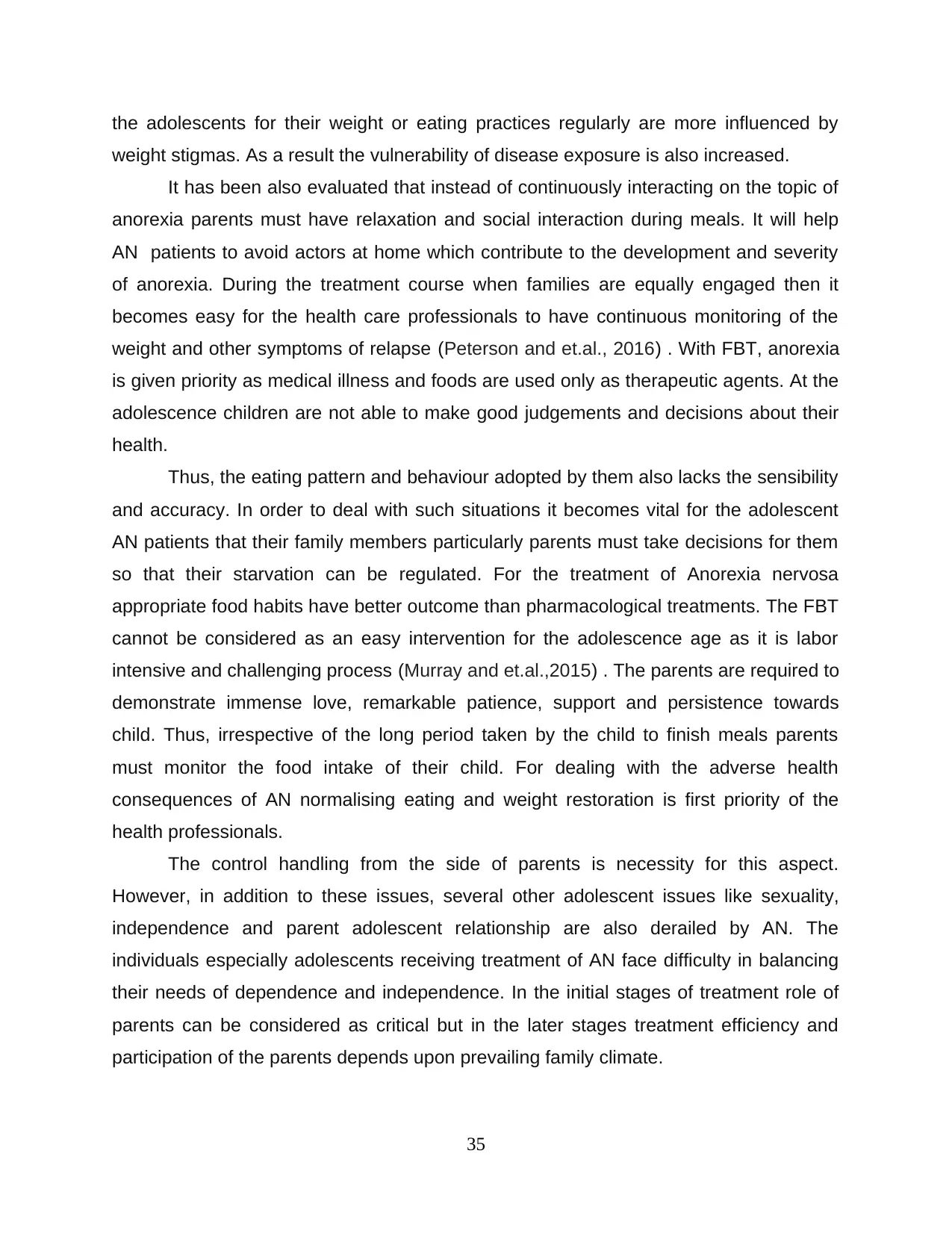
weight stigmas. As a result the vulnerability of disease exposure is also increased.
It has been also evaluated that instead of continuously interacting on the topic of
anorexia parents must have relaxation and social interaction during meals. It will help
AN patients to avoid actors at home which contribute to the development and severity
of anorexia. During the treatment course when families are equally engaged then it
becomes easy for the health care professionals to have continuous monitoring of the
weight and other symptoms of relapse (Peterson and et.al., 2016) . With FBT, anorexia
is given priority as medical illness and foods are used only as therapeutic agents. At the
adolescence children are not able to make good judgements and decisions about their
health.
Thus, the eating pattern and behaviour adopted by them also lacks the sensibility
and accuracy. In order to deal with such situations it becomes vital for the adolescent
AN patients that their family members particularly parents must take decisions for them
so that their starvation can be regulated. For the treatment of Anorexia nervosa
appropriate food habits have better outcome than pharmacological treatments. The FBT
cannot be considered as an easy intervention for the adolescence age as it is labor
intensive and challenging process (Murray and et.al.,2015) . The parents are required to
demonstrate immense love, remarkable patience, support and persistence towards
child. Thus, irrespective of the long period taken by the child to finish meals parents
must monitor the food intake of their child. For dealing with the adverse health
consequences of AN normalising eating and weight restoration is first priority of the
health professionals.
The control handling from the side of parents is necessity for this aspect.
However, in addition to these issues, several other adolescent issues like sexuality,
independence and parent adolescent relationship are also derailed by AN. The
individuals especially adolescents receiving treatment of AN face difficulty in balancing
their needs of dependence and independence. In the initial stages of treatment role of
parents can be considered as critical but in the later stages treatment efficiency and
participation of the parents depends upon prevailing family climate.
35
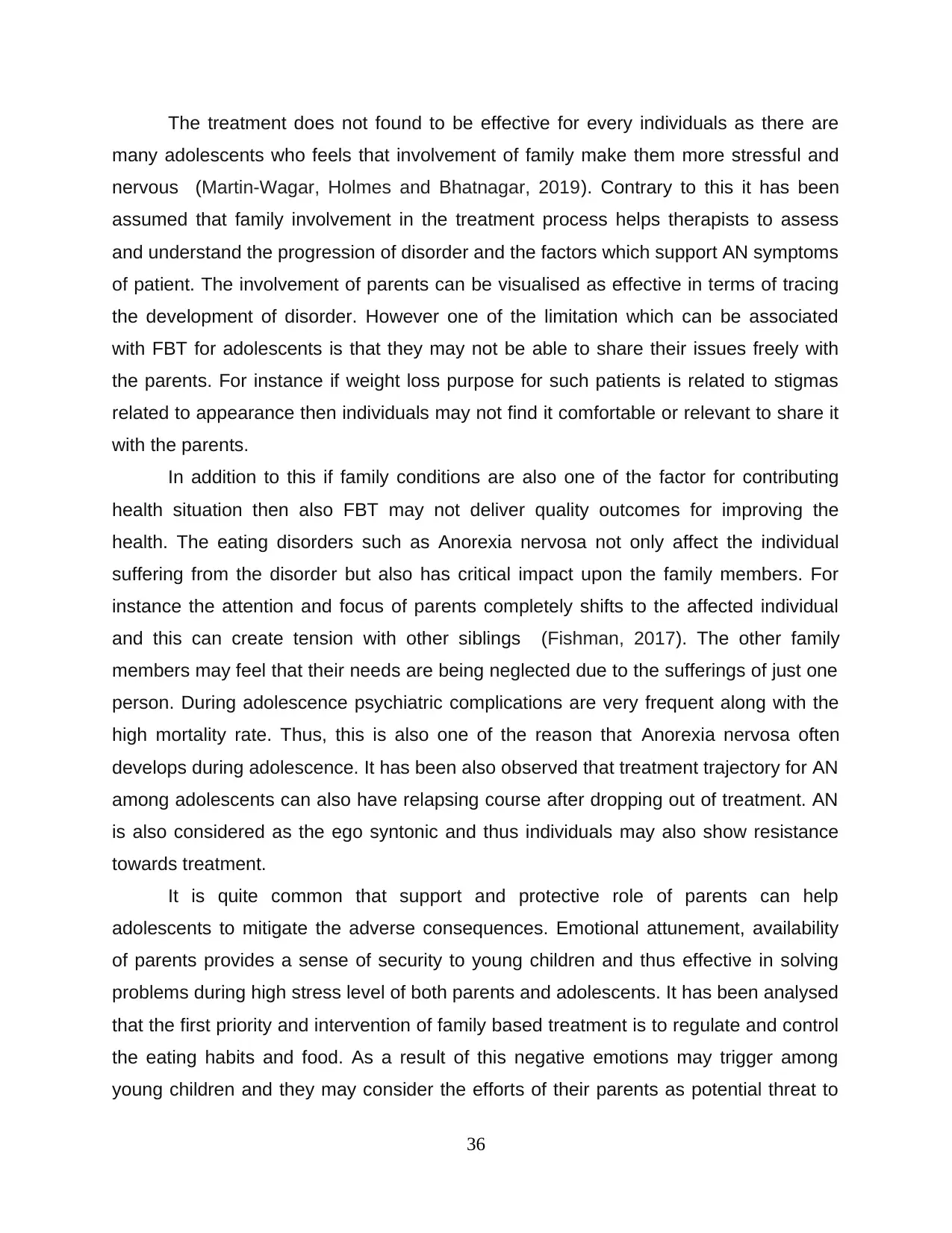
many adolescents who feels that involvement of family make them more stressful and
nervous (Martin-Wagar, Holmes and Bhatnagar, 2019). Contrary to this it has been
assumed that family involvement in the treatment process helps therapists to assess
and understand the progression of disorder and the factors which support AN symptoms
of patient. The involvement of parents can be visualised as effective in terms of tracing
the development of disorder. However one of the limitation which can be associated
with FBT for adolescents is that they may not be able to share their issues freely with
the parents. For instance if weight loss purpose for such patients is related to stigmas
related to appearance then individuals may not find it comfortable or relevant to share it
with the parents.
In addition to this if family conditions are also one of the factor for contributing
health situation then also FBT may not deliver quality outcomes for improving the
health. The eating disorders such as Anorexia nervosa not only affect the individual
suffering from the disorder but also has critical impact upon the family members. For
instance the attention and focus of parents completely shifts to the affected individual
and this can create tension with other siblings (Fishman, 2017). The other family
members may feel that their needs are being neglected due to the sufferings of just one
person. During adolescence psychiatric complications are very frequent along with the
high mortality rate. Thus, this is also one of the reason that Anorexia nervosa often
develops during adolescence. It has been also observed that treatment trajectory for AN
among adolescents can also have relapsing course after dropping out of treatment. AN
is also considered as the ego syntonic and thus individuals may also show resistance
towards treatment.
It is quite common that support and protective role of parents can help
adolescents to mitigate the adverse consequences. Emotional attunement, availability
of parents provides a sense of security to young children and thus effective in solving
problems during high stress level of both parents and adolescents. It has been analysed
that the first priority and intervention of family based treatment is to regulate and control
the eating habits and food. As a result of this negative emotions may trigger among
young children and they may consider the efforts of their parents as potential threat to
36
⊘ This is a preview!⊘
Do you want full access?
Subscribe today to unlock all pages.

Trusted by 1+ million students worldwide
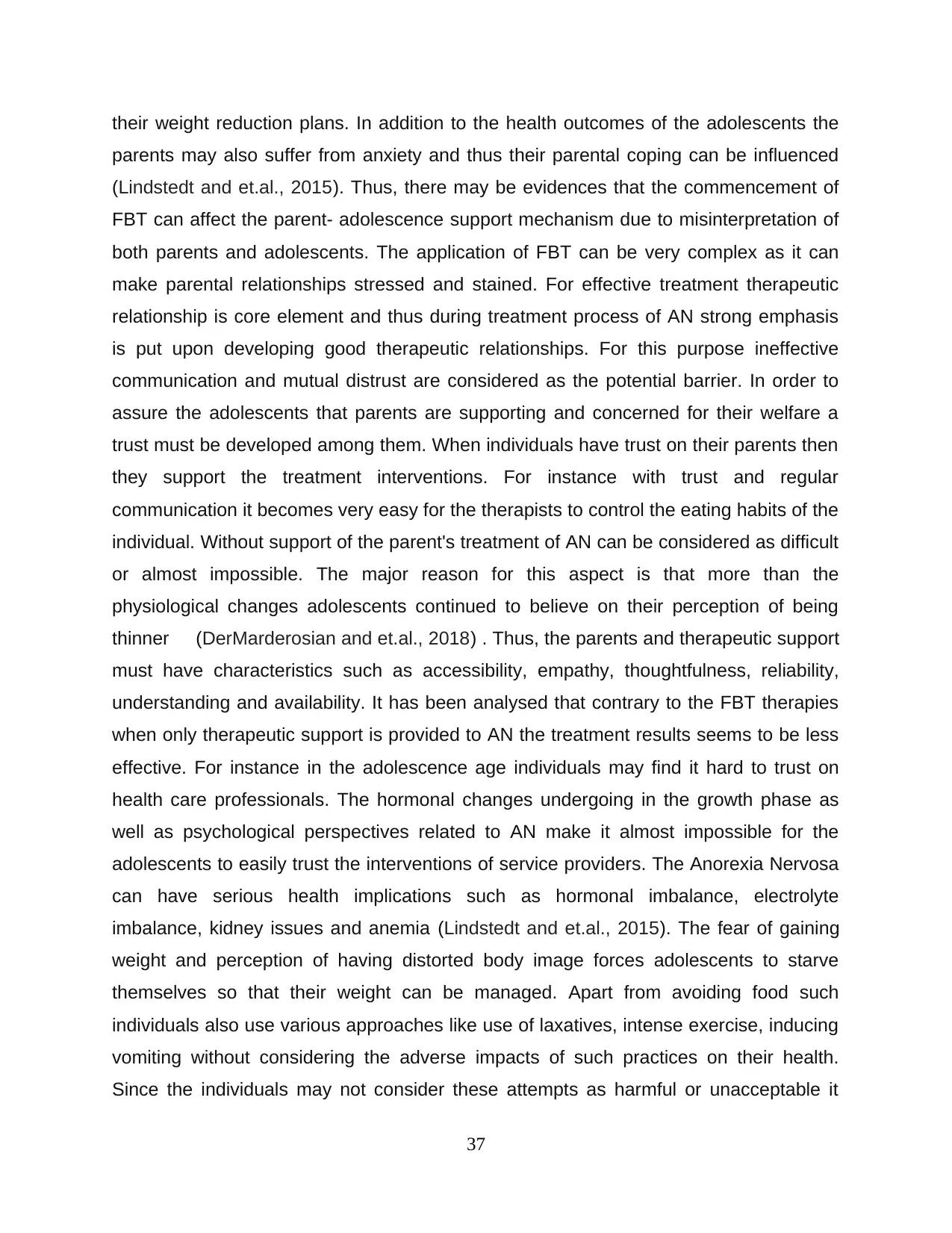
parents may also suffer from anxiety and thus their parental coping can be influenced
(Lindstedt and et.al., 2015). Thus, there may be evidences that the commencement of
FBT can affect the parent- adolescence support mechanism due to misinterpretation of
both parents and adolescents. The application of FBT can be very complex as it can
make parental relationships stressed and stained. For effective treatment therapeutic
relationship is core element and thus during treatment process of AN strong emphasis
is put upon developing good therapeutic relationships. For this purpose ineffective
communication and mutual distrust are considered as the potential barrier. In order to
assure the adolescents that parents are supporting and concerned for their welfare a
trust must be developed among them. When individuals have trust on their parents then
they support the treatment interventions. For instance with trust and regular
communication it becomes very easy for the therapists to control the eating habits of the
individual. Without support of the parent's treatment of AN can be considered as difficult
or almost impossible. The major reason for this aspect is that more than the
physiological changes adolescents continued to believe on their perception of being
thinner (DerMarderosian and et.al., 2018) . Thus, the parents and therapeutic support
must have characteristics such as accessibility, empathy, thoughtfulness, reliability,
understanding and availability. It has been analysed that contrary to the FBT therapies
when only therapeutic support is provided to AN the treatment results seems to be less
effective. For instance in the adolescence age individuals may find it hard to trust on
health care professionals. The hormonal changes undergoing in the growth phase as
well as psychological perspectives related to AN make it almost impossible for the
adolescents to easily trust the interventions of service providers. The Anorexia Nervosa
can have serious health implications such as hormonal imbalance, electrolyte
imbalance, kidney issues and anemia (Lindstedt and et.al., 2015). The fear of gaining
weight and perception of having distorted body image forces adolescents to starve
themselves so that their weight can be managed. Apart from avoiding food such
individuals also use various approaches like use of laxatives, intense exercise, inducing
vomiting without considering the adverse impacts of such practices on their health.
Since the individuals may not consider these attempts as harmful or unacceptable it
37
Paraphrase This Document
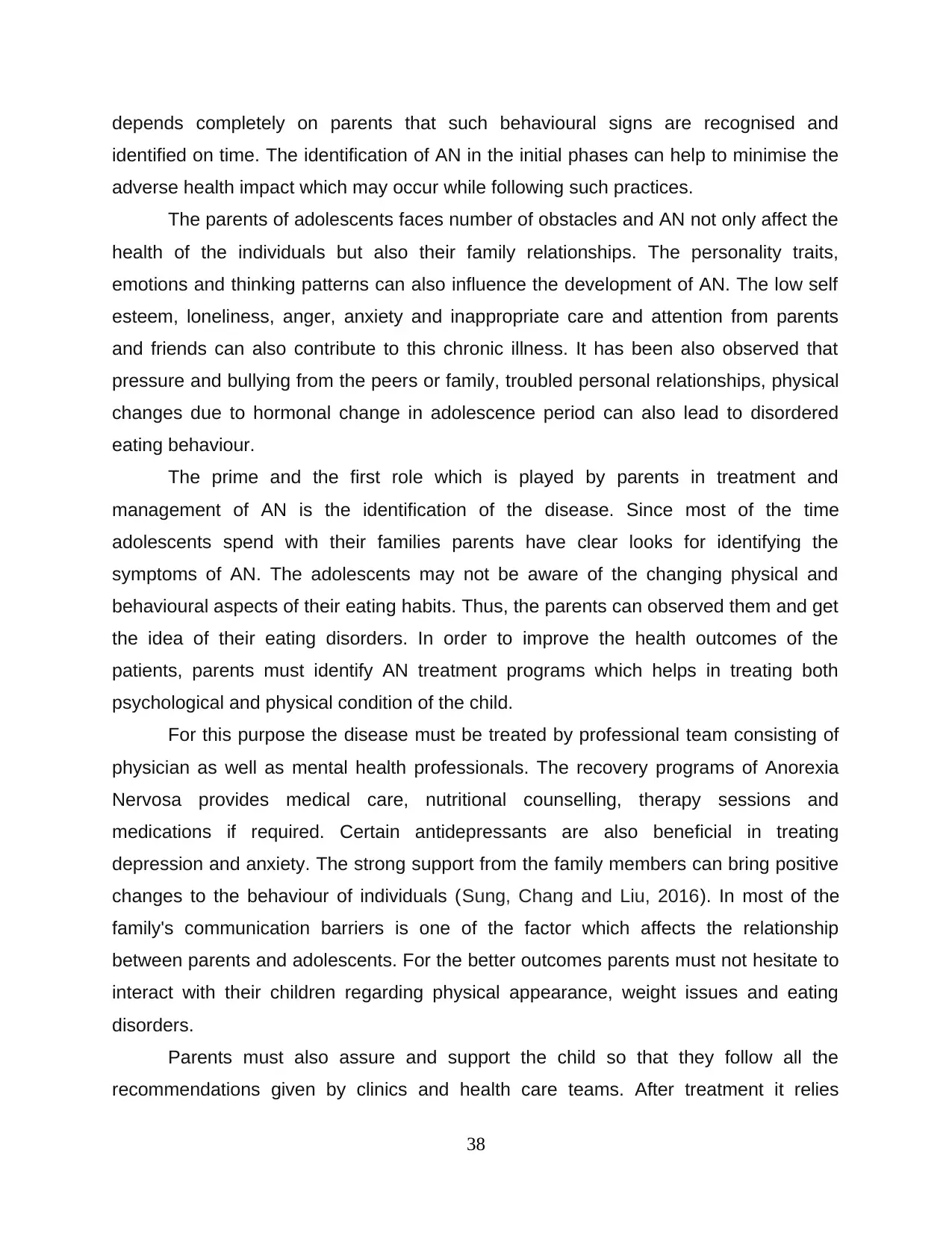
identified on time. The identification of AN in the initial phases can help to minimise the
adverse health impact which may occur while following such practices.
The parents of adolescents faces number of obstacles and AN not only affect the
health of the individuals but also their family relationships. The personality traits,
emotions and thinking patterns can also influence the development of AN. The low self
esteem, loneliness, anger, anxiety and inappropriate care and attention from parents
and friends can also contribute to this chronic illness. It has been also observed that
pressure and bullying from the peers or family, troubled personal relationships, physical
changes due to hormonal change in adolescence period can also lead to disordered
eating behaviour.
The prime and the first role which is played by parents in treatment and
management of AN is the identification of the disease. Since most of the time
adolescents spend with their families parents have clear looks for identifying the
symptoms of AN. The adolescents may not be aware of the changing physical and
behavioural aspects of their eating habits. Thus, the parents can observed them and get
the idea of their eating disorders. In order to improve the health outcomes of the
patients, parents must identify AN treatment programs which helps in treating both
psychological and physical condition of the child.
For this purpose the disease must be treated by professional team consisting of
physician as well as mental health professionals. The recovery programs of Anorexia
Nervosa provides medical care, nutritional counselling, therapy sessions and
medications if required. Certain antidepressants are also beneficial in treating
depression and anxiety. The strong support from the family members can bring positive
changes to the behaviour of individuals (Sung, Chang and Liu, 2016). In most of the
family's communication barriers is one of the factor which affects the relationship
between parents and adolescents. For the better outcomes parents must not hesitate to
interact with their children regarding physical appearance, weight issues and eating
disorders.
Parents must also assure and support the child so that they follow all the
recommendations given by clinics and health care teams. After treatment it relies
38

behaviour of the child so that post treatment complications does not trigger AN again.
When adolescents suffering from AN shows defensive response then parents must not
make criticism, shaming and judgements. It will create trust between them and patient
will find it easy to open up with parents. The interaction plays a great role in formulating
suitable interventions.
When parents identify eating disorder then they must not neglect the symptoms
instead they must use necessary steps to provide care and treatment to their
adolescent child. The feature which makes FBT as the most effective approach for AN
is that with this method parents share equal responsibility to restore the physical health
and weight of their child. The collaboration between parents and interdisciplinary teams
assist in managing eating behaviour of children in their own environment. It acts as
beneficial as support from family members has great contribution in the long term
recovery of the patients. Under FBT parents are also educated about the necessity of
confronting symptoms of eating disorder.
Parents are also encouraged to understand that they must not blame
adolescents for the illness. Thus parents must understand that instead of criticism or
blaming their child need support from them. At home parents are must interrupt
abnormal exercise or the food related habits so that adequate amount of nutrition can
be provided to children. Despite effectiveness of FBT, its time consuming nature and
practical complications may affect the outcomes. For instance many parents may have
engaged schedule and thus it can be hard or impossible for them to supervise the
nutritional intake of their child.
Further some parents also assumes that due to AN schooling must not be
suffered. Thus, for assuring that suitable food is consumed by the child in lunch or in
school (DerMarderosian and et.al., 2018). To deal with these challenges parents can
make additional efforts so that health of child can be improved. For example parents
can take permissions from their employers so that they can visit home early or can bring
their child from school for the lunch.
Though at each and every aspect of FBT family is involved but the visit to
therapist must begin with the personal and alone interaction with the adolescents. The
39
⊘ This is a preview!⊘
Do you want full access?
Subscribe today to unlock all pages.

Trusted by 1+ million students worldwide
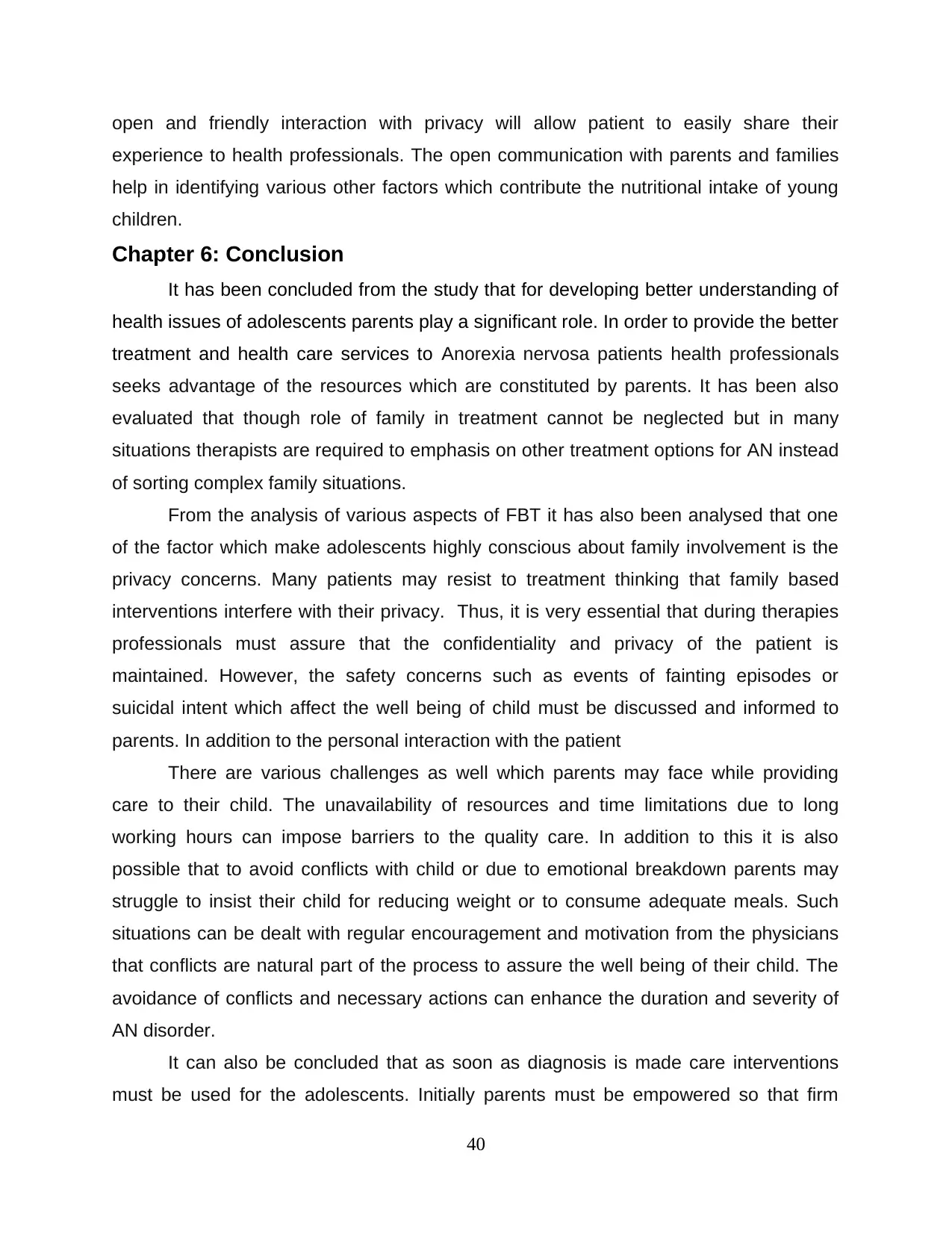
experience to health professionals. The open communication with parents and families
help in identifying various other factors which contribute the nutritional intake of young
children.
Chapter 6: Conclusion
It has been concluded from the study that for developing better understanding of
health issues of adolescents parents play a significant role. In order to provide the better
treatment and health care services to Anorexia nervosa patients health professionals
seeks advantage of the resources which are constituted by parents. It has been also
evaluated that though role of family in treatment cannot be neglected but in many
situations therapists are required to emphasis on other treatment options for AN instead
of sorting complex family situations.
From the analysis of various aspects of FBT it has also been analysed that one
of the factor which make adolescents highly conscious about family involvement is the
privacy concerns. Many patients may resist to treatment thinking that family based
interventions interfere with their privacy. Thus, it is very essential that during therapies
professionals must assure that the confidentiality and privacy of the patient is
maintained. However, the safety concerns such as events of fainting episodes or
suicidal intent which affect the well being of child must be discussed and informed to
parents. In addition to the personal interaction with the patient
There are various challenges as well which parents may face while providing
care to their child. The unavailability of resources and time limitations due to long
working hours can impose barriers to the quality care. In addition to this it is also
possible that to avoid conflicts with child or due to emotional breakdown parents may
struggle to insist their child for reducing weight or to consume adequate meals. Such
situations can be dealt with regular encouragement and motivation from the physicians
that conflicts are natural part of the process to assure the well being of their child. The
avoidance of conflicts and necessary actions can enhance the duration and severity of
AN disorder.
It can also be concluded that as soon as diagnosis is made care interventions
must be used for the adolescents. Initially parents must be empowered so that firm
40
Paraphrase This Document
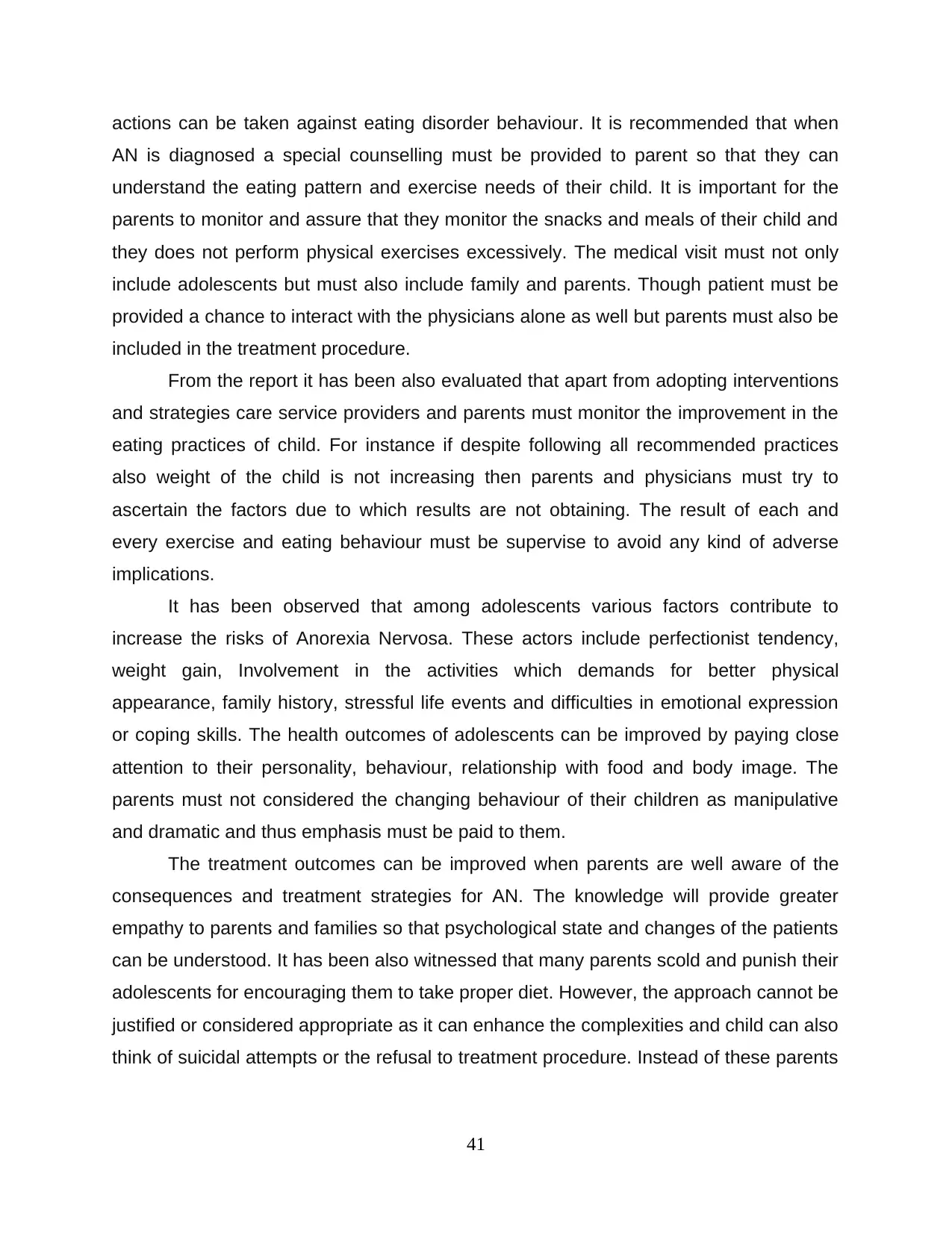
AN is diagnosed a special counselling must be provided to parent so that they can
understand the eating pattern and exercise needs of their child. It is important for the
parents to monitor and assure that they monitor the snacks and meals of their child and
they does not perform physical exercises excessively. The medical visit must not only
include adolescents but must also include family and parents. Though patient must be
provided a chance to interact with the physicians alone as well but parents must also be
included in the treatment procedure.
From the report it has been also evaluated that apart from adopting interventions
and strategies care service providers and parents must monitor the improvement in the
eating practices of child. For instance if despite following all recommended practices
also weight of the child is not increasing then parents and physicians must try to
ascertain the factors due to which results are not obtaining. The result of each and
every exercise and eating behaviour must be supervise to avoid any kind of adverse
implications.
It has been observed that among adolescents various factors contribute to
increase the risks of Anorexia Nervosa. These actors include perfectionist tendency,
weight gain, Involvement in the activities which demands for better physical
appearance, family history, stressful life events and difficulties in emotional expression
or coping skills. The health outcomes of adolescents can be improved by paying close
attention to their personality, behaviour, relationship with food and body image. The
parents must not considered the changing behaviour of their children as manipulative
and dramatic and thus emphasis must be paid to them.
The treatment outcomes can be improved when parents are well aware of the
consequences and treatment strategies for AN. The knowledge will provide greater
empathy to parents and families so that psychological state and changes of the patients
can be understood. It has been also witnessed that many parents scold and punish their
adolescents for encouraging them to take proper diet. However, the approach cannot be
justified or considered appropriate as it can enhance the complexities and child can also
think of suicidal attempts or the refusal to treatment procedure. Instead of these parents
41
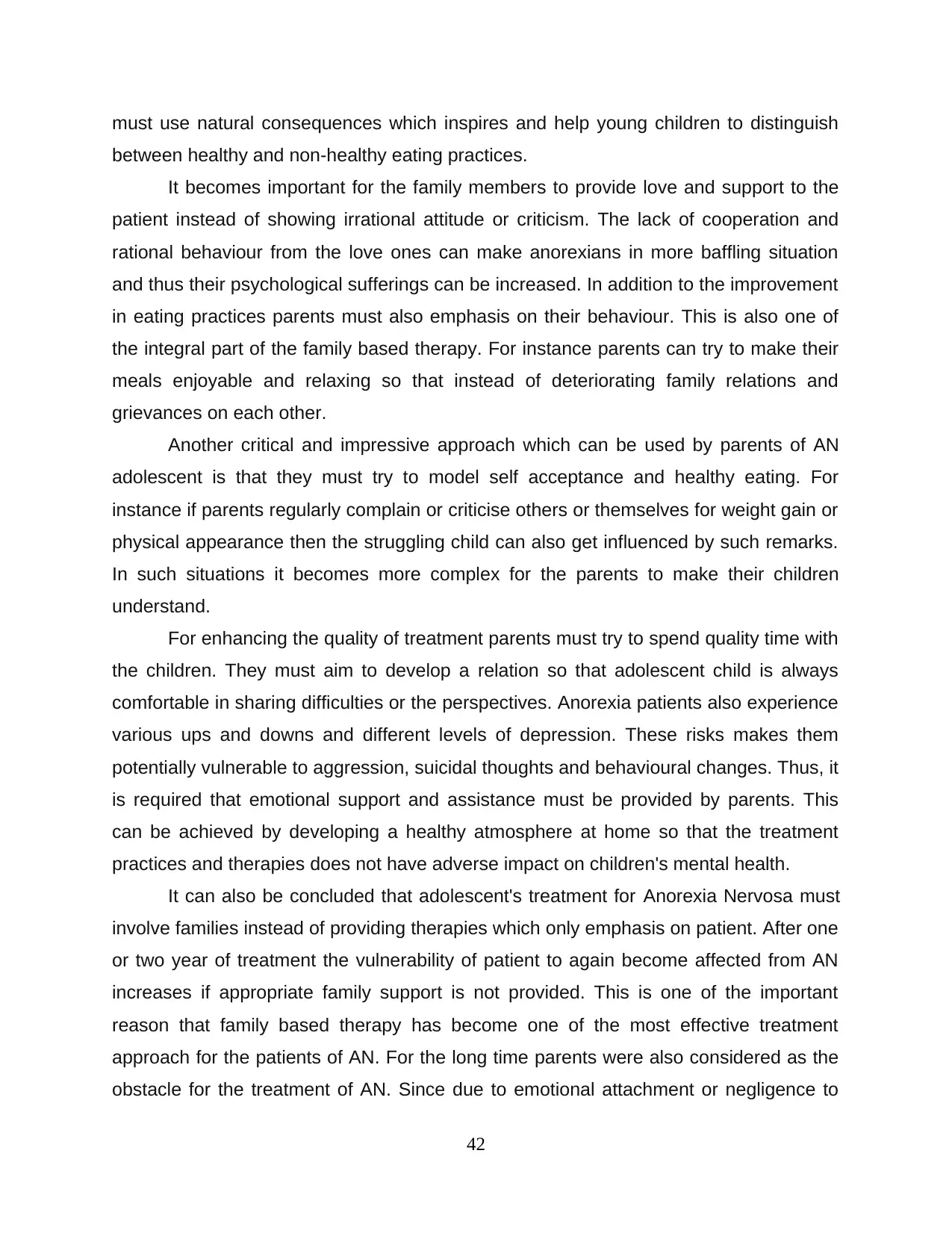
between healthy and non-healthy eating practices.
It becomes important for the family members to provide love and support to the
patient instead of showing irrational attitude or criticism. The lack of cooperation and
rational behaviour from the love ones can make anorexians in more baffling situation
and thus their psychological sufferings can be increased. In addition to the improvement
in eating practices parents must also emphasis on their behaviour. This is also one of
the integral part of the family based therapy. For instance parents can try to make their
meals enjoyable and relaxing so that instead of deteriorating family relations and
grievances on each other.
Another critical and impressive approach which can be used by parents of AN
adolescent is that they must try to model self acceptance and healthy eating. For
instance if parents regularly complain or criticise others or themselves for weight gain or
physical appearance then the struggling child can also get influenced by such remarks.
In such situations it becomes more complex for the parents to make their children
understand.
For enhancing the quality of treatment parents must try to spend quality time with
the children. They must aim to develop a relation so that adolescent child is always
comfortable in sharing difficulties or the perspectives. Anorexia patients also experience
various ups and downs and different levels of depression. These risks makes them
potentially vulnerable to aggression, suicidal thoughts and behavioural changes. Thus, it
is required that emotional support and assistance must be provided by parents. This
can be achieved by developing a healthy atmosphere at home so that the treatment
practices and therapies does not have adverse impact on children's mental health.
It can also be concluded that adolescent's treatment for Anorexia Nervosa must
involve families instead of providing therapies which only emphasis on patient. After one
or two year of treatment the vulnerability of patient to again become affected from AN
increases if appropriate family support is not provided. This is one of the important
reason that family based therapy has become one of the most effective treatment
approach for the patients of AN. For the long time parents were also considered as the
obstacle for the treatment of AN. Since due to emotional attachment or negligence to
42
⊘ This is a preview!⊘
Do you want full access?
Subscribe today to unlock all pages.

Trusted by 1+ million students worldwide
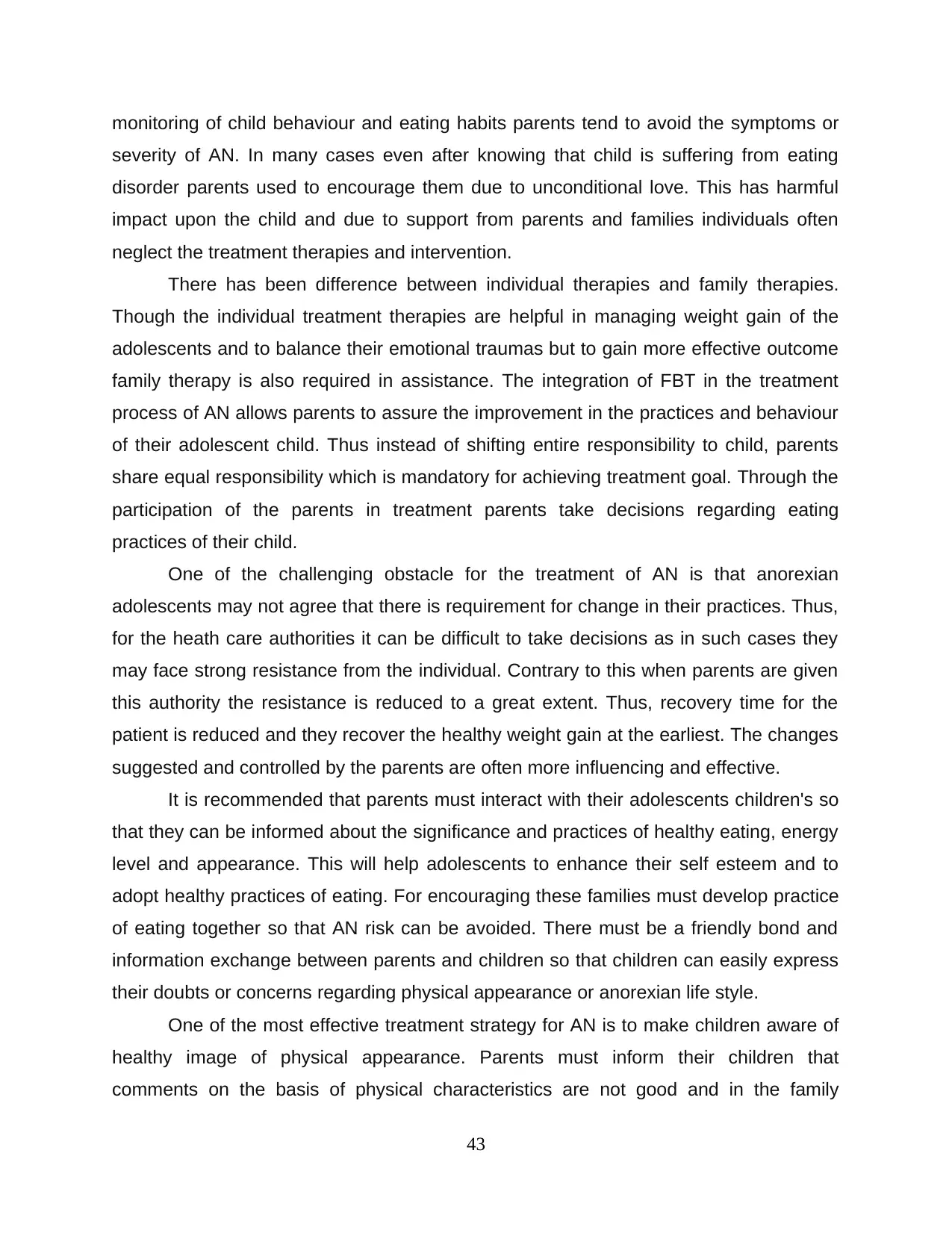
severity of AN. In many cases even after knowing that child is suffering from eating
disorder parents used to encourage them due to unconditional love. This has harmful
impact upon the child and due to support from parents and families individuals often
neglect the treatment therapies and intervention.
There has been difference between individual therapies and family therapies.
Though the individual treatment therapies are helpful in managing weight gain of the
adolescents and to balance their emotional traumas but to gain more effective outcome
family therapy is also required in assistance. The integration of FBT in the treatment
process of AN allows parents to assure the improvement in the practices and behaviour
of their adolescent child. Thus instead of shifting entire responsibility to child, parents
share equal responsibility which is mandatory for achieving treatment goal. Through the
participation of the parents in treatment parents take decisions regarding eating
practices of their child.
One of the challenging obstacle for the treatment of AN is that anorexian
adolescents may not agree that there is requirement for change in their practices. Thus,
for the heath care authorities it can be difficult to take decisions as in such cases they
may face strong resistance from the individual. Contrary to this when parents are given
this authority the resistance is reduced to a great extent. Thus, recovery time for the
patient is reduced and they recover the healthy weight gain at the earliest. The changes
suggested and controlled by the parents are often more influencing and effective.
It is recommended that parents must interact with their adolescents children's so
that they can be informed about the significance and practices of healthy eating, energy
level and appearance. This will help adolescents to enhance their self esteem and to
adopt healthy practices of eating. For encouraging these families must develop practice
of eating together so that AN risk can be avoided. There must be a friendly bond and
information exchange between parents and children so that children can easily express
their doubts or concerns regarding physical appearance or anorexian life style.
One of the most effective treatment strategy for AN is to make children aware of
healthy image of physical appearance. Parents must inform their children that
comments on the basis of physical characteristics are not good and in the family
43
Paraphrase This Document
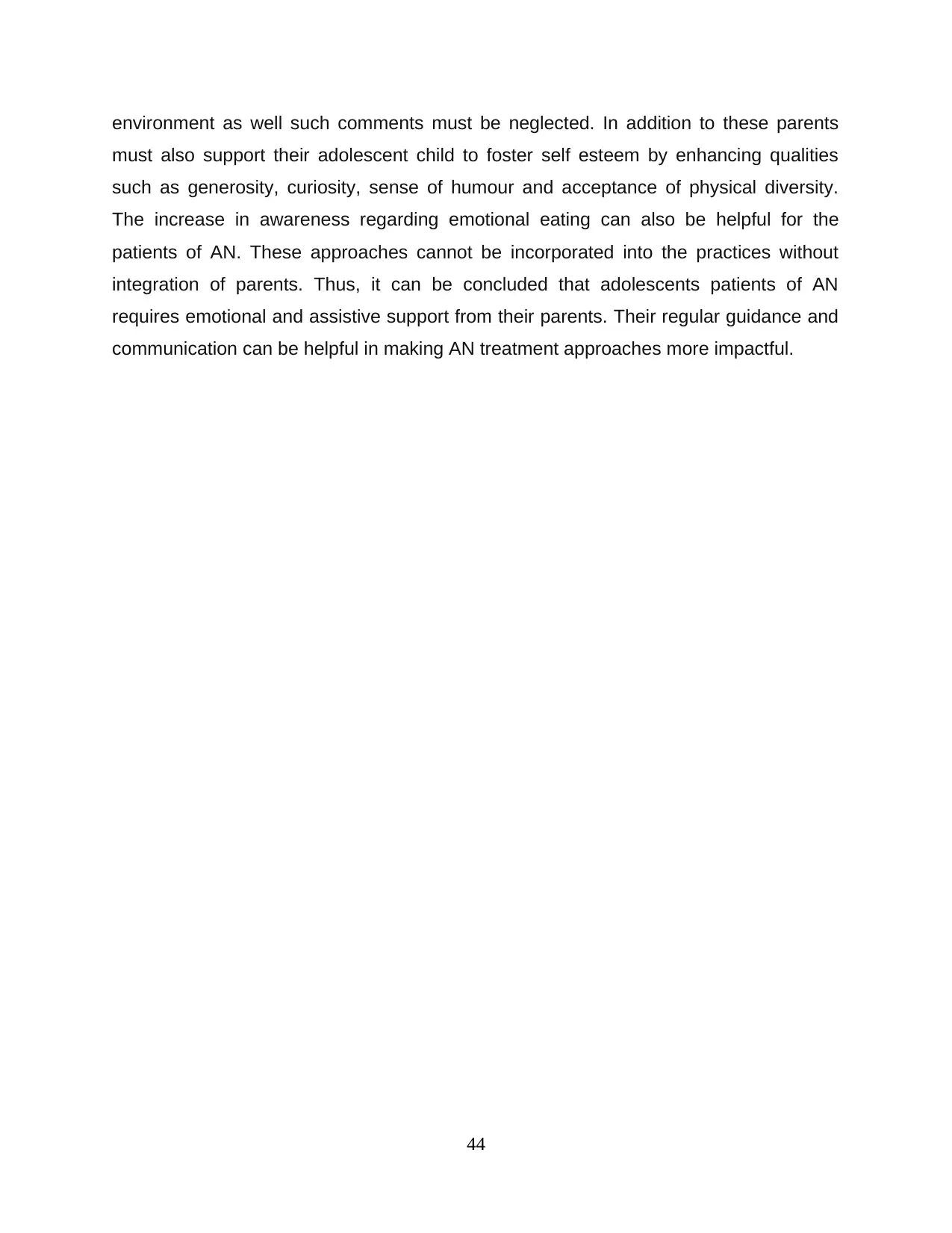
must also support their adolescent child to foster self esteem by enhancing qualities
such as generosity, curiosity, sense of humour and acceptance of physical diversity.
The increase in awareness regarding emotional eating can also be helpful for the
patients of AN. These approaches cannot be incorporated into the practices without
integration of parents. Thus, it can be concluded that adolescents patients of AN
requires emotional and assistive support from their parents. Their regular guidance and
communication can be helpful in making AN treatment approaches more impactful.
44
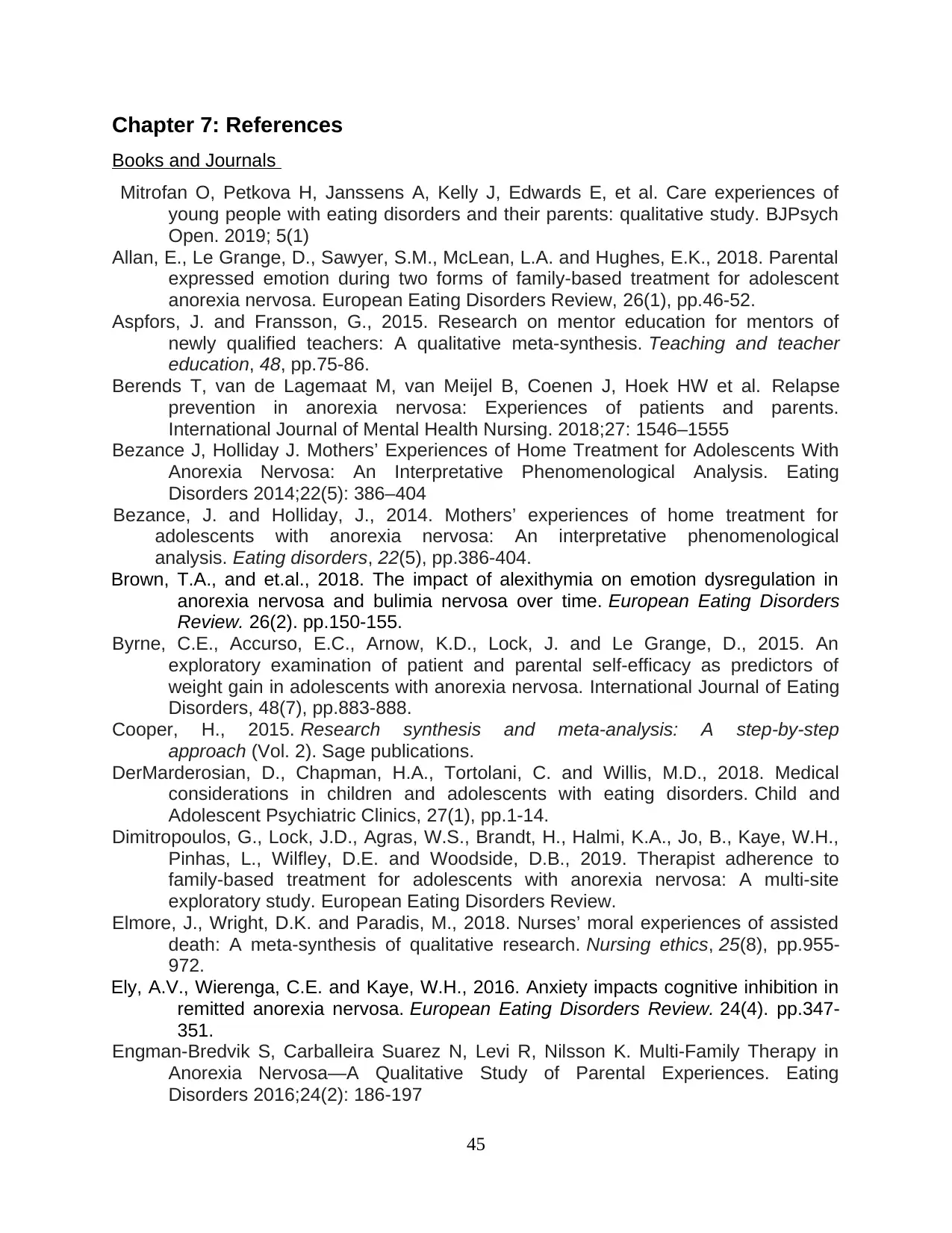
Books and Journals
Mitrofan O, Petkova H, Janssens A, Kelly J, Edwards E, et al. Care experiences of
young people with eating disorders and their parents: qualitative study. BJPsych
Open. 2019; 5(1)
Allan, E., Le Grange, D., Sawyer, S.M., McLean, L.A. and Hughes, E.K., 2018. Parental
expressed emotion during two forms of family‐based treatment for adolescent
anorexia nervosa. European Eating Disorders Review, 26(1), pp.46-52.
Aspfors, J. and Fransson, G., 2015. Research on mentor education for mentors of
newly qualified teachers: A qualitative meta-synthesis. Teaching and teacher
education, 48, pp.75-86.
Berends T, van de Lagemaat M, van Meijel B, Coenen J, Hoek HW et al. Relapse
prevention in anorexia nervosa: Experiences of patients and parents.
International Journal of Mental Health Nursing. 2018;27: 1546–1555
Bezance J, Holliday J. Mothers’ Experiences of Home Treatment for Adolescents With
Anorexia Nervosa: An Interpretative Phenomenological Analysis. Eating
Disorders 2014;22(5): 386–404
Bezance, J. and Holliday, J., 2014. Mothers’ experiences of home treatment for
adolescents with anorexia nervosa: An interpretative phenomenological
analysis. Eating disorders, 22(5), pp.386-404.
Brown, T.A., and et.al., 2018. The impact of alexithymia on emotion dysregulation in
anorexia nervosa and bulimia nervosa over time. European Eating Disorders
Review. 26(2). pp.150-155.
Byrne, C.E., Accurso, E.C., Arnow, K.D., Lock, J. and Le Grange, D., 2015. An
exploratory examination of patient and parental self‐efficacy as predictors of
weight gain in adolescents with anorexia nervosa. International Journal of Eating
Disorders, 48(7), pp.883-888.
Cooper, H., 2015. Research synthesis and meta-analysis: A step-by-step
approach (Vol. 2). Sage publications.
DerMarderosian, D., Chapman, H.A., Tortolani, C. and Willis, M.D., 2018. Medical
considerations in children and adolescents with eating disorders. Child and
Adolescent Psychiatric Clinics, 27(1), pp.1-14.
Dimitropoulos, G., Lock, J.D., Agras, W.S., Brandt, H., Halmi, K.A., Jo, B., Kaye, W.H.,
Pinhas, L., Wilfley, D.E. and Woodside, D.B., 2019. Therapist adherence to
family‐based treatment for adolescents with anorexia nervosa: A multi‐site
exploratory study. European Eating Disorders Review.
Elmore, J., Wright, D.K. and Paradis, M., 2018. Nurses’ moral experiences of assisted
death: A meta-synthesis of qualitative research. Nursing ethics, 25(8), pp.955-
972.
Ely, A.V., Wierenga, C.E. and Kaye, W.H., 2016. Anxiety impacts cognitive inhibition in
remitted anorexia nervosa. European Eating Disorders Review. 24(4). pp.347-
351.
Engman-Bredvik S, Carballeira Suarez N, Levi R, Nilsson K. Multi-Family Therapy in
Anorexia Nervosa—A Qualitative Study of Parental Experiences. Eating
Disorders 2016;24(2): 186-197
45
⊘ This is a preview!⊘
Do you want full access?
Subscribe today to unlock all pages.

Trusted by 1+ million students worldwide
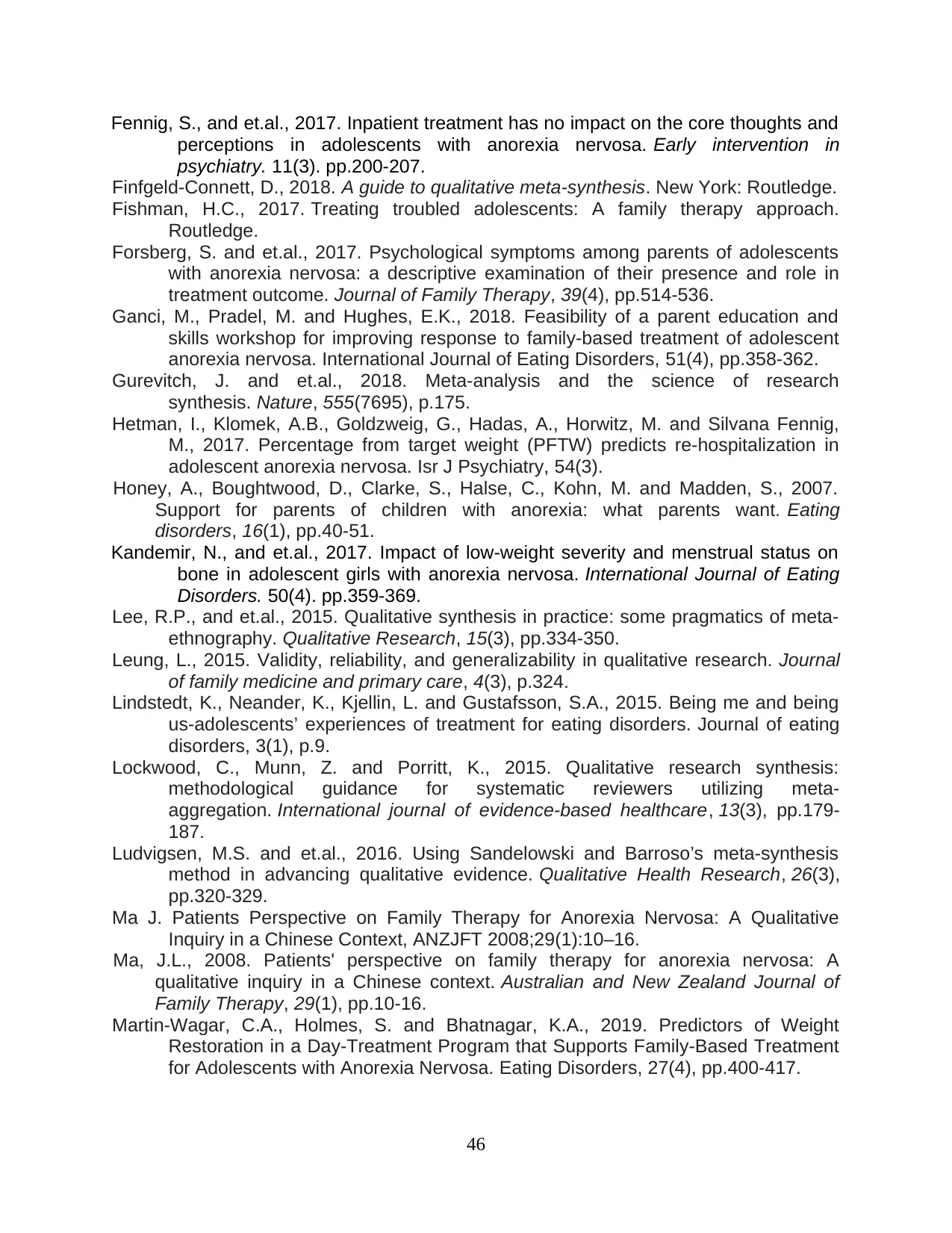
perceptions in adolescents with anorexia nervosa. Early intervention in
psychiatry. 11(3). pp.200-207.
Finfgeld-Connett, D., 2018. A guide to qualitative meta-synthesis. New York: Routledge.
Fishman, H.C., 2017. Treating troubled adolescents: A family therapy approach.
Routledge.
Forsberg, S. and et.al., 2017. Psychological symptoms among parents of adolescents
with anorexia nervosa: a descriptive examination of their presence and role in
treatment outcome. Journal of Family Therapy, 39(4), pp.514-536.
Ganci, M., Pradel, M. and Hughes, E.K., 2018. Feasibility of a parent education and
skills workshop for improving response to family‐based treatment of adolescent
anorexia nervosa. International Journal of Eating Disorders, 51(4), pp.358-362.
Gurevitch, J. and et.al., 2018. Meta-analysis and the science of research
synthesis. Nature, 555(7695), p.175.
Hetman, I., Klomek, A.B., Goldzweig, G., Hadas, A., Horwitz, M. and Silvana Fennig,
M., 2017. Percentage from target weight (PFTW) predicts re-hospitalization in
adolescent anorexia nervosa. Isr J Psychiatry, 54(3).
Honey, A., Boughtwood, D., Clarke, S., Halse, C., Kohn, M. and Madden, S., 2007.
Support for parents of children with anorexia: what parents want. Eating
disorders, 16(1), pp.40-51.
Kandemir, N., and et.al., 2017. Impact of low‐weight severity and menstrual status on
bone in adolescent girls with anorexia nervosa. International Journal of Eating
Disorders. 50(4). pp.359-369.
Lee, R.P., and et.al., 2015. Qualitative synthesis in practice: some pragmatics of meta-
ethnography. Qualitative Research, 15(3), pp.334-350.
Leung, L., 2015. Validity, reliability, and generalizability in qualitative research. Journal
of family medicine and primary care, 4(3), p.324.
Lindstedt, K., Neander, K., Kjellin, L. and Gustafsson, S.A., 2015. Being me and being
us-adolescents’ experiences of treatment for eating disorders. Journal of eating
disorders, 3(1), p.9.
Lockwood, C., Munn, Z. and Porritt, K., 2015. Qualitative research synthesis:
methodological guidance for systematic reviewers utilizing meta-
aggregation. International journal of evidence-based healthcare, 13(3), pp.179-
187.
Ludvigsen, M.S. and et.al., 2016. Using Sandelowski and Barroso’s meta-synthesis
method in advancing qualitative evidence. Qualitative Health Research, 26(3),
pp.320-329.
Ma J. Patients Perspective on Family Therapy for Anorexia Nervosa: A Qualitative
Inquiry in a Chinese Context, ANZJFT 2008;29(1):10–16.
Ma, J.L., 2008. Patients' perspective on family therapy for anorexia nervosa: A
qualitative inquiry in a Chinese context. Australian and New Zealand Journal of
Family Therapy, 29(1), pp.10-16.
Martin-Wagar, C.A., Holmes, S. and Bhatnagar, K.A., 2019. Predictors of Weight
Restoration in a Day-Treatment Program that Supports Family-Based Treatment
for Adolescents with Anorexia Nervosa. Eating Disorders, 27(4), pp.400-417.
46
Paraphrase This Document
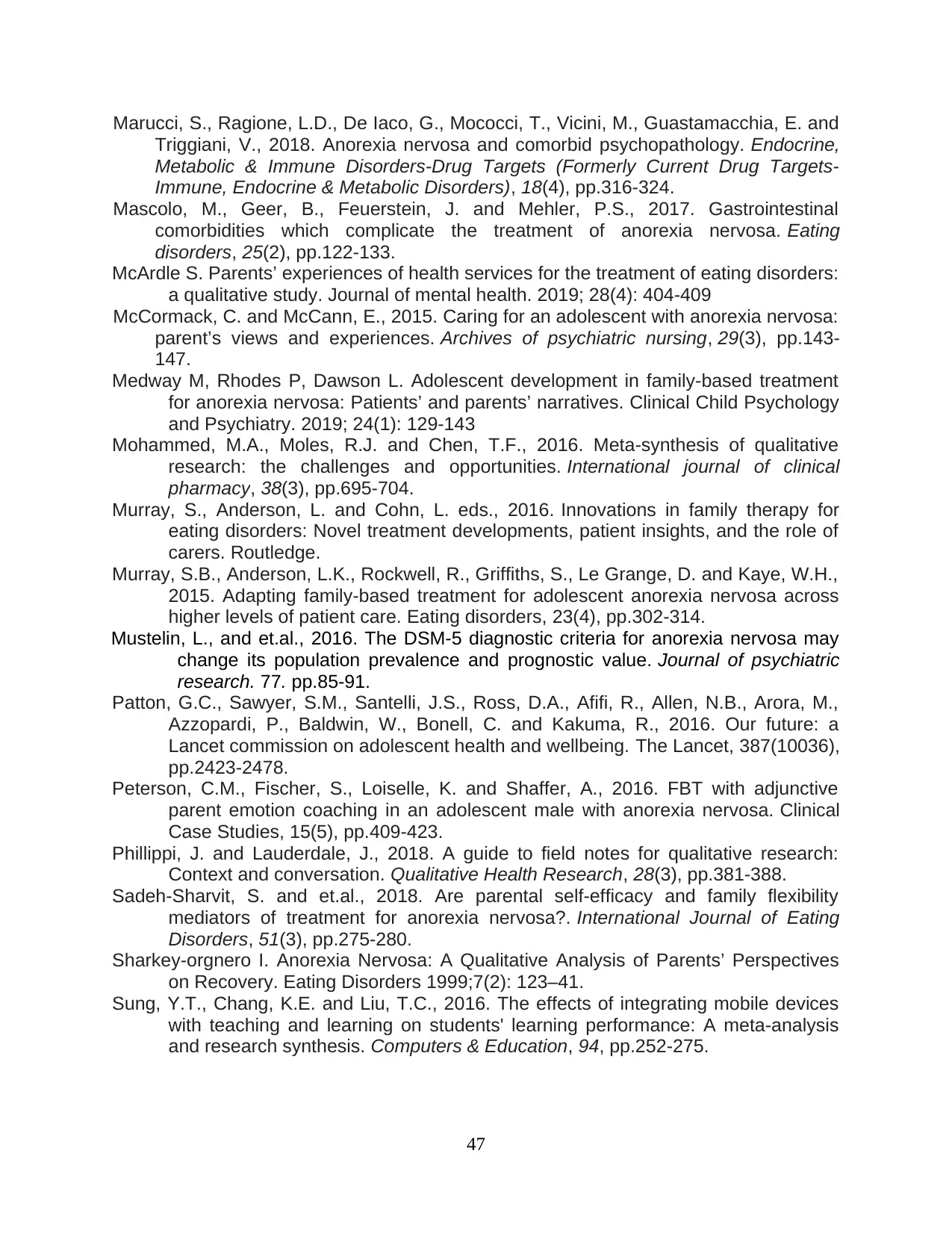
Triggiani, V., 2018. Anorexia nervosa and comorbid psychopathology. Endocrine,
Metabolic & Immune Disorders-Drug Targets (Formerly Current Drug Targets-
Immune, Endocrine & Metabolic Disorders), 18(4), pp.316-324.
Mascolo, M., Geer, B., Feuerstein, J. and Mehler, P.S., 2017. Gastrointestinal
comorbidities which complicate the treatment of anorexia nervosa. Eating
disorders, 25(2), pp.122-133.
McArdle S. Parents’ experiences of health services for the treatment of eating disorders:
a qualitative study. Journal of mental health. 2019; 28(4): 404-409
McCormack, C. and McCann, E., 2015. Caring for an adolescent with anorexia nervosa:
parent’s views and experiences. Archives of psychiatric nursing, 29(3), pp.143-
147.
Medway M, Rhodes P, Dawson L. Adolescent development in family-based treatment
for anorexia nervosa: Patients’ and parents’ narratives. Clinical Child Psychology
and Psychiatry. 2019; 24(1): 129-143
Mohammed, M.A., Moles, R.J. and Chen, T.F., 2016. Meta-synthesis of qualitative
research: the challenges and opportunities. International journal of clinical
pharmacy, 38(3), pp.695-704.
Murray, S., Anderson, L. and Cohn, L. eds., 2016. Innovations in family therapy for
eating disorders: Novel treatment developments, patient insights, and the role of
carers. Routledge.
Murray, S.B., Anderson, L.K., Rockwell, R., Griffiths, S., Le Grange, D. and Kaye, W.H.,
2015. Adapting family-based treatment for adolescent anorexia nervosa across
higher levels of patient care. Eating disorders, 23(4), pp.302-314.
Mustelin, L., and et.al., 2016. The DSM-5 diagnostic criteria for anorexia nervosa may
change its population prevalence and prognostic value. Journal of psychiatric
research. 77. pp.85-91.
Patton, G.C., Sawyer, S.M., Santelli, J.S., Ross, D.A., Afifi, R., Allen, N.B., Arora, M.,
Azzopardi, P., Baldwin, W., Bonell, C. and Kakuma, R., 2016. Our future: a
Lancet commission on adolescent health and wellbeing. The Lancet, 387(10036),
pp.2423-2478.
Peterson, C.M., Fischer, S., Loiselle, K. and Shaffer, A., 2016. FBT with adjunctive
parent emotion coaching in an adolescent male with anorexia nervosa. Clinical
Case Studies, 15(5), pp.409-423.
Phillippi, J. and Lauderdale, J., 2018. A guide to field notes for qualitative research:
Context and conversation. Qualitative Health Research, 28(3), pp.381-388.
Sadeh‐Sharvit, S. and et.al., 2018. Are parental self‐efficacy and family flexibility
mediators of treatment for anorexia nervosa?. International Journal of Eating
Disorders, 51(3), pp.275-280.
Sharkey-orgnero I. Anorexia Nervosa: A Qualitative Analysis of Parents’ Perspectives
on Recovery. Eating Disorders 1999;7(2): 123–41.
Sung, Y.T., Chang, K.E. and Liu, T.C., 2016. The effects of integrating mobile devices
with teaching and learning on students' learning performance: A meta-analysis
and research synthesis. Computers & Education, 94, pp.252-275.
47
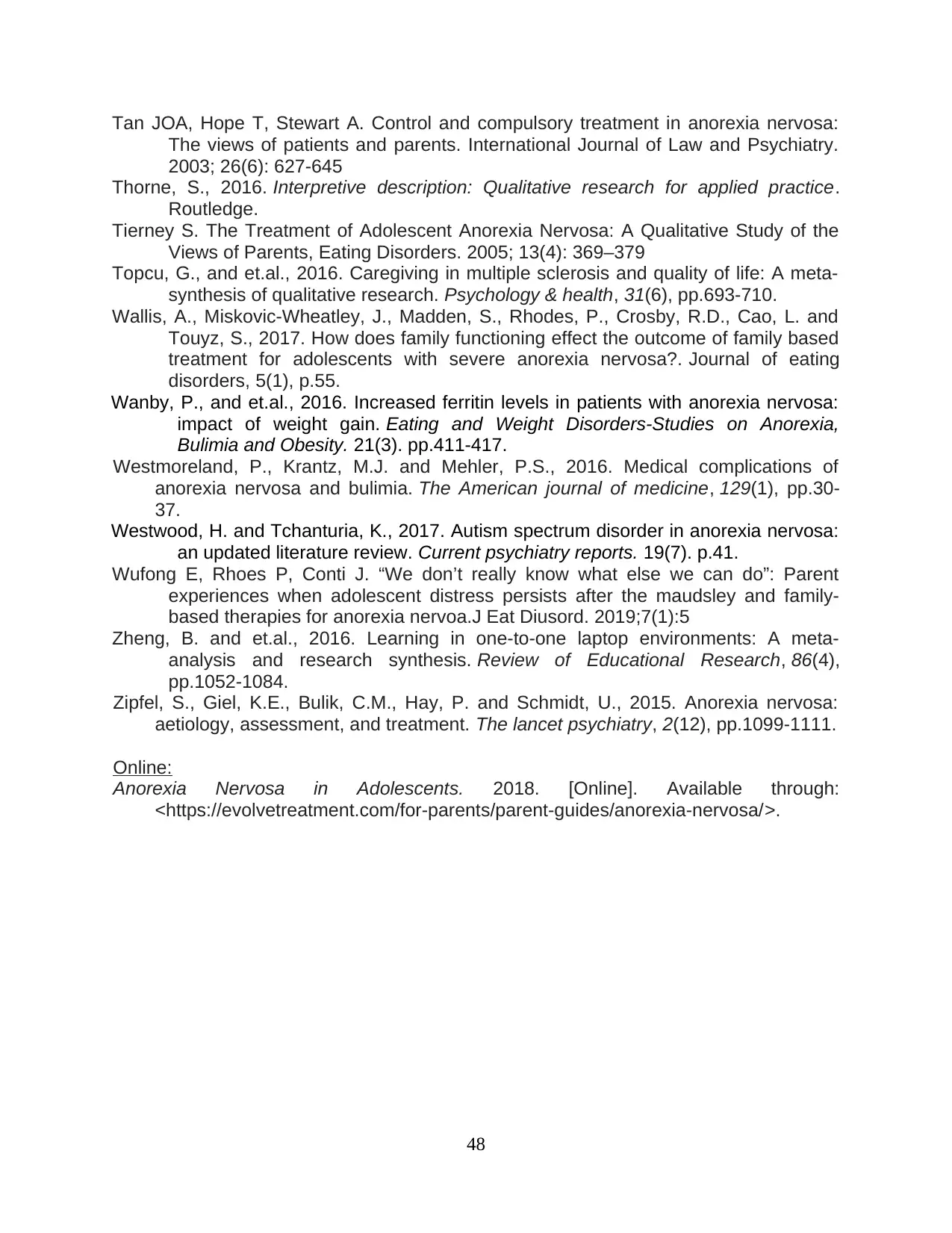
The views of patients and parents. International Journal of Law and Psychiatry.
2003; 26(6): 627-645
Thorne, S., 2016. Interpretive description: Qualitative research for applied practice.
Routledge.
Tierney S. The Treatment of Adolescent Anorexia Nervosa: A Qualitative Study of the
Views of Parents, Eating Disorders. 2005; 13(4): 369–379
Topcu, G., and et.al., 2016. Caregiving in multiple sclerosis and quality of life: A meta-
synthesis of qualitative research. Psychology & health, 31(6), pp.693-710.
Wallis, A., Miskovic-Wheatley, J., Madden, S., Rhodes, P., Crosby, R.D., Cao, L. and
Touyz, S., 2017. How does family functioning effect the outcome of family based
treatment for adolescents with severe anorexia nervosa?. Journal of eating
disorders, 5(1), p.55.
Wanby, P., and et.al., 2016. Increased ferritin levels in patients with anorexia nervosa:
impact of weight gain. Eating and Weight Disorders-Studies on Anorexia,
Bulimia and Obesity. 21(3). pp.411-417.
Westmoreland, P., Krantz, M.J. and Mehler, P.S., 2016. Medical complications of
anorexia nervosa and bulimia. The American journal of medicine, 129(1), pp.30-
37.
Westwood, H. and Tchanturia, K., 2017. Autism spectrum disorder in anorexia nervosa:
an updated literature review. Current psychiatry reports. 19(7). p.41.
Wufong E, Rhoes P, Conti J. “We don’t really know what else we can do”: Parent
experiences when adolescent distress persists after the maudsley and family-
based therapies for anorexia nervoa.J Eat Diusord. 2019;7(1):5
Zheng, B. and et.al., 2016. Learning in one-to-one laptop environments: A meta-
analysis and research synthesis. Review of Educational Research, 86(4),
pp.1052-1084.
Zipfel, S., Giel, K.E., Bulik, C.M., Hay, P. and Schmidt, U., 2015. Anorexia nervosa:
aetiology, assessment, and treatment. The lancet psychiatry, 2(12), pp.1099-1111.
Online:
Anorexia Nervosa in Adolescents. 2018. [Online]. Available through:
<https://evolvetreatment.com/for-parents/parent-guides/anorexia-nervosa/>.
48
⊘ This is a preview!⊘
Do you want full access?
Subscribe today to unlock all pages.

Trusted by 1+ million students worldwide

Paraphrase This Document


⊘ This is a preview!⊘
Do you want full access?
Subscribe today to unlock all pages.

Trusted by 1+ million students worldwide

Paraphrase This Document

Related Documents
Your All-in-One AI-Powered Toolkit for Academic Success.
+13062052269
info@desklib.com
Available 24*7 on WhatsApp / Email
![[object Object]](/_next/static/media/star-bottom.7253800d.svg)
© 2024 | Zucol Services PVT LTD | All rights reserved.





